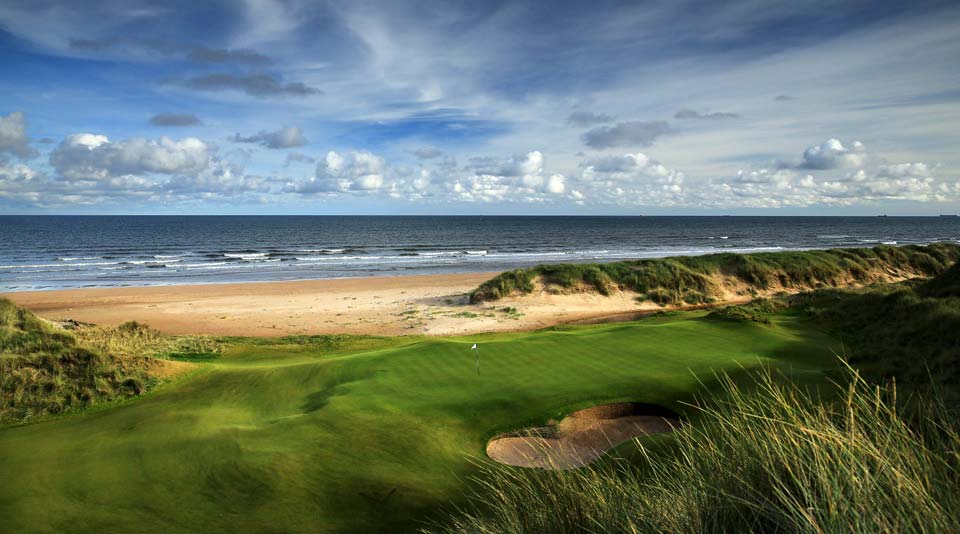
Top 100 Courses in the World, 2020-21: GOLF’s raters name the best of the best
Our expert course raters sized up the best golf courses on the planet to rank GOLF’s Top 100 Courses in the World for 2020-21. There are plenty of familiar names on this year’s list of Top 100 Courses in the World. But it’s good to have some new blood too, right? Our brand-new list features 11 courses that jumped inside this year’s Top 100, reflecting changing trends and a revamped ranking.
Methodology: How we rate our courses |Meet our expert panelists
Photo above of Tara Iti (No. 27) by Joann Dost.
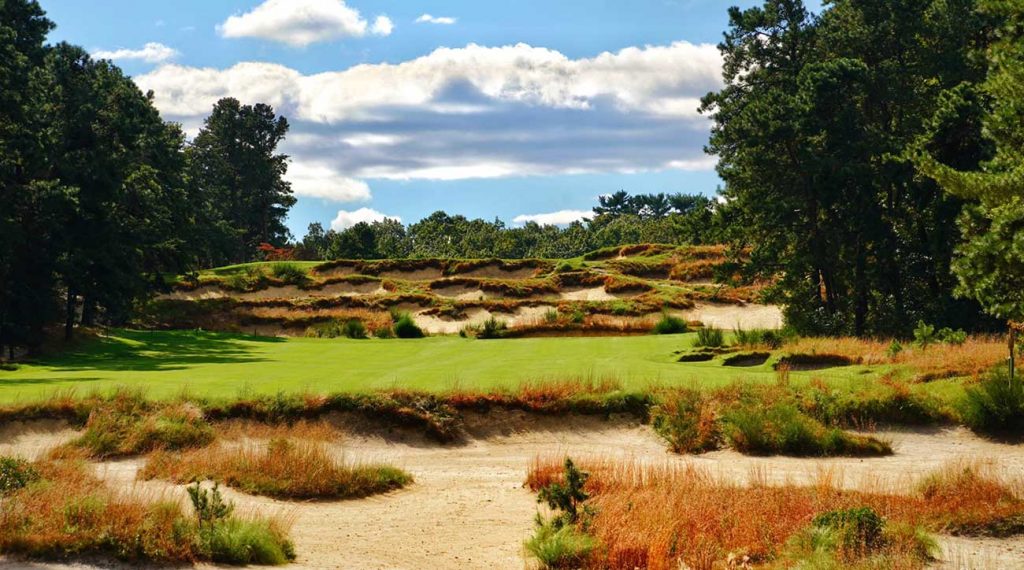
1. Pine Valley
Analyzing a golf course need not be complicated. One simple but effective way to judge a design is by the quality of the course’s property, its hazards and greens. Pine Valley excels at all three, with many contending it has the most formidable hazards and sophisticated green complexes in golf. Throw in a wonderful routing that hopscotches from one island of turf to the next across the rolling, sandy landscape and you have a course that hasn’t budged from the No. 1 spot for decades, meaning Pine Valley’s only benchmark is itself. (Photo: Jon Cavalier)
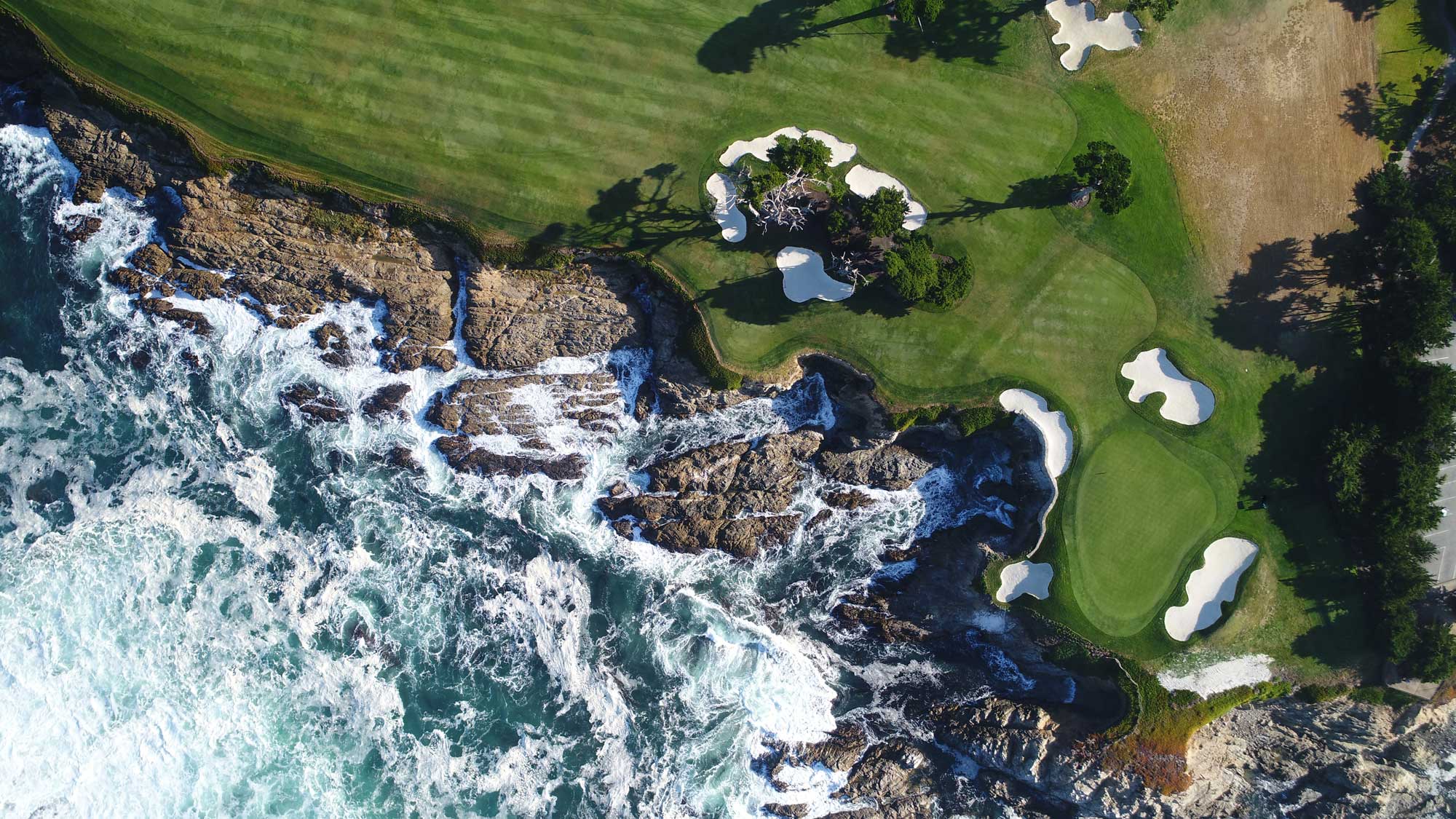
2. Cypress Point
It’s almost inconceivable that land this stunning was made available for golf. For the lucky few who get to play here, they enjoy one of the game’s most inspiring walks as Alister MacKenzie’s design effortlessly transports the player around the diverse property. The iconic par-3 16th, which extends into the churning Pacific, is the game’s most dramatic and photographed hole, but there are endless other highlights, from the forested portion to heaving dunes to its famed jagged coastline. MacKenzie extracted the best from the land in part by breaking the “rules” and having back-to-back par-5s on the front and back-to-back par-3s on the back. The drivable ½-par 9th is another standout with its angled green toward play. (Photo: Gary Lisbon)

3. St. Andrews (Old Course)
The birthplace of golf features blind bunkers, huge double greens, quirks such as the Road Hole and Hell Bunker and strategic options that vary with the day’s wind. The emphasis on short grass and variety became the foundation for strategic designs that followed, including Augusta National. The Old Course might well possess the fastest, best turf in the sport (despite, or perhaps because of, its constant use) and no design possesses the flexibility in allowing golfers of all ages and abilities to enjoy themselves as a group. Modern architects, take note! (Photo: David Cannon/Getty Images)
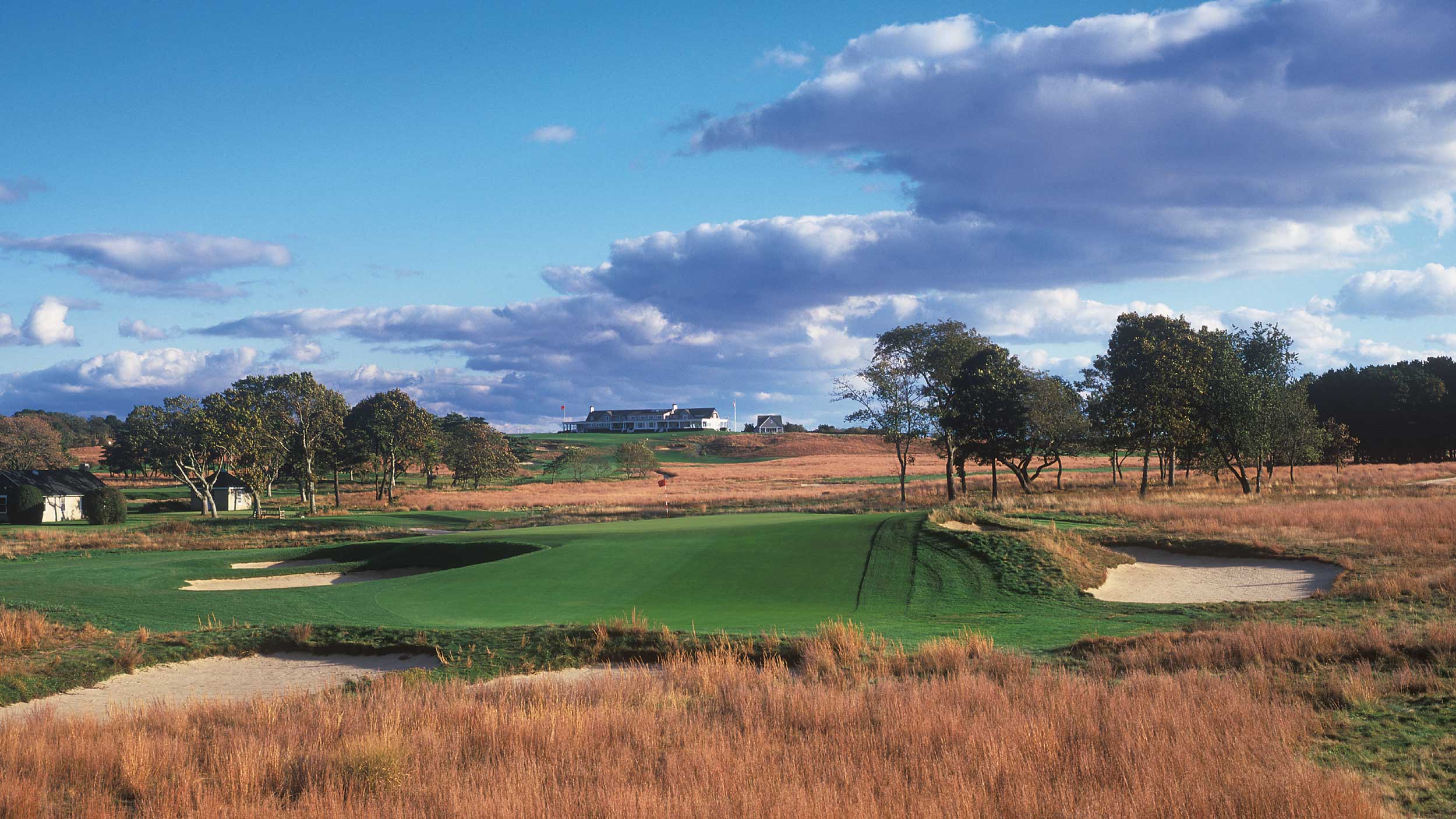
4. Shinnecock Hills
Venue for five U.S. Opens since 1986, most recently in 2018, this is William Flynn’s design masterpiece. Apart from being handed a magnificently spacious piece of land upon which to work, Flynn was given something else nearly as valuable: time. Work started in 1928 and the course didn’t open until 1931. True, the Great Depression began during construction but the grace with which the holes flow across the property is a tribute to the hands-on, slow-build process. (Photo: Joann Dost)

5. National Golf Links of America
NGLA, or “National,” as it’s known, brought Seth Raynor and C.B. Macdonald together for the first time and what they created still stands as a marvel of strategic design. Some of its template holes, including the Alps 3rd, the Redan 4th, the Short 6th and the Leven 17th, are arguably superior to their namesake holes in the United Kingdom that Macdonald copied. Legendary golf writer Bernard Darwin summed it up nicely when he opined, “The National Links is a truly great course; even as I write I feel my allegiance to Westward Ho!, to Hoylake, to St. Andrews tottering to its fall.” (Photo: William Tyler Smith)
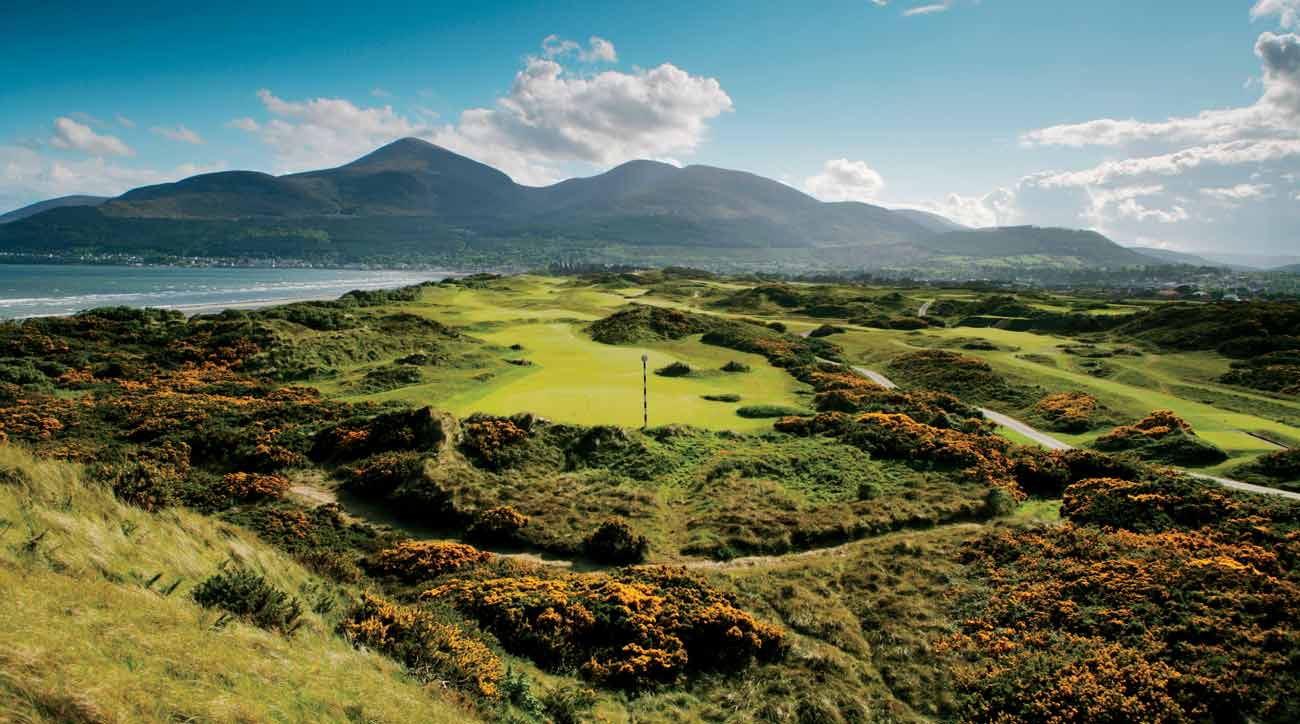
6. Royal County Down
The evolution over more than 130 years of this design is fascinating and has yielded what many consider to be the game’s finest front nine. Blind tee shots abound, in brilliant fashion at such holes as 2, 5 and 9. On the back side, one feature that was recently expunged was a natural pond 100 yards shy of the 17th green. Member George Combe deserves much of the credit for RCD as he shepherded the course through the transition to the rubber core Haskell ball 120 years ago. Forty percent of the World top 15 (here, Pine Valley, Oakmont, Royal Dornoch, Pebble Beach and Merion) derived much of their substance from individuals who built few other courses. Such designs enjoy their own unique voices with County Down further blessed with staggeringly handsome long views of the Irish Sea, the Mountains of Mourne and the red-brick steeple of the Slieve Donard Hotel. (Photo: Getty Images)
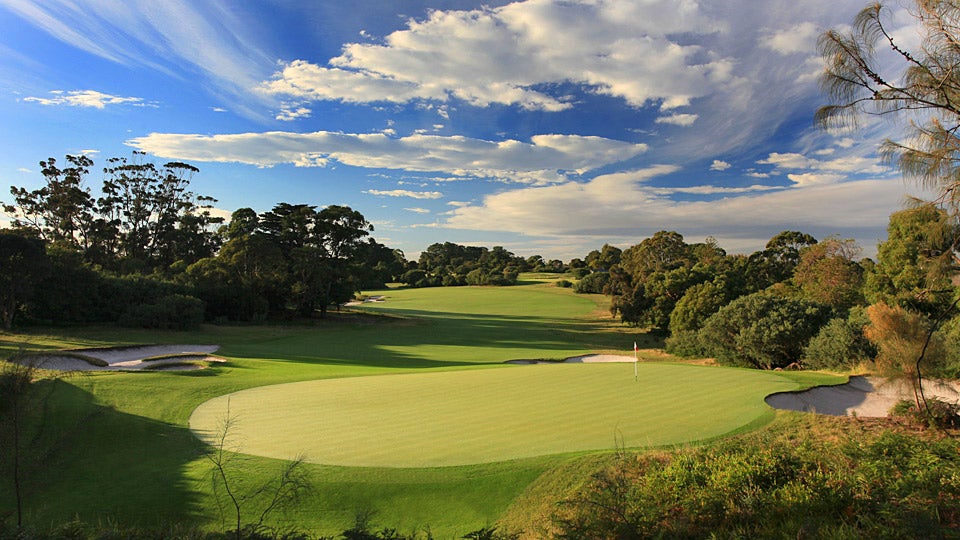
7. Royal Melbourne (West)
The immense appeal of Alister MacKenzie’s Golden Age masterwork is captured by former world No. 1 Nick Faldo: “I love the way it plays firm and fast-running, the way the bunkering frames and almost intrudes into the putting surfaces and the brilliance of the bunkering style with the native scrubby look. I’m also a fan of the often very wide fairways that reward positioning and of the mix of long and short par-4s. Add to this the splendid contouring of the greens and the rich variety of approach shots that you play into those greens.” Sir Nick said it all. (Photo: Gary Lisbon)

8. Oakmont
No course thrives more on looking mean. Indeed, the beauty of Oakmont is how it doesn’t doll itself up, and yet to a purist the view from the crest of the hill on 15 is as breathtaking as any in the country. The barren landscape possesses few trees and no water, just drainage ditches that traverse the land. Daunting carries aren’t the issue either and the greens are huge, so what’s the big deal? The question is answered at the 1st, with a green that follows the natural contours and slopes away from the player. The club prides itself on the pace and firmness of its world-renowned putting surfaces, so let the beating commence! For a course known for its difficulty, what gets lost in the shuffle is the brilliance of its quartet of short par-4s at 2, 11, 14 and 17. (Photo: Gary Lisbon)

9. Augusta National
Augusta National is the vision of Bobby Jones and his chosen architect, Alister MacKenzie. Both intended for Augusta National to reflect the spirit and strategic options of the Old Course at St. Andrews, the course that they admired most. Nearly every hole at St. Andrews and Augusta National provides a safe route to the green and also a riskier one. The removal of trees down the right of 11 prior to the 2022 Masters was met with applause by design aficionados who hope that the club continues to restore width and playing angles. (Photo: Joann Dost)

10. Royal Dornoch (Championship)
After Tom Watson played here before his Open defense in 1981, he remarked that the experience was “the most fun I’ve ever had on a golf course.” Donald Ross grew up here, though Dornoch took its final shape as we know it today well after he left. Indeed, the course is similar to Oakmont, Pinehurst No. 2 and NGLA in the sense that one man’s steady hand (in this case John Sutherland) elevated the course over a period of several decades. (Photo: David Cannon/Getty Images)
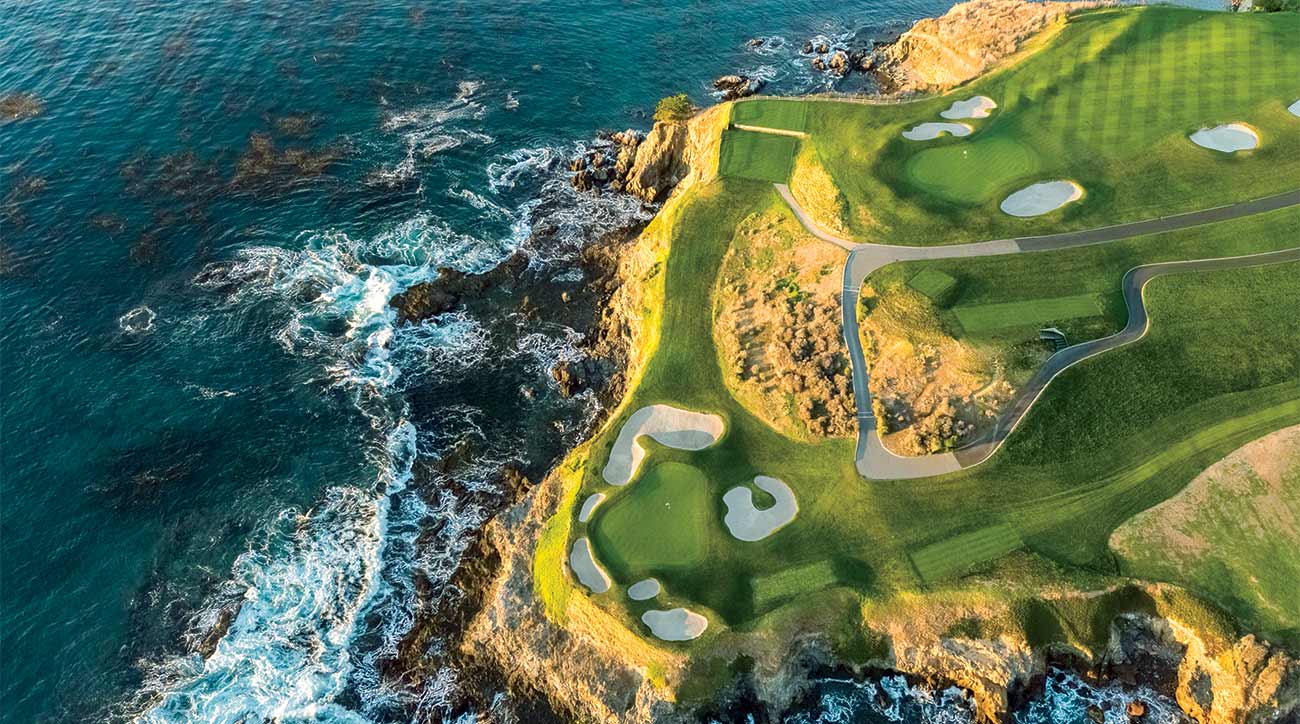
11. Pebble Beach
The first great American public oceanside course, Pebble benefits from an ingenious routing that brings the player to the ocean’s edge, then onto much higher ground, before returning to the cliffs for the climactic final two holes. Even today, with gobs of world class courses having been built in the past 100 years, no more thrilling, spectacular stretch exists than holes 4 through 10. Additionally, does any walk compare with that final stroll up the iconic par-5 18th as it curves left around Carmel Bay?! Hard for a course this well known to exceed first-time expectations — but it does. (Photo: Evan Schiller)
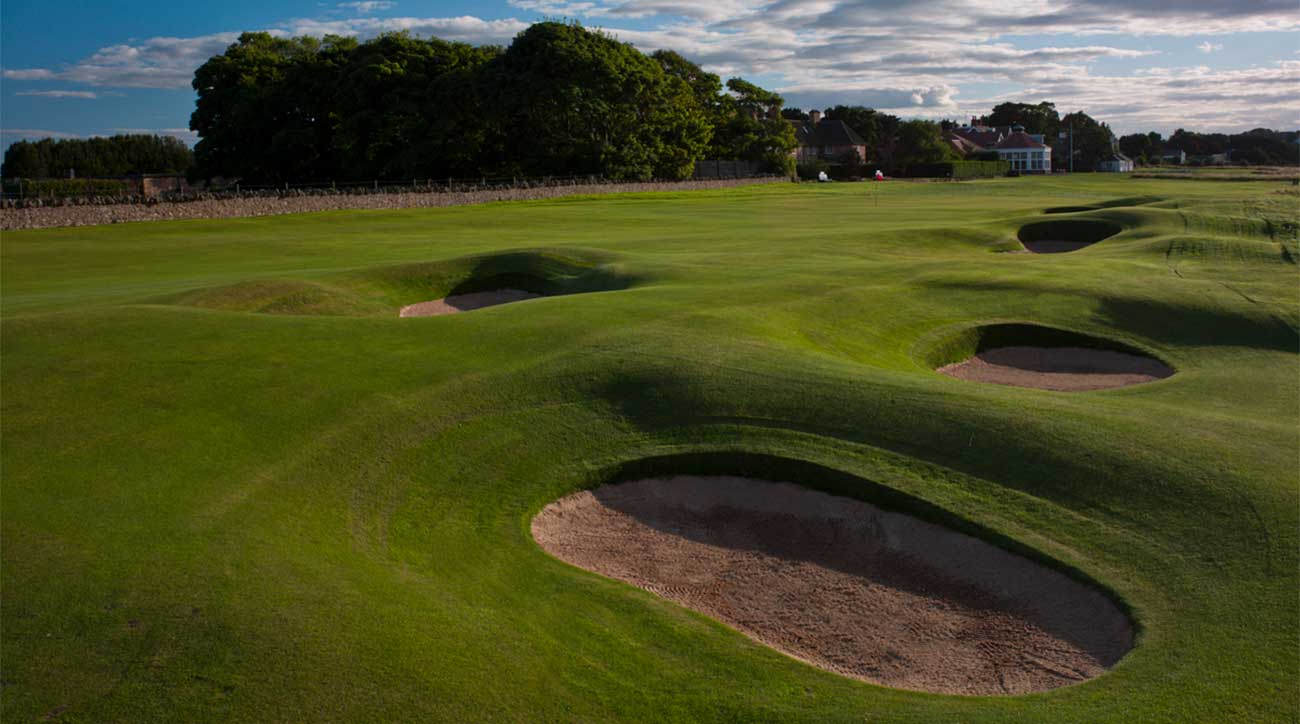
12. Muirfield
This 16-time Open venue — and site of the 2022 Women’s Open — was never more testing or memorable than in 2013, when Phil Mickelson rode his 3-wood to victory. The course so impressed Jack Nicklaus in his 1966 win that he named his own major-worthy course in Ohio after it. Tom Weiskopf cites the primary appeal: “The continuous change in direction from hole to hole leads to different winds, great balance and maximum variety.” (Photo: LC Lambrecht)

13. Royal Portrush (Dunluce)
The only course outside of England and Scotland to host the Open is perennially ranked in the world’s top-15 courses, thanks to a superior 1929 H.S. Colt design that maximizes its setting in the high dunes along the Irish Sea. The golf world saw two new holes in action at the 2019 Open: the 7th and 8th, which replaced the old, comparatively dull 17th and 18th holes. Both nines touch the cliff line, with the course’s most spectacular moment coming at the 5th as it doglegs right to a two-tiered green flush against the cliff. Indeed, plenty of the holes elbow one direction or the other, so driver is not an automatic decision. (Photo: Getty Images)

14. Sand Hills
Bill Coore and Ben Crenshaw moved teaspoons of dirt to construct the most natural, hew-to-the-land layout built since World War II. Rolling, sandy terrain, rippled fairways that were spared from a bulldozer, ever-present winds, wavy prairie grasses and gigantic blow-out bunkers create the sensation of being seaside in the middle of landlocked Nebraska. The design was immediately embraced, and the minimalist movement started in earnest, with this course arguably kicking off the second Golden Age. (Photo: David Cannon/Getty Images)
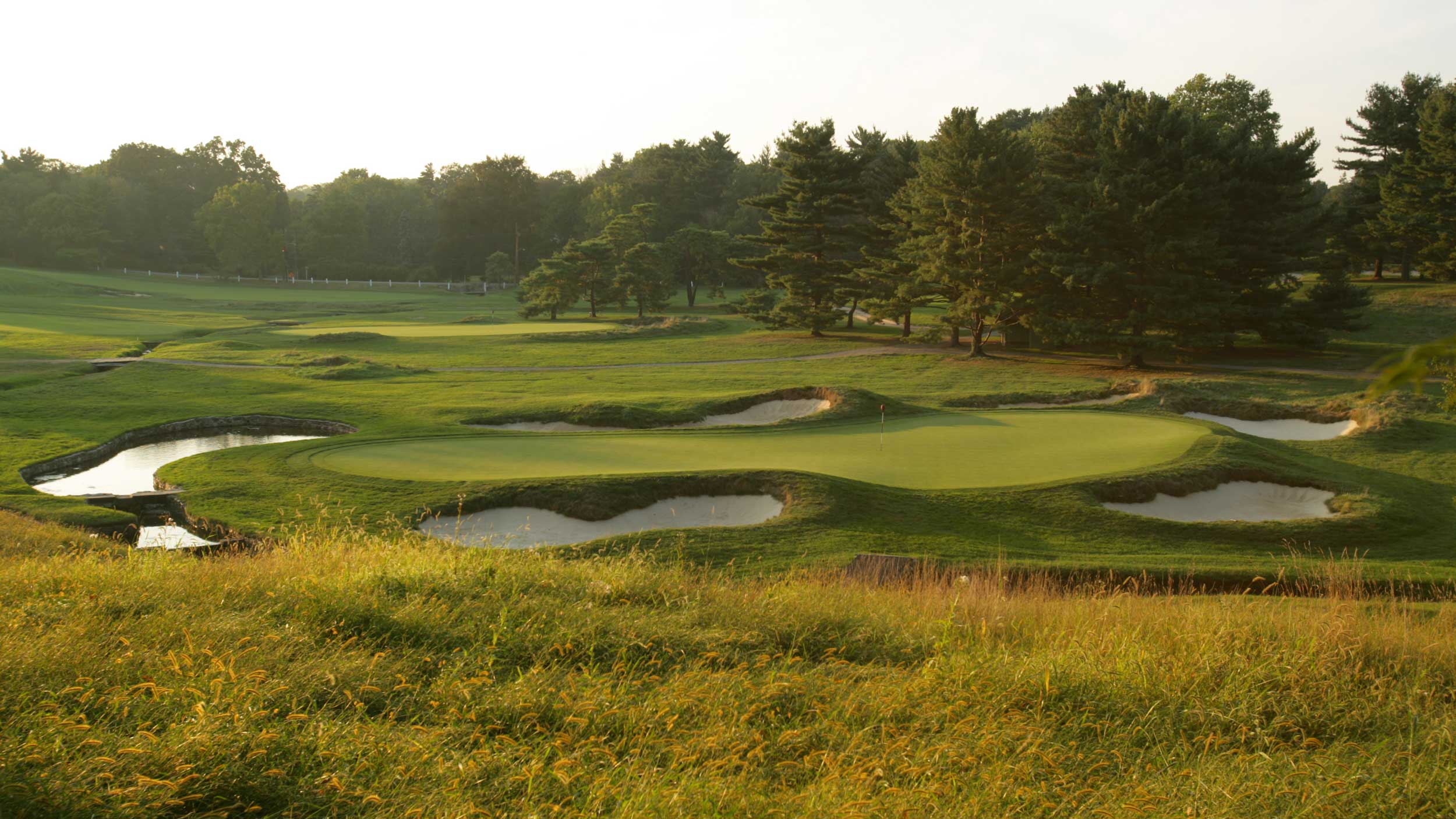
15. Merion (East)
What makes Merion so distinctive is its remarkable variety. Some par-4s are short, others are monsters with the delta being as much as 200 yards. One par-3 is tiny, at 115 yards; the others measure 236, 246 and 256. The famous par-4 11th, where Bobby Jones clinched the 1930 Grand Slam, is slashed by a creek, while the par-4 16th demands a shot over an abandoned stone quarry. In short, Merion has everything, including sub-air and irrigation systems that lend more control over the firmness and speed of the playing surfaces. The recently expanded greens have created a plethora of new hole locations around the greens’ perimeters, and the player’s chess match with the clever design is more intense than ever. (Photo: David Cannon/Getty Images)
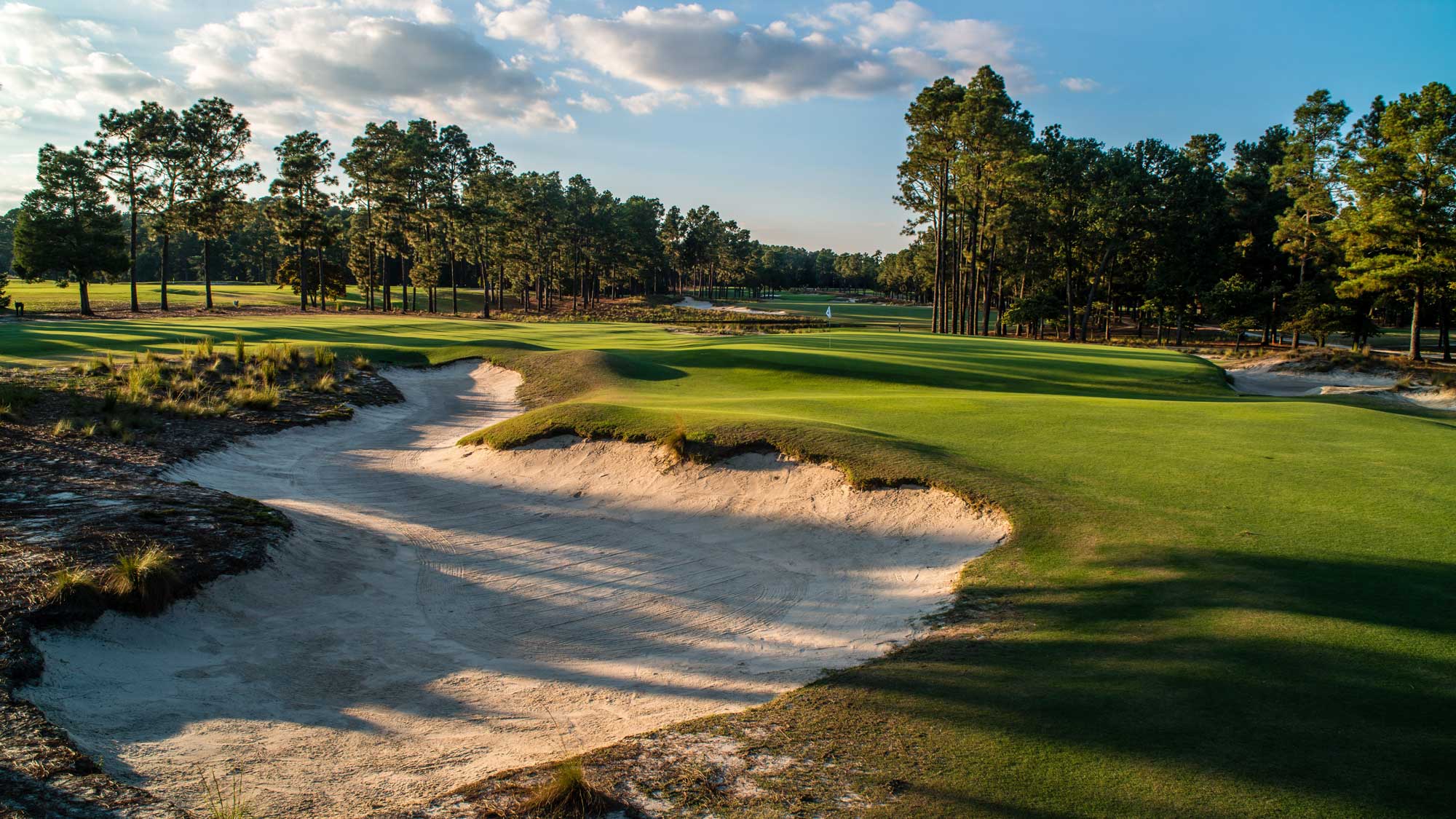
16. Pinehurst (No. 2)
Donald Ross’s chef d’oeuvre rolls spaciously through tall longleaf pines in the Carolina Sandhills with holes culminating with legendary inverted-saucer greens. For the 2014 U.S. Open, a Coore-Crenshaw restoration brought back the tawny-edged fairways and native areas last seen in the 1940s. Even with no rough, the runner-up could muster only one under par over four rounds. After the Women’s U.S. Open was played the following week, a powerful message had been broadcast around the world from the home of American golf about the virtues of width, short grass and great greens. This is one of a handful of courses that presents resort guests with a fun test on which they won’t lose a single ball, and a week later can be ready to host a U.S. Open. That’s the flexibility of short grass — and Ross’s design genius. (Photo: Joann Dost)

17. Trump Turnberry (Ailsa)
Trump Turnberry began as a Willie Fermie design and part of the famous Culzean estate. It’s been associated with the Turnberry hotel for more than 100 years. Neither World War was kind to the property, and Mackenzie Ross’s reconstruction after WWII provides the core of today’s layout. After a recent ownership change, a superb upgrade was performed by Martin Ebert that better utilized the jagged cliffline. The famed 9th tee near the iconic lighthouse was preserved but the semi-blind turtleback fairway wasn't. Instead, a stunning par-3 was created and 10 is now a par-5, longer and more complex while 11 moves closer to the shore. The 6th has been abbreviated to accommodate a splendid new back tee at the home hole. All and all, the upgrades propel the Aisla course into the highest echelon of links for both challenge and beauty. Turnberry became an Open venue in 1977 and has hosted two of its greatest championships, both headlined by Tom Watson. (Photo: Gary Lisbon)
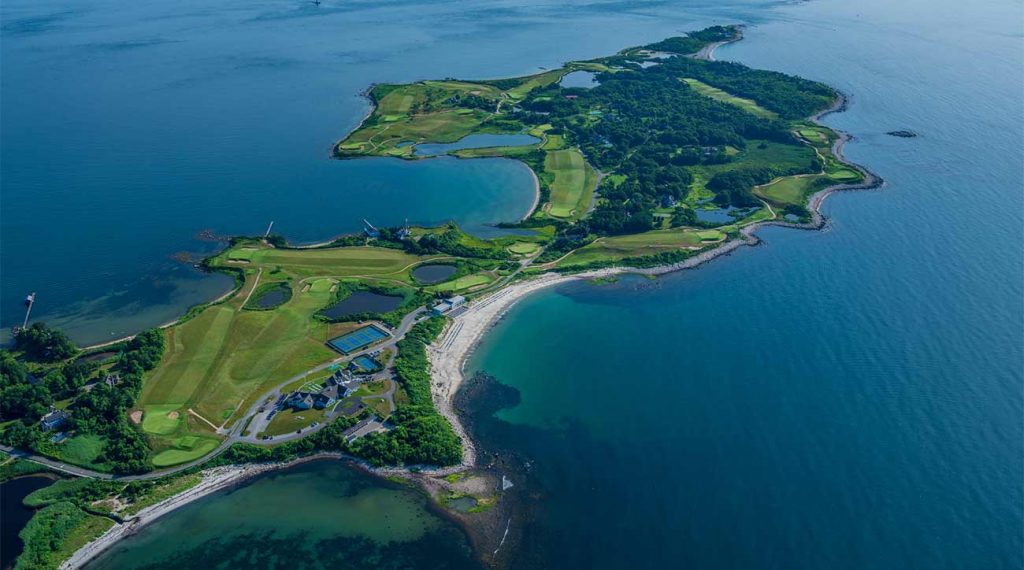
18. Fishers Island
Accessible by ferry or air, this exclusive retreat off the Connecticut coast is populated by the oldest of the Old Money crowd, many of whom still enjoy hoofing it. Why wouldn’t they, given the classic Seth Raynor design that tracks along the island’s northeast edge, the delightful tumbling terrain and the spectacular views of Long Island Sound. The 3rd, 4th and 5th are as intoxicating as any three-hole stretch on the eastern seaboard. Fishers joined our World Top 100 at No. 73 in 1989 — and has never looked back. (Photo: LC Lambrecht)

19. Chicago GC
One of the five founding members of the United States Golf Association in 1894, Chicago Golf was the site of the nation’s first 18-hole course; it also was the first course outside of the Northeast to play host to the U.S. Open. Seth Raynor retooled his mentor C.B. Macdonald’s course in 1923 and not much has changed since as its slew of exemplary template holes make it just as relevant today as it was in the hickory era. Holes 1 through 4, which include a Road and Biarritz template, represent one of the game’s most testing starts. (Photo: John and Jeannine Henebry)
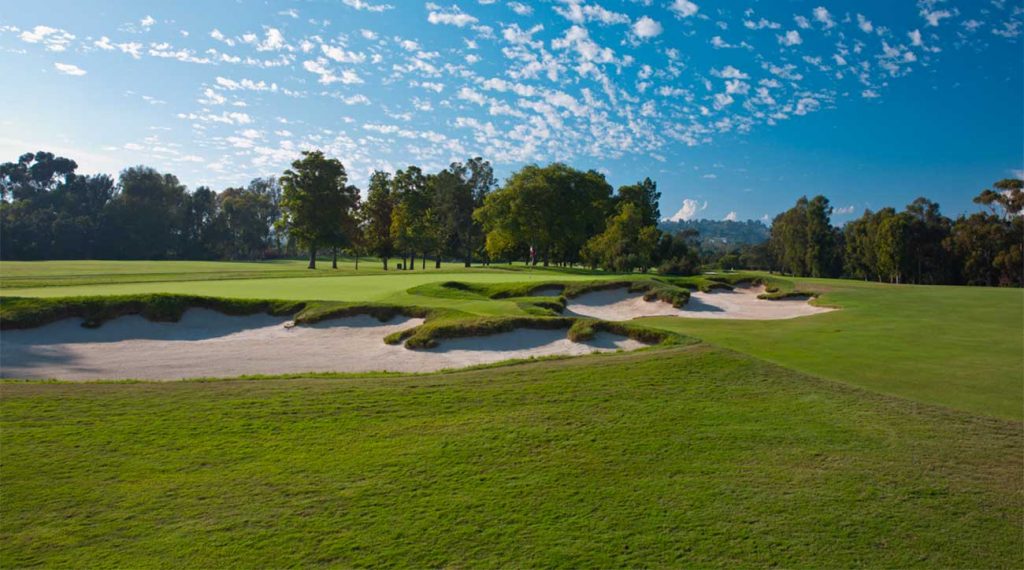
20. Los Angeles (North)
Gil Hanse and team restored George Thomas’s classic to perfection in 2010. Bunkers were reshaped and relocated, fairways widened and a natural barranca was brought back into play as a strategic hazard. Arguably America’s premier urban design, LACC North hosted the 2017 Walker Cup and design aficionados can’t wait for the 2023 U.S. Open. As Hanse says, “The course enjoys a perfect sense of place and balance.” Two shotters like 3 and 10 will challenge the players with uneven fairway lies but its superlative collection of one-shot holes will also prove quite a test, even with ball in hand and a perfect lie/stance. (Photo: LC Lambrecht)
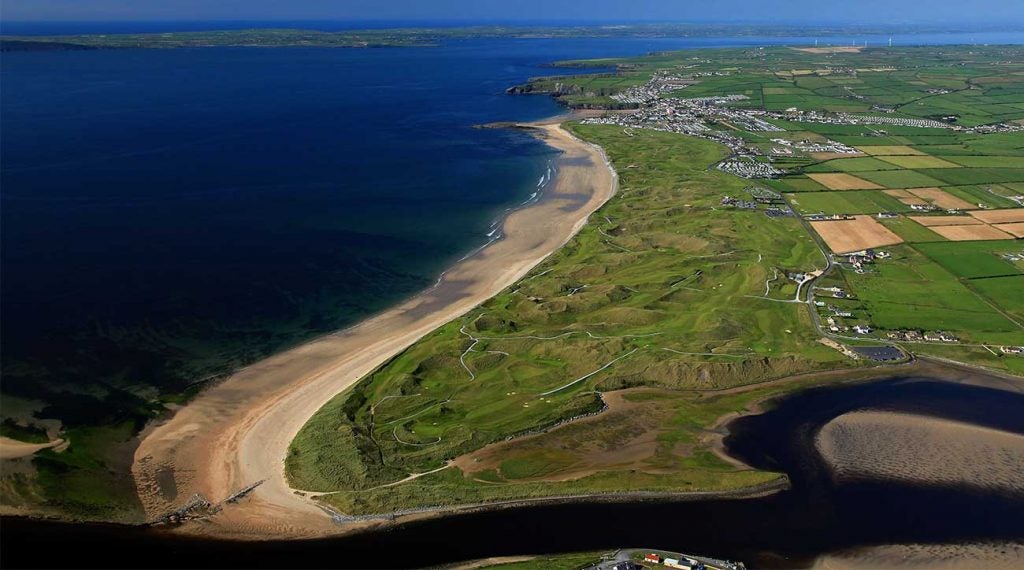
21. Ballybunion (Old)
This Southwest Irish gem is wedged between huge sandhills and the Atlantic Ocean. “Nothing less than the finest seaside course I have ever seen,” said Hall of Fame writer Herbert Warren Wind. Echoed five-time Open champion Tom Watson, “It is one of the best and most beautiful tests of links golf anywhere.” Greenkeeper John Bambury embarked six years ago to convert the poa greens to fine fescue and to re-establish the running game. His hard work has reached fruition. (Photo: Getty Images)
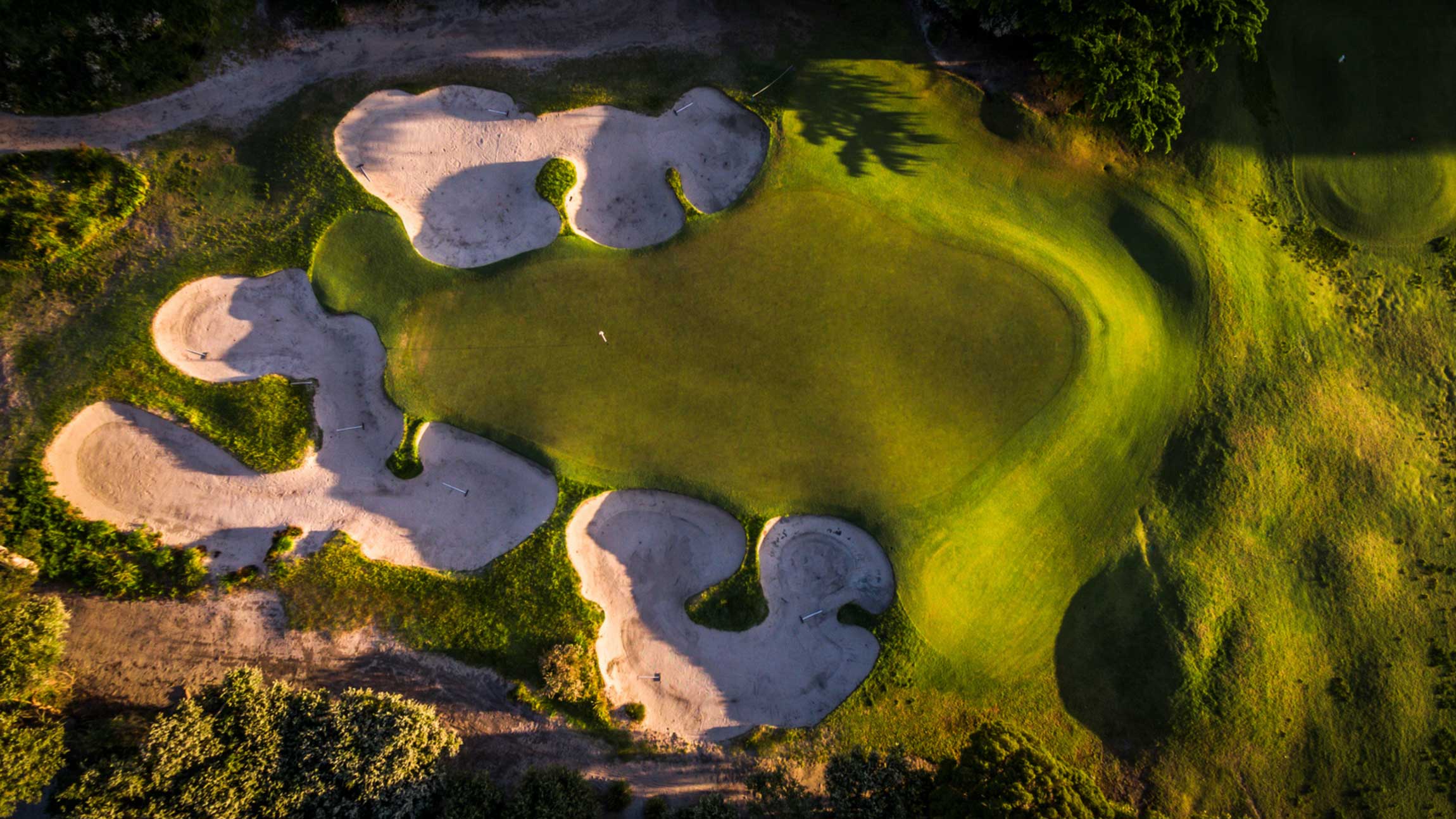
22. Kingston Heath
Dan Soutar, Mick Morcom and Alister MacKenzie each played a key role in creating a visual feast and a strategic masterpiece, helped in large measure by the site’s critical virtue of being located on sandy soil. Any modern architect should spend time here, studying how its creators teased so much from land that is neither rambunctious nor expansive. It’s no wonder this course is a darling among design aficionados. (Photo: Airswing Media)
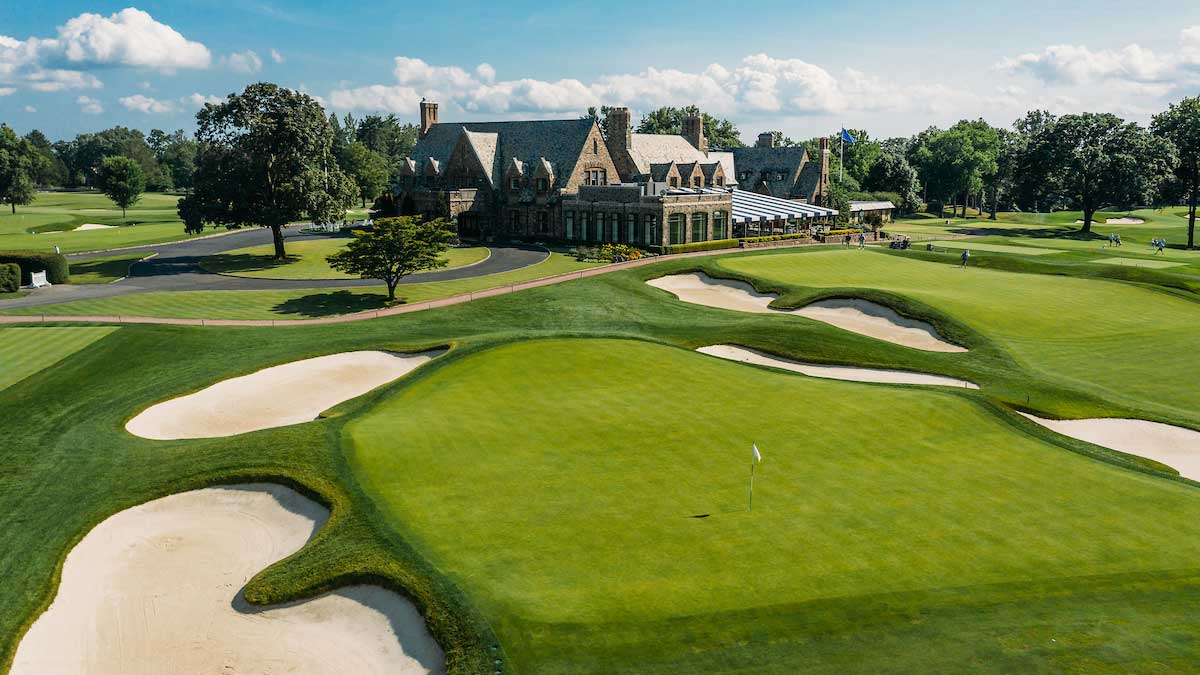
23. Winged Foot (West)
Hale Irwin survived the 1974 “Massacre at Winged Foot” U.S. Open to win at seven over par. Geoff Ogilvy didn’t fare much better in 2006, when his five-over total took home the trophy. Mark Brooks, 1996 PGA champion, summed up this Golden Age A.W. Tillinghast design this way: “There are probably six hard holes, six really hard holes and six impossible holes.” Frighteningly contoured, pear-shaped greens, cavernous bunkers and a procession of rugged par-4s define the trouble. On a “difficulty” scale of 1 to 10, Jack Nicklaus once rated the West course a 12. That said, Gil Hanse’s astonishing green expansion has brought back an exciting element of creativity with which few parkland courses can contend. (Photo: Christian Hafer)

24. Pacific Dunes
This unconventional Tom Doak treasure catapulted him into the spotlight at the turn of the century. A slew of par-4s on the first nine gives way to a 3-3-5-4-3-5 start to the second nine. Only Mike Keiser would have approved of such an unusual par sequence and this course helped modern architecture break free from certain design shackles that had constrained designers over the past five decades. Scattered blow-out bunkers, gigantic natural dunes, smartly contoured greens and Pacific panoramas complete Doak’s first masterpiece. (Photo: Evan Schiller)

25. Crystal Downs
Because of its remote location, Crystal Downs was once overlooked but that changed when Tom Doak introduced the course to Ben Crenshaw in the 1980s. A combination of strong breezes off Lake Michigan, thick fescue roughs, undulating terrain and fiendishly contoured greens make this one of the more difficult Top 100 courses relative to its par of 70. Measuring just under 6,600 yards, monster length is not required when you have greens this good. (Photo: Gary Kellner/Dimpled Rock)
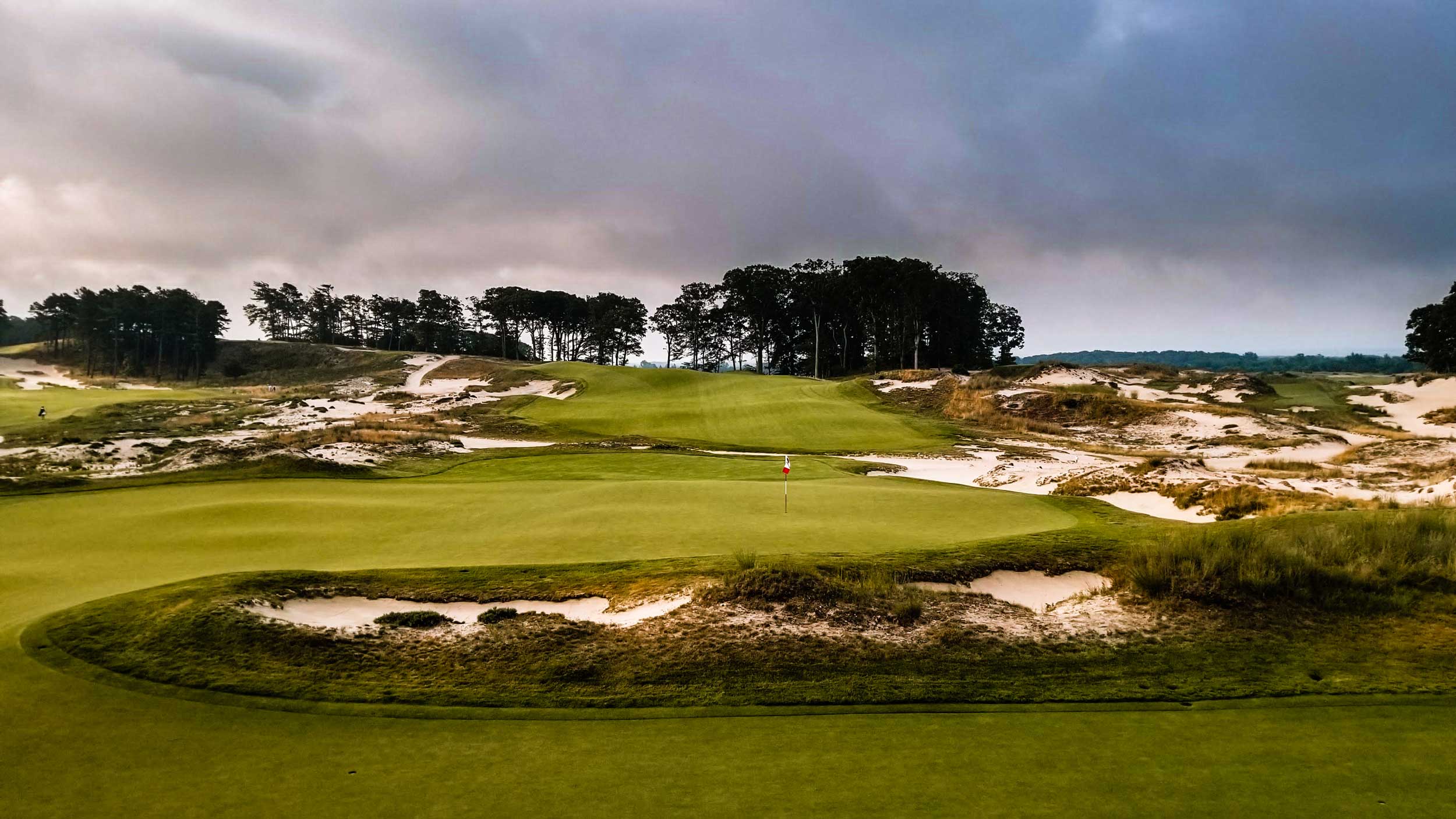
26. Friar's Head
Tree-dotted dunes, open meadows and bluff-top views of Long Island Sound highlight play at this 2003 Bill Coore-Ben Crenshaw design that Phil Mickelson has called his favorite modern course. Holes such as the par-5 14th call to mind an East Coast version of Cypress Point. Constant refinements, no matter how small, have Friar’s Head as dialed-in as any course in the country. (Photo: Channing Benjamin)

27. Tara Iti
Tara Iti jumped onto our World list in 2017 as one of our highest debuting courses ever. Then it moved higher still. The course is buoyed by its enviable location in the dunes along the Pacific Ocean, along with superior fine-fescue fairways and swirls of natural grass and sand. The design is loaded with standout holes. Two of its one-shotters — the 15th and 17th — are media darlings but another of the course’s best moments comes at the long uphill 12th, which plays away from the Pacific Ocean to an open, tilted green that is 7 feet higher on its right than left. Bouncy-bounce golf reigns supreme at the 12th, which is a dazzler even without ocean views. (Photo: Jacob Sjöman)

28. Riviera
The value that an architect provides is highlighted here in technicolor. Built in a narrow canyon, there was no reason to hold high hopes for this course. Yet what emerged, courtesy of George Thomas and Billy Bell, is one of the game’s strategic design marvels. Together, the designers took bunker configuration and angled greens to new heights in the 1920s. As proof of their magical skills, look no further than Riv’s 311-yard, par-4 10th. Thanks to the inspired positioning of the bunkers and the angled green, options abound on how to card a big number on this tiny hole. Thomas’s famous quote — “strategy is the soul of the game” — manifests itself at Riv. (Photo: Patrick Koenig)
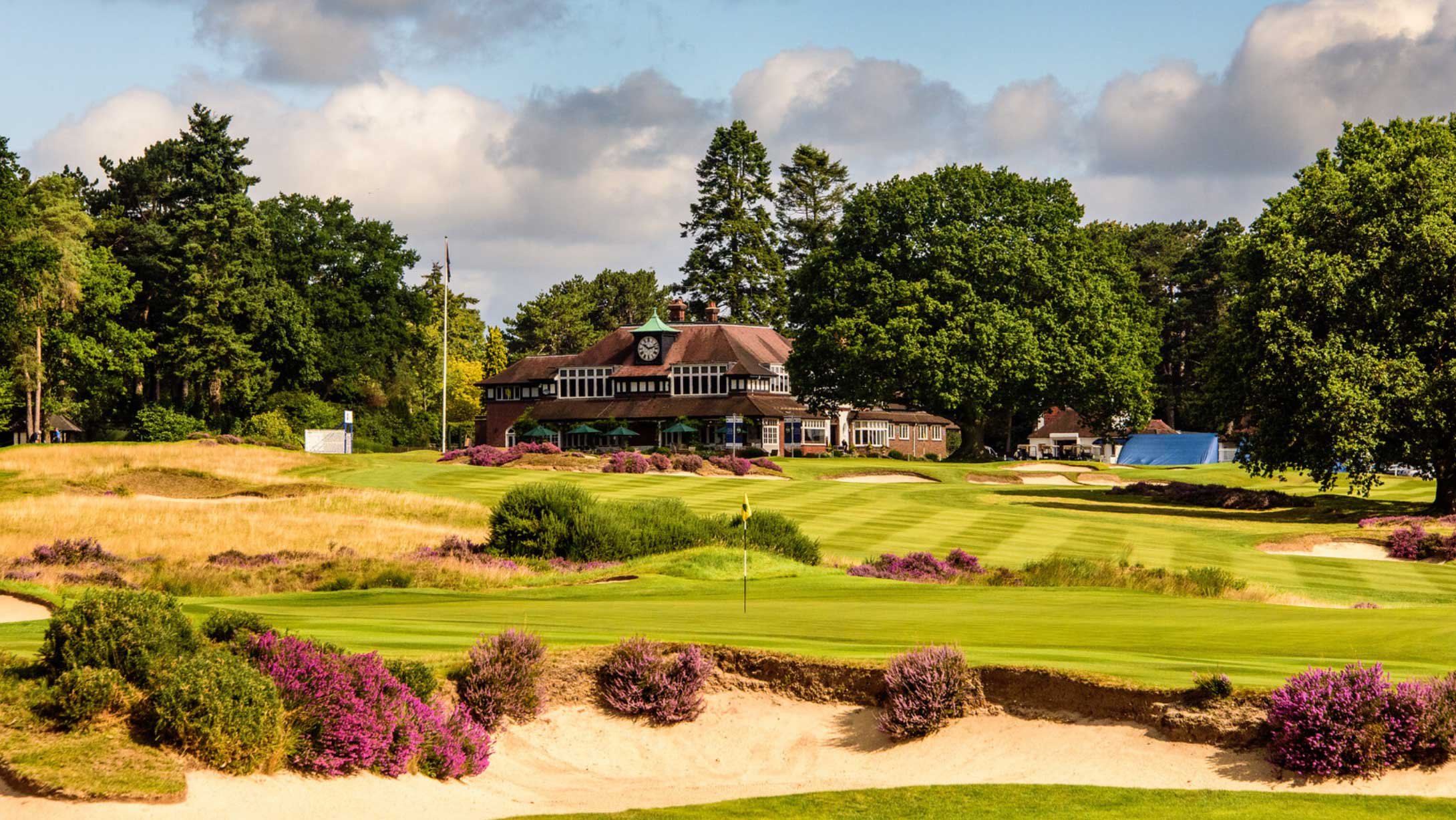
29. Sunningdale (Old)
Golf in the United Kingdom originated along its coastline on linksland but as the sport became popular, people wanted courses nearer to where they lived. One of the earliest inland courses that established a new standard in design came here at Sunningdale just after the turn of the last century. When you layer on Harry Colt’s improvements (such as moving the 12th green high and to the left) to Willie Park Jr.’s original effort, you end up with one of the game’s most noble inland courses. (Photo: Kevin Diss)
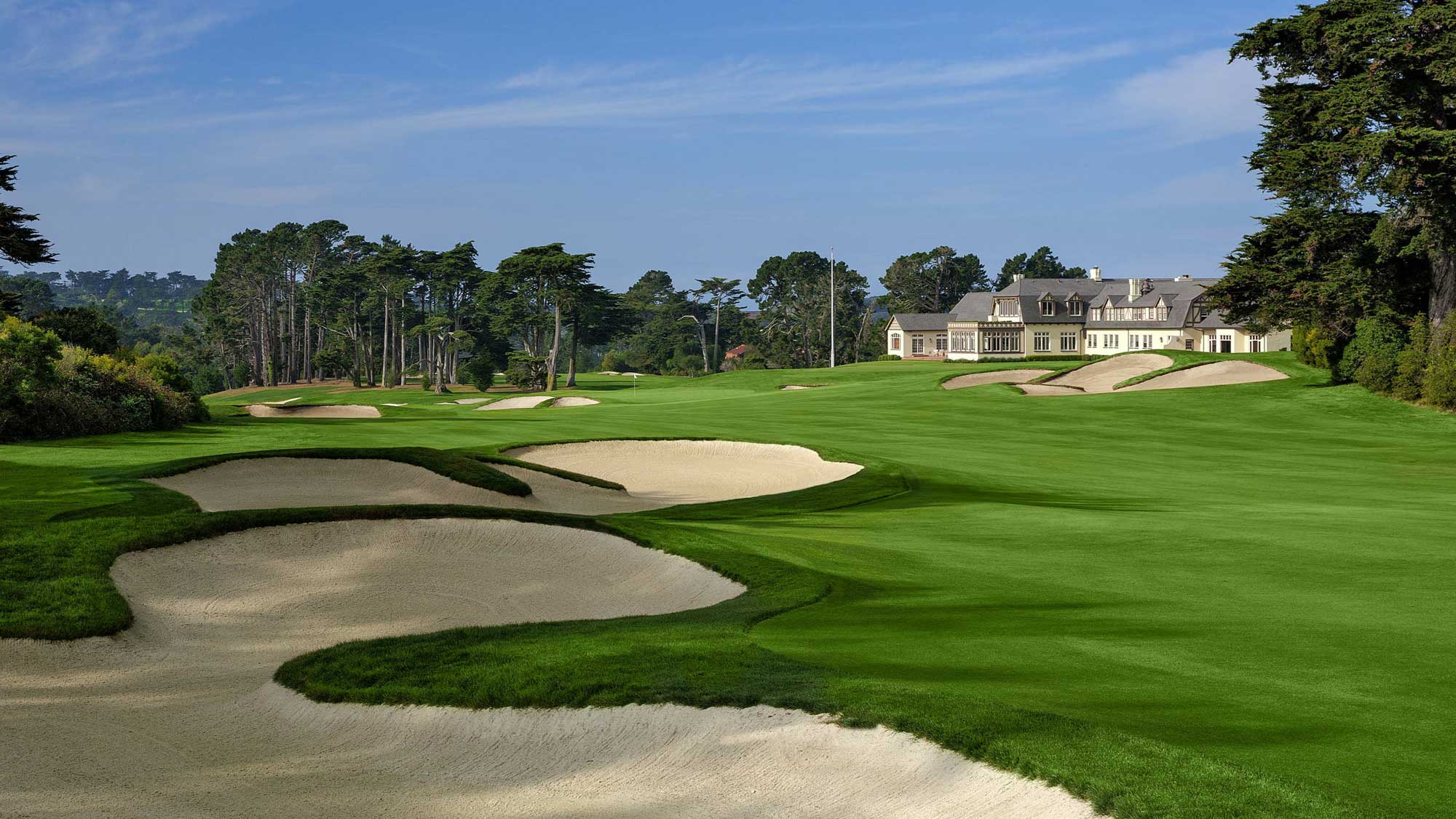
30. San Francisco
A.W. Tillinghast built his most artistic collection of bunkers at this low-key Bay Area hideaway that avoids publicity as steadfastly as its neighbor the Olympic Club embraces it. Known as the Duel Hole, the drop-shot par-3 7th may be the course’s most famous hole, but its par-4s, including the 2nd, 3rd, 10th and 12th, are the real headliners. (Photo: Courtesy SFGC)

31. Prairie Dunes
After weeks of tromping around the yucca-choked sand hills of Hutchinson, architect Perry Maxwell proclaimed, “There are 118 good golf holes here. All I have to do is eliminate 100 of them.” All that's missing is an ocean at this linksy-looking layout that played host to the 2002 U.S. Women's Open (Juli Inkster) and 2006 U.S. Senior Open (Allen Doyle). What a delight that the Maxwells got to work with this special site as their soft touch on the land is a must-study for any architect. (Photo: David Cannon/Getty Images)
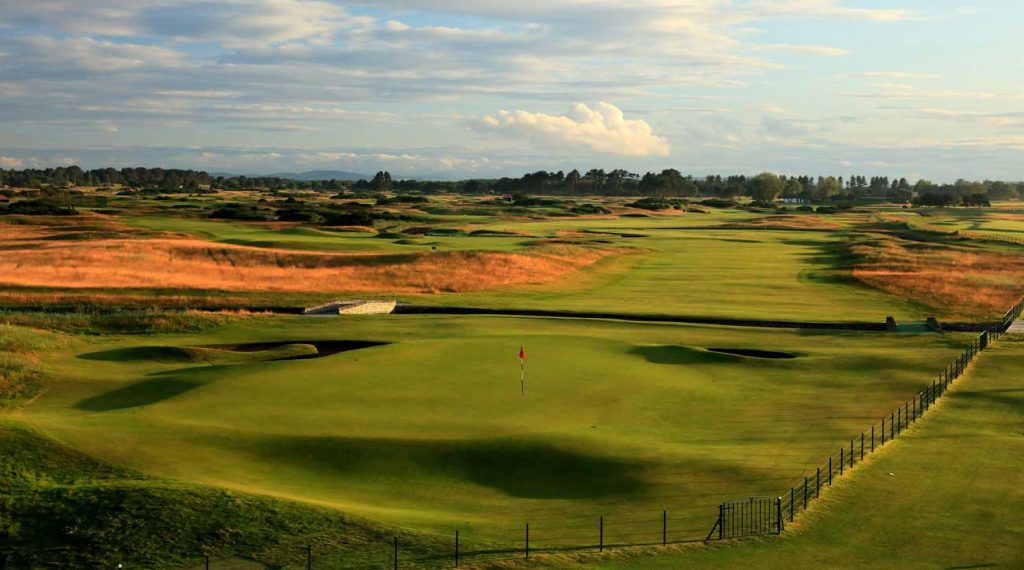
32. Carnoustie (Championship)
This ancient links dates to 1842 and is defined by heather, gorse, jungle-like fescue rough, steep-faced revetted bunkers and the sinuous Barry Burn — all of which create havoc in the wind. The meanest of the Open rota courses has produced winners such as Ben Hogan, Gary Player and Tom Watson. A poor course set-up for the 1999 Open furthered its reputation as “Carnastie.” That’s a shame. Played from the appropriate set of tees, you will be pleasantly surprised — and thoroughly impressed — by the course’s variety and and its excellent, diverse set of greens. (Photo: Getty Images)
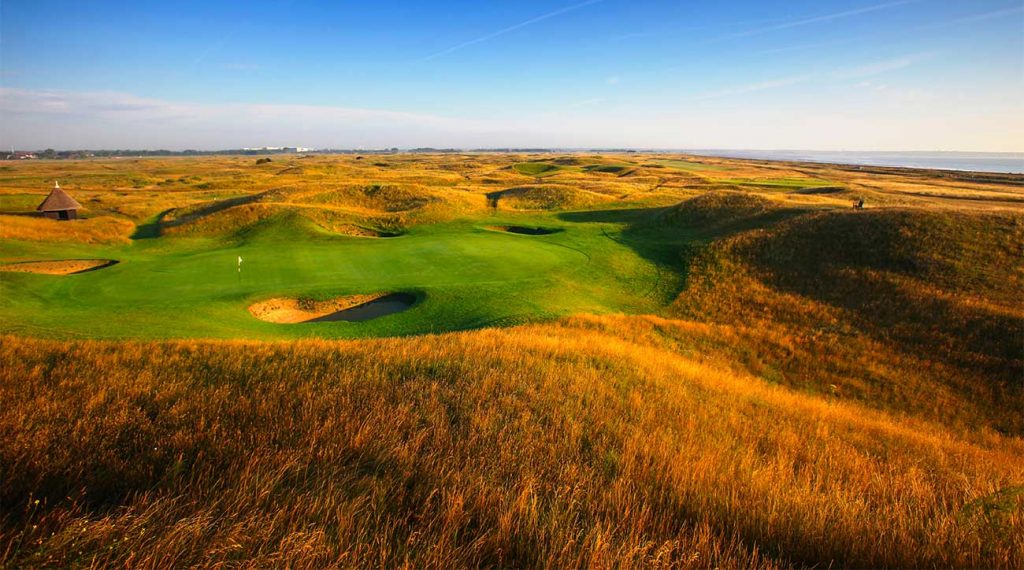
33. Royal St. George's
This 15-time British Open host dates to 1887. “Sandwich,” as it is known colloquially, occupies some of the most rambunctious dunes of any Open venue. Yes, that means there are more blind shots here than at the other host sites. Some professionals embrace that aspect while others are leery. Amateurs, who look at links golf as an adventure vs. a livelihood, are more uniformly effusive in their praise. Though Sandwich is expansive, tense moments present themselves, including on 4th tee, where you must clear the rota’s most fearsome fairway bunker. James Bond creator Ian Fleming was a big fan of the perils of the perched 10th green but the nerviest single moment comes at the par-5 14th tee with outbounds hard along the right. Much to his credit, nothing fazed Collin Morikawa en route to his impressive 2021 Open win. (Photo: Kevin Murray)

34. Seminole
Arguably the finest site on which Donald Ross ever worked, the course plays along and between two main dune lines, and Ross made the most of the opportunity with holes continually tacking in different directions. The club prides itself on its firm playing surfaces, which were on full display during the 2021 Walker Cup. Some grouse that the course’s reputation is built on the club’s exclusivity, which is unwarranted given that standout holes abound, including the 4th, 6th, 13th and one of the game’s finest finishing three-hole stretches. (Photo: Patrick Koenig)

35. Barnbougle Dunes
Australia’s greatest links continually achieves top-40 status thanks to a sophisticated design coupled with a stirring seaside setting with holes nestled in large dunes that run parallel to the ocean. The clubhouse is situated in the middle, with each nine fanning out on either side. The dunes extend inland “only” some 350 yards and the architects did a fabulous job in having the holes flow across them in every conceivable manner. One highlight is the short 7th, which is the Southern Hemisphere’s equivalent to the Troon’s Postage Stamp hole and is equally adept at wreaking havoc. One of its tricks? Its abrupt change in direction from any previous holes means golfers don’t have a good read on how the wind will affect their tee balls. (Photo: Gary Lisbon)

36. Lahinch (Old)
Lahinch charms with titanic sandhills and stunning views of both the Atlantic Ocean and of the Cliffs of Moher. Old Tom Morris’ 1893 design, coupled with Alister MacKenzie’s 1927 enhancements, including the 9th green, and Martin Hawtree’s 2003 push into the big dunes, proves an irresistible combination of beauty, challenge and fun. (Photo: LC Lambrecht)

37. North Berwick (West)
East of Edinburgh sits this fabled links. Among it many highlights is the 15th hole, the much-copied Redan, a par-3 played to an elevated, diagonal green. In the memorability department, however, 15 takes a backseat to the par-4 13th, The Pit, whose green sits directly behind a low stone wall. Less discussed but just as exciting is its 16th green, with its left and right plateaus separated by a deep channel. Our panel clearly appreciates the variety of obstacles that the golfer must overcome as the course has steadily climbed the World ranking since its initial appearance in 2007. (Photo: Graylyn Loomis)
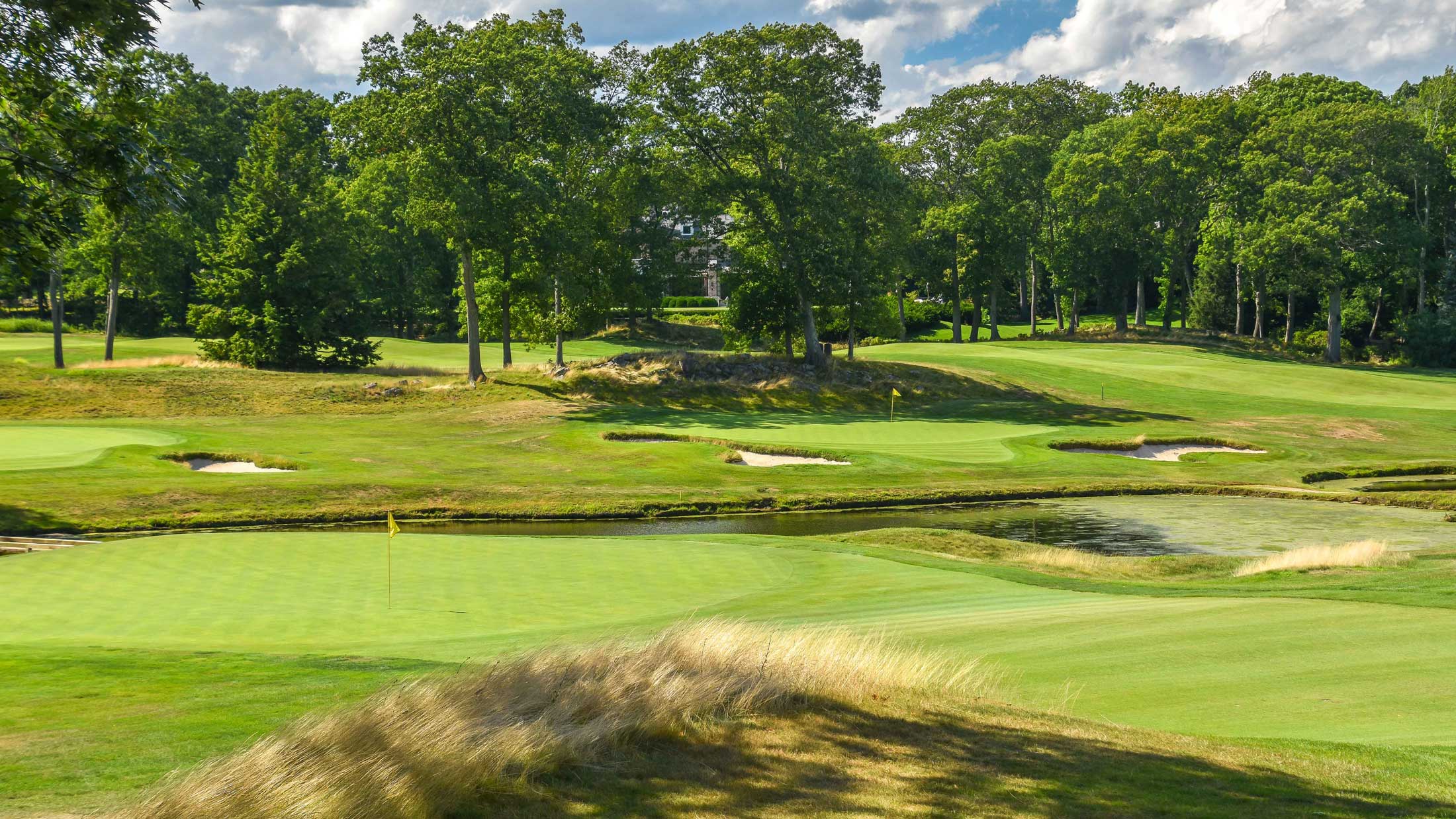
38. The Country Club (Clyde/Squirrel)
A Boston Brahmin society haunt for more than 125 years, this tree-lined design has played host to four U.S. Opens and the famous 1999 Ryder Cup. Its configuration of holes for the 2022 U.S. Open proved to be its best composite course yet out of its 27 holes but note: GOLF ranks the Clyde/Squirrel course that its members play on a regular basis. That’s the configuration of holes that was used for the 1913 Open when local lad Francis Ouimet stunned the big, bad Brits. Its old-school features include cross hazards and medium-size greens. The field at the 2022 U.S. Open was reminded that there is no substitute for hitting fairways and greens as thick rough remains a component of the course’s challenge just as it was in 1913. (Photo: Patrick Koenig)

39. Hirono
Japanese golfers had never seen the kind of deep, strategically placed bunkers that architect C.H. Alison introduced to Hirono in the early 1930s, so bunkers built since became known as “Alisons.” Originally, the course bore a sandy, scrubby appearance, but tree planting changed Hirono’s character over the decades. Thankfully, Martin Ebert’s recent restoration efforts have reestablished sand as a dominant theme. (Photo: David Alexander/Getty Images)
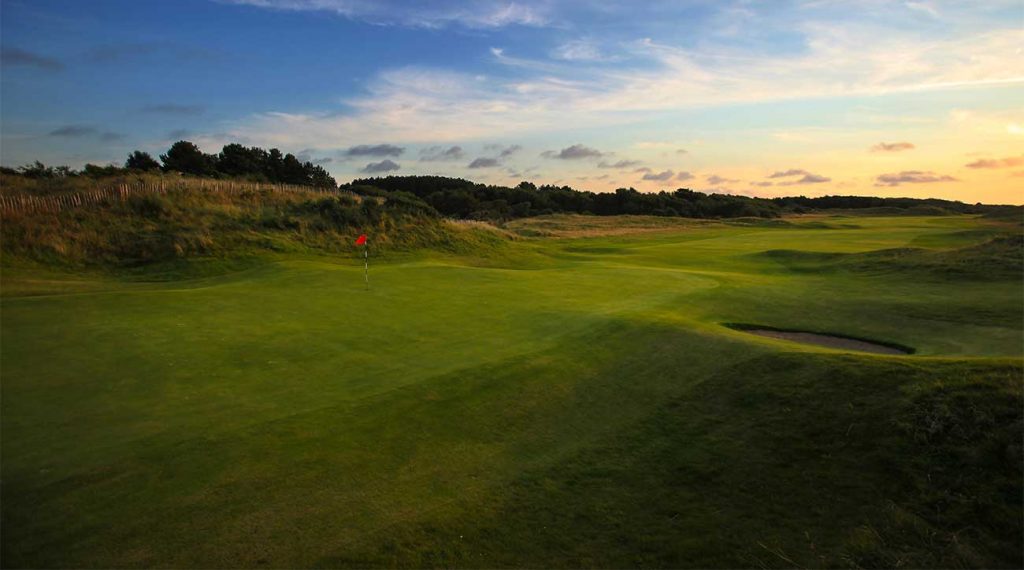
40. Royal Birkdale
Many consider this links to be the “fairest” Open rota course as most of the holes roll through valleys and the number of blind shots are few, despite the course being set in towering dunes. Peter Thomson won the first Open played here, in 1954, and Birkdale has staged nine other editions, most recently Jordan Spieth’s remarkable win in 2017. (Photo: Kevin Murray)
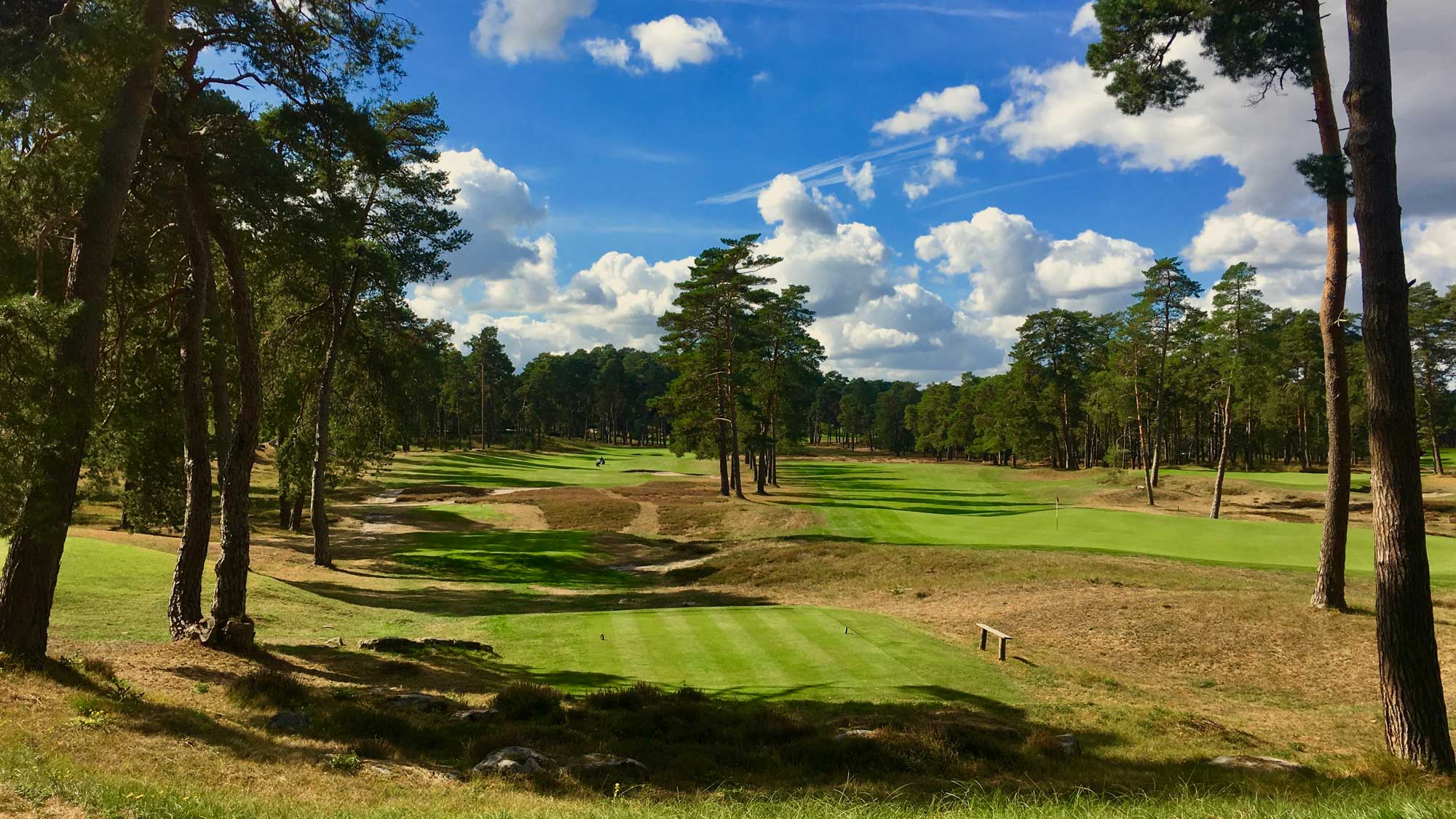
41. Morfontaine
Tucked away in a nearly impossible-to-find forested location 40 miles north of Paris is a low-key heathland design that is utterly charming and utterly private. A bold start that features a 475-yard par-4 and a 225-yard par-3 give way to gentler, though strategically rich holes that were favorites of General Dwight D. Eisenhower, a frequent visitor. Don’t miss Morfontaine’s nine-hole Valliere course; its green contours are as dazzling as the City of Lights itself. (Photo: Dylan Dethier)
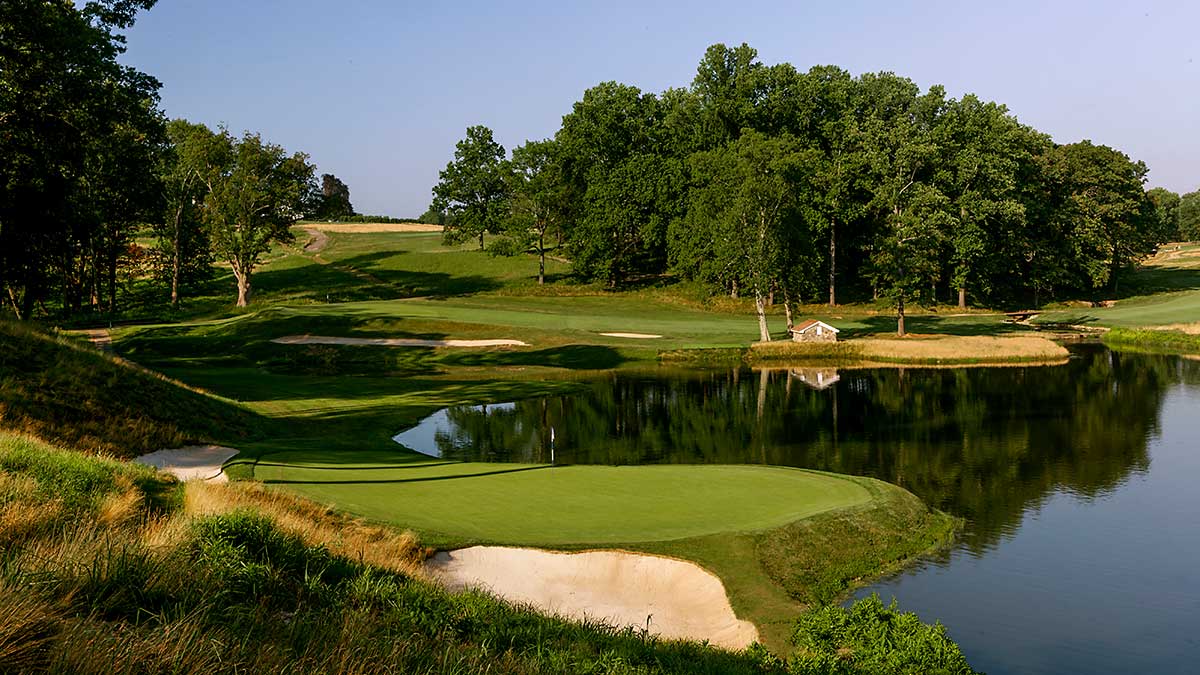
42. Somerset Hills
Thanks to a 25-year-long restoration effort with meticulous attention to detail, Somerset Hills has reached the point where some trumpet it as A.W. Tillinghast’s finest design for regular play. Its two nines are diverse — the first is on more open land while the second jumps into the woods where Tillinghast incorporated natural water features to perfection. Tillinghast’s time in Scotland manifests itself at such holes as the Redan 2nd and the par-5 9th with its attractive cross hazard. A die-hard New Yorker remarked, “It’s enough to make one want to live in New Jersey.” (Photo: Russell Kirk)

43. Cabot Cliffs
Canada’s top-ranked course is a six-year-old Bill Coore/Ben Crenshaw that alternates between big dunes at the southern end and cliffs at the northern end that rise more than 100 feet above the Gulf of St. Lawrence, inspiring Pebble Beach-like awe. The 2nd hole, arguably the course’s finest, starts from a tee high on a bluff and requires a rousing tee shot over wetlands, followed by an equally dramatic approach to an elevated green with punchbowl qualities. The opportunity to use side slopes to kick balls onto the putting surfaces is a recurring design theme and the fescue fairways encourage lively interaction with the ground. Two of the best examples occur late in the round. One is at the downhill 560-yard 15th, which is reachable under certain wind conditions. The other comes at the 320-yard 17th, where a courageous well-executed power fade over the cliffs and down the sloping fairway could result in an eagle putt. A great design lends itself to lasting memories, and Cabot Cliffs is aces in that department. (Photo: Brian Oar)
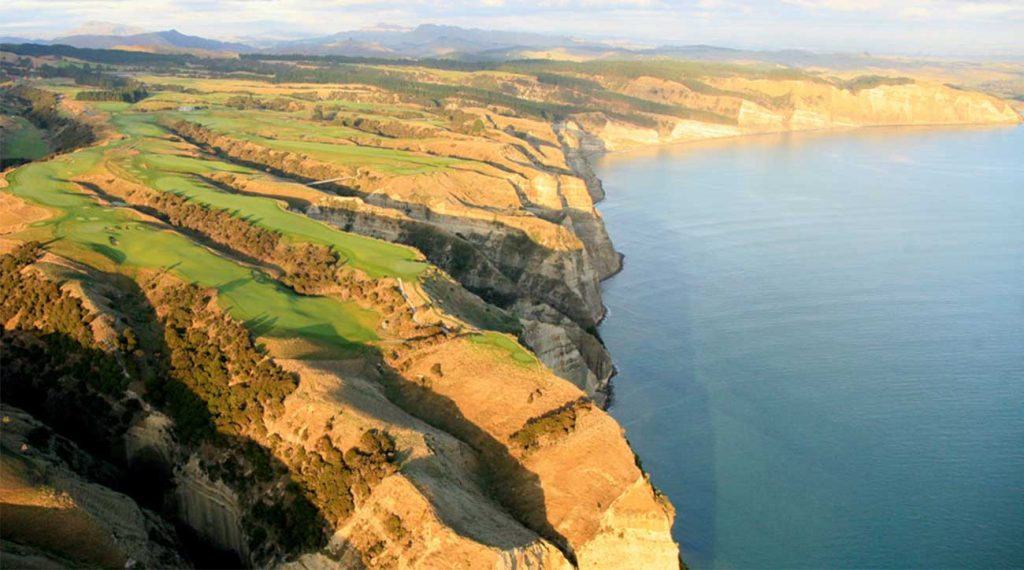
44. Cape Kidnappers
Drone shots of this course are evocative, showing holes located on fingers of land hundreds of feet above the Pacific Ocean. But golf is played from the ground, not the air, and that’s just fine here as the tumbling landforms are ideal for golf. The course’s most famous hole is also its most feared, the 650-yard, par-5 15th, which falls away on both sides of the fairway and sports a horizon green perched precariously on a bluff overlooking the ocean. Architecture buffs are likely to be just as captivated by the playing angles at the preceding hole, a short two-shotter with a Road Hole green complex. (Photo: Gary Lisbon)
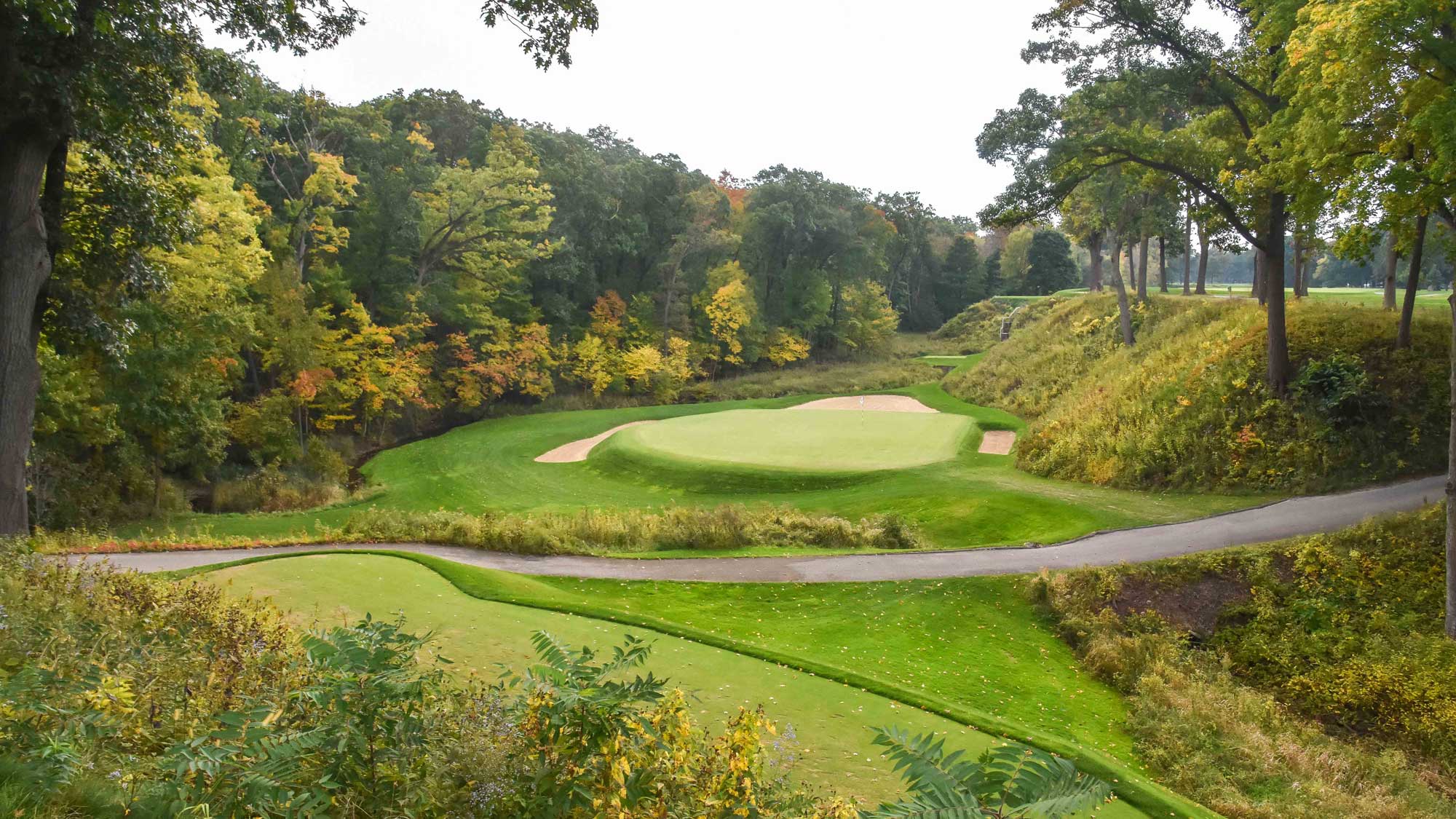
45. Shoreacres
Steep ravines affect play throughout Shoreacres’ famed stretch of holes from 10-15. The rest of the property features more modest topography but you are unlikely to notice that fact as the expansive greens offer such interesting targets. Ironic for an architect who built template holes but the best hole on this Seth Raynor design may well be the thoroughly original risk-reward 520-yard par-5 15th, which doglegs left, over and around a ravine. (Photo: Patrick Koenig)
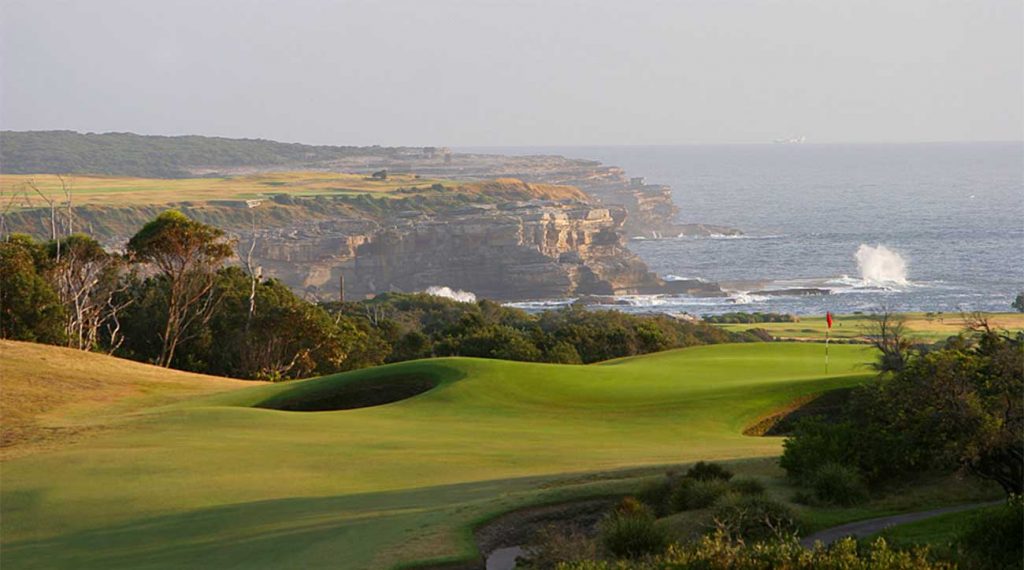
46. New South Wales
Sydney’s magnificent Harbour Bridge and Opera House speak to a city of impossible beauty and the course at La Perouse is its crowning golf offering. The middle of each nine features holes along the rugged shoreline. The two most famous holes are the par-5 5th, with its long, downward sloping fairway toward the Pacific, and the 195-yard 6th that plays over an inlet of Cape Banks, but the stretch from 13 to 16 is as good a run of par-4s as you will find anywhere. (Photo: Gary Lisbon)
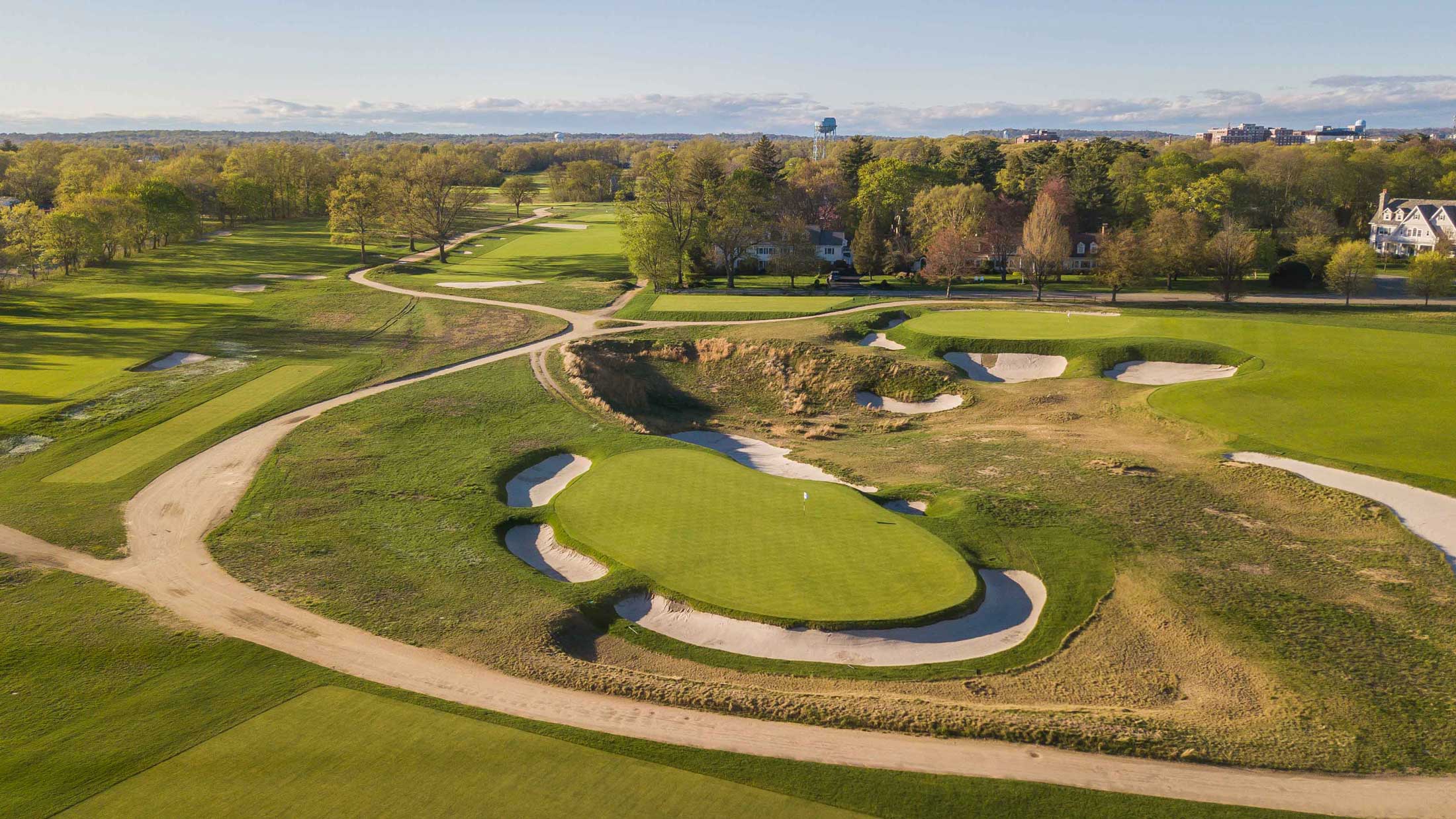
47. Garden City
Devereux Emmet and Walter Travis share credit for this old-school design that plays across Hempstead Plain on Long Island. The water is 10 miles both north and south, so sea breezes are a frequent companion. Laurie Auchterlonie won the 1902 U.S. Open here with record scores, owing to the debut of the longer, more durable Haskell ball. Garden City’s tilted greens, like the 10th and 15th, are lay-of-the-land architecture at its highest form. To understand what it means to “get the most from the land,” study the small parcel around the clubhouse that contains the 1st, 2nd and 18th holes, each stellar in its own right. (Photo: Patrick Koenig)

48. Portmarnock (Old)
On approach to the Dublin airport, keep your eyes peeled out the window for a glimpse of the most romantic location for a golf course imaginable. Yes, that would be Portmarnock, set among low dunes at the end of a peninsula. The sense of seclusion is palpable, even though you are only 7 miles as the crow flies from a bustling capital city. Seve Ballesteros, Bernhard Langer and Ian Woosnam are among those who won Irish Opens here. Arnold Palmer once tabbed the 15th as one of golf’s best par-3s and yet the other par-3 on that side (the shorter 12th) is just as good. Be prepared for some of the fastest, purest running conditions that the game offers. Also, don’t miss its third nine, the Yellow Nine. (Photo: Courtesy Portmarnock)

49. Southern Hills
Site of three U.S. Opens and a quintet of PGA Championships, this Depression-era Perry Maxwell design features holes that gracefully flow across a plot of undulating ground perfectly suited for golf. For decades, the land was smothered underneath a canopy of trees but Keith Foster and then Gil Hanse have opened up the property for all to admire. Gone too are the clean-edged bunkers that never looked at home on a Maxwell design. Raves all around for how this course has evolved this century, as demonstrated by the exciting 2022 PGA Championship won by Justin Thomas. (Photo: Gary W Kellner)
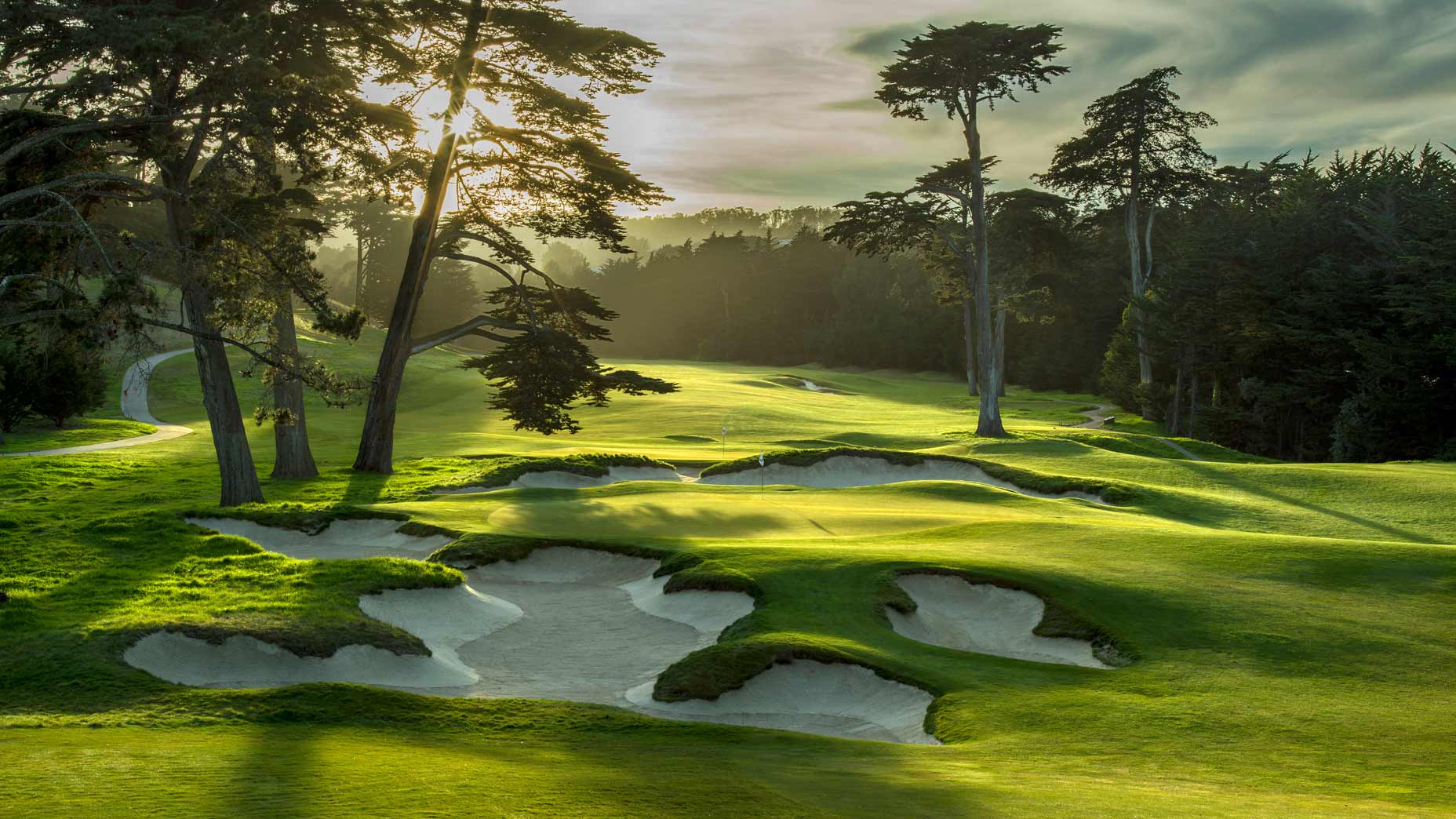
50. California Golf Club of San Francisco
For most of its 80-year history, the Cal Club, as locals call it, served up a tight though well-regarded course, enhanced by its association with Ken Venturi. Following a 2008 Kyle Phillips re-do that was part restoration and part redesign, many feel this private course is equal to any in California north of Cypress Point. Situated on the side of a hill, Cal Club is guaranteed to catch any wind that is about. Add in fescue fairways and the site’s broad slopes and you have a course whose asks change daily. Even in calm conditions, the mix of short grass, sprawling bunkers and cypress trees provide constant photo opportunities. When you discover the design plays as good as it looks, you have something special. (Photo: Evan Schiller)
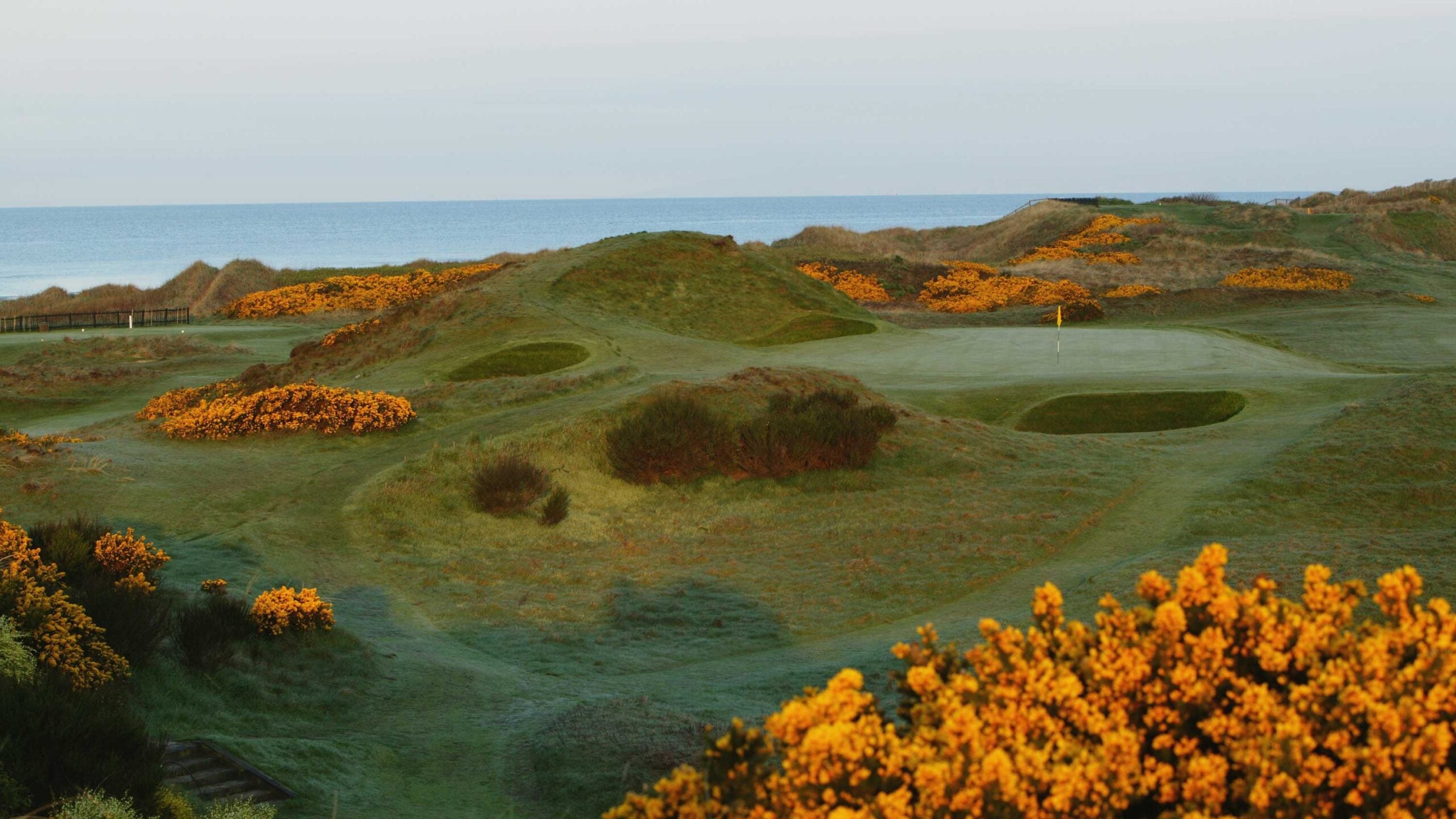
51. Royal Troon (Old)
Arnold Palmer, Tom Weiskopf and Tom Watson are among the Americans who have triumphed at Troon, yet the most memorable shot was struck by a non-winner: 71-year-old Gene Sarazen, who aced the 123-yard “Postage Stamp” 8th (pictured) during the 1973 Open — with a 5-iron! The mighty-mite 8th gets much of the attention, but Troon also has a host of sterling two-shotters, including the 7th, 11th, 13th and 15th. The stonewall separating the course and the rail line is unnervingly tight right of the 11th green and serves as a great litmus test to determine who is (and isn’t) in full control of their swings. By all means, celebrate the Postage Stamp but pay heed to the course’s other riches, too. (Photo: David Cannon/Getty)
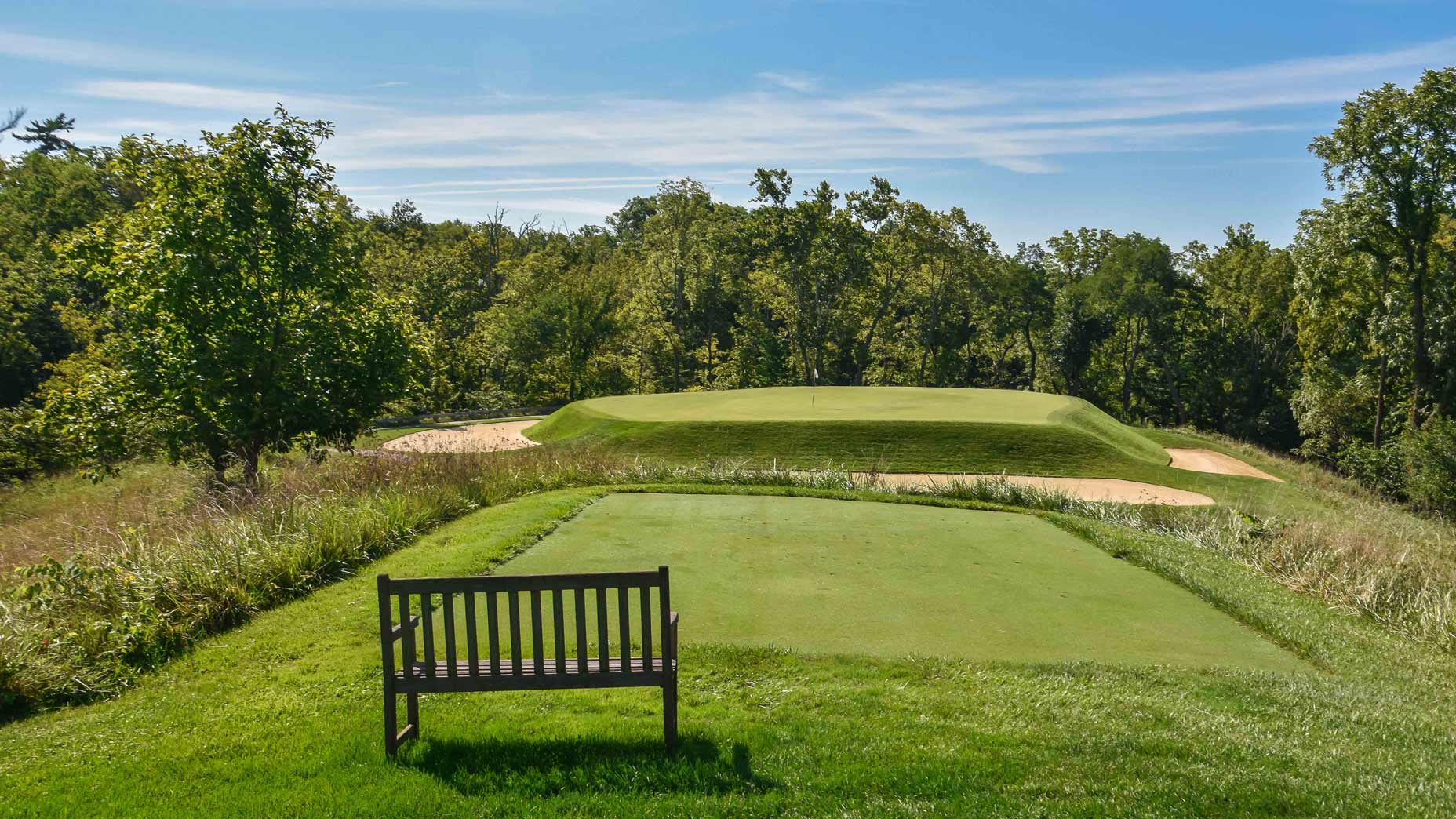
52. Camargo
This low-key 1926 Seth Raynor creation in suburban Cincinnati dishes out deep bunkers and huge, squared-off greens on a property laced with valleys and ravines. The standard quartet of Raynor template one-shot holes (Redan, Short, Biarritz and Eden) are here and rival his best set. Constant refinements continue, including to mow lines, but this course will never close for a splashy restoration. Why? Because the club has always been a good custodian of its course. (Photo: Patrick Koenig)
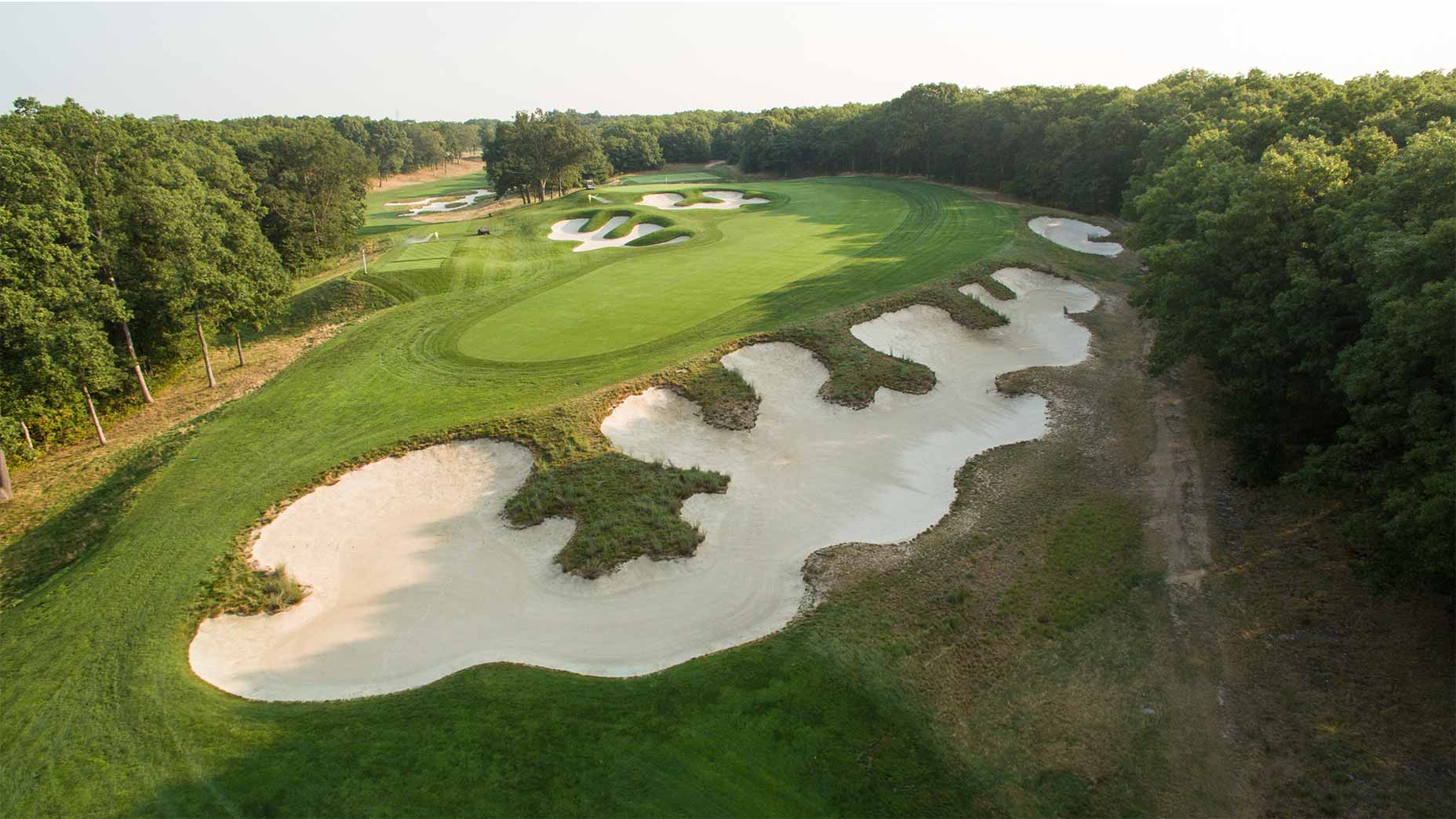
53. Bethpage (Black)
The Black intimidates golfers with a sign at the 1st tee that recommends the course “only for highly skilled golfers.” Among them? Tiger Woods, who won the 2002 “People’s Open,” as that U.S. Open came to be known. Woods was the only golfer to break par for 72 holes, owing to rugged, uphill par-4s, massive bunkers and the wrist-fracturing rough found on this Rees Jones-restored A.W. Tillinghast layout. The Black is one of the great routings, highlighted by the masterful way Tillinghast placed the fairways and greens from the 2nd hole in a valley all the way through the dogleg left 9th. The par-5 4th and its iconic cross-bunkering is a world-beater. (Photo: Getty Images)
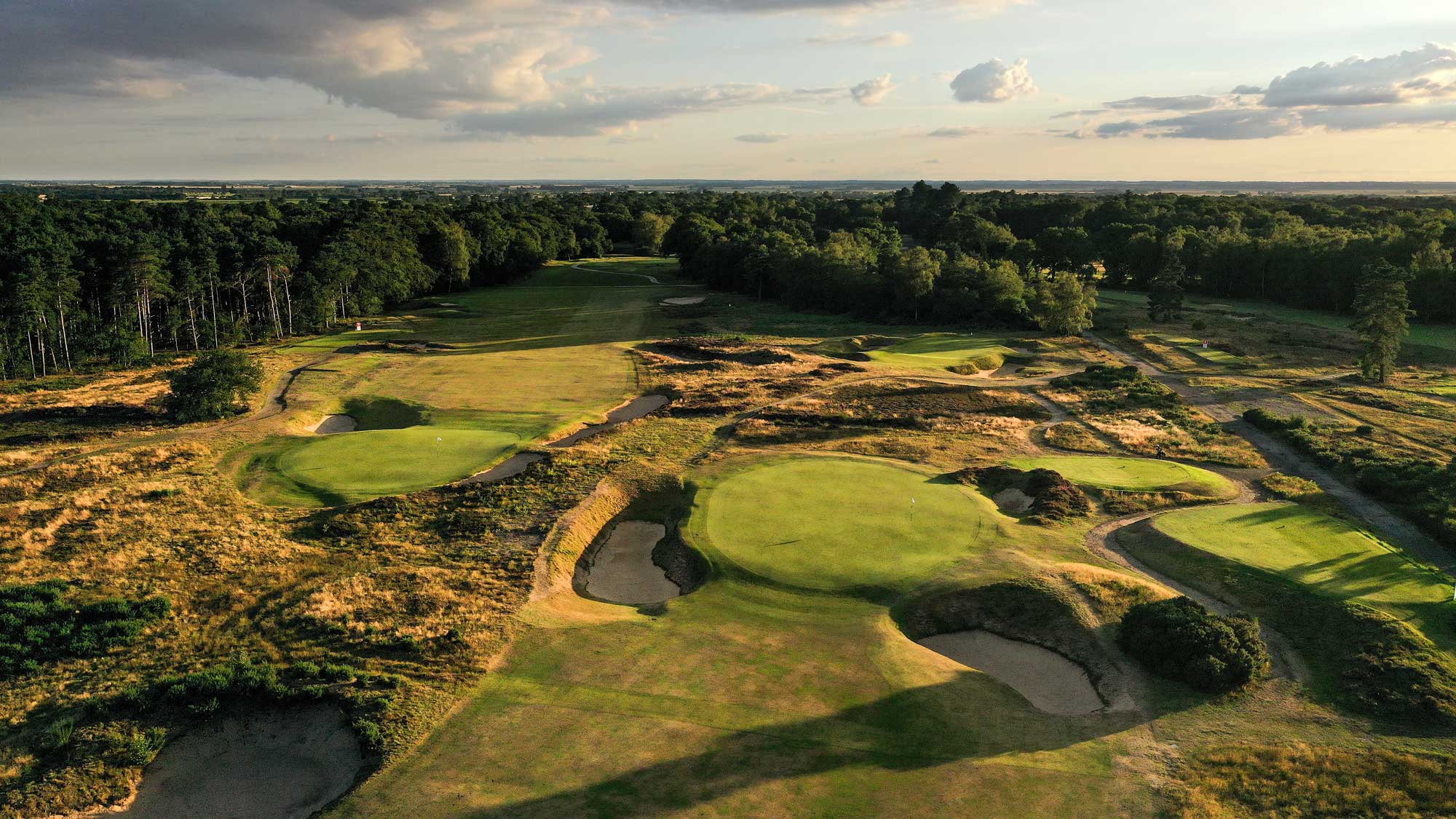
54. Woodhall Spa (Hotchkin)
Credit architects H.S. Colt and S.V. Hotchkin for enhancing Harry Vardon’s initial work and turning the course into one of golf’s supreme inland delights, an oasis amid the surrounding flat fenland of Lincolnshire. Deep bunkers are Woodhall Spa’s defining trait, along with plentiful gorse and a stellar set of par-3s. (Photo: Courtesy Woodhall Spa)
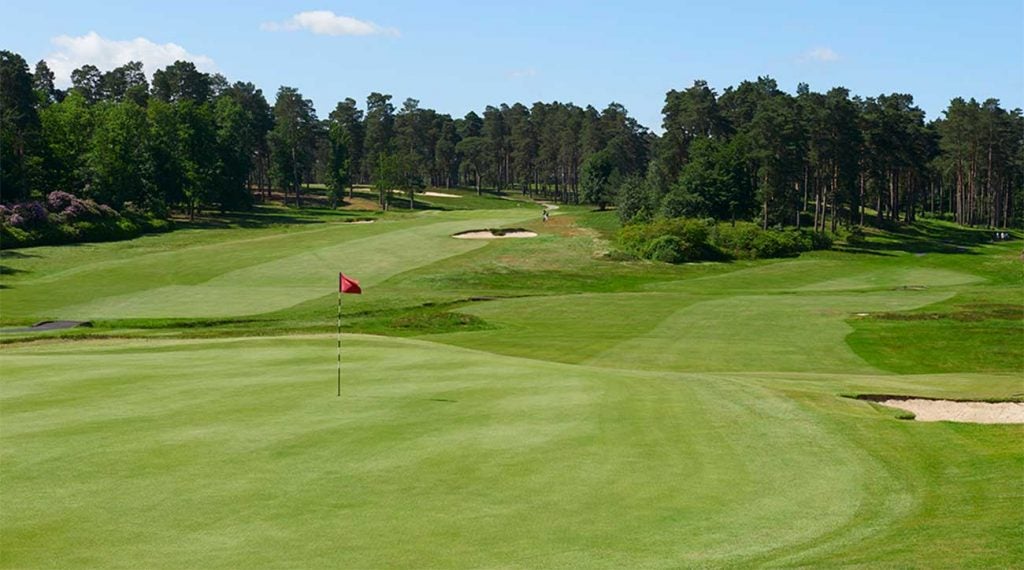
55. Swinley Forest
Unlike America, England doesn’t have a phobia about courses with par under 70. Seeing a 6,431-yard, par-69 course like Swinley Forest be embraced as an epitome of great design is a powerful message. Like Rye, its quintet of one-shotters and tight sub-70 par make it more of a complete test than a quick glance at its scorecard might indicate. The more the world speeds up, the more people appreciate clubs like Swinley where calm reigns supreme. (Photo: Courtesy Swinley Forest)
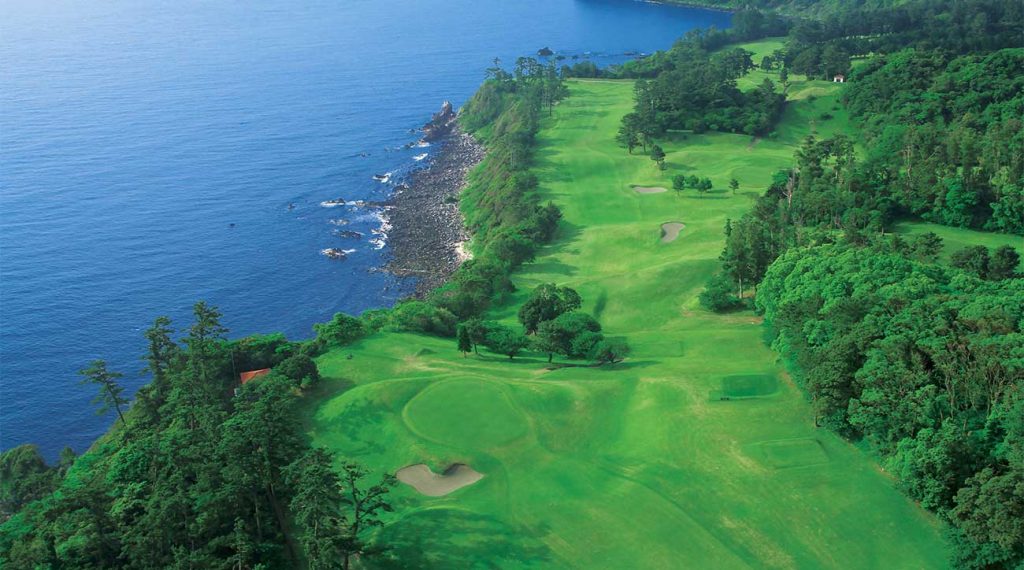
56. Kawana (Fuji)
Japan’s answer to Pebble Beach is this 1936 design that boasts staggering views of snow-capped Mt. Fuji and cliff-top panoramas of the Pacific Ocean. Alison’s superb bunkering and strategies mix with undulating terrain that make it worth the three-hour trip from Tokyo. Recent tree clearing along the perimeter has enhanced the site’s phenomenal coastal setting. (Photo: Courtesy Kawana)

57. Ballyneal
Founding a private club in a remote destination is not without peril and it is reasonable to expect a club to take some time find its footing. Now well in its second decade, Ballyneal enjoys its finest playing conditions since opening. Fescue fairways help the ground-game options flourish as balls release across the rumpled ground. Often on a Tom Doak course, the best way to get a ball close to the hole requires both imagination and creativity. That’s true in spades here as players delight in finding creative ways to use banks and punchbowl features.
(Photo: Evan Schiller)
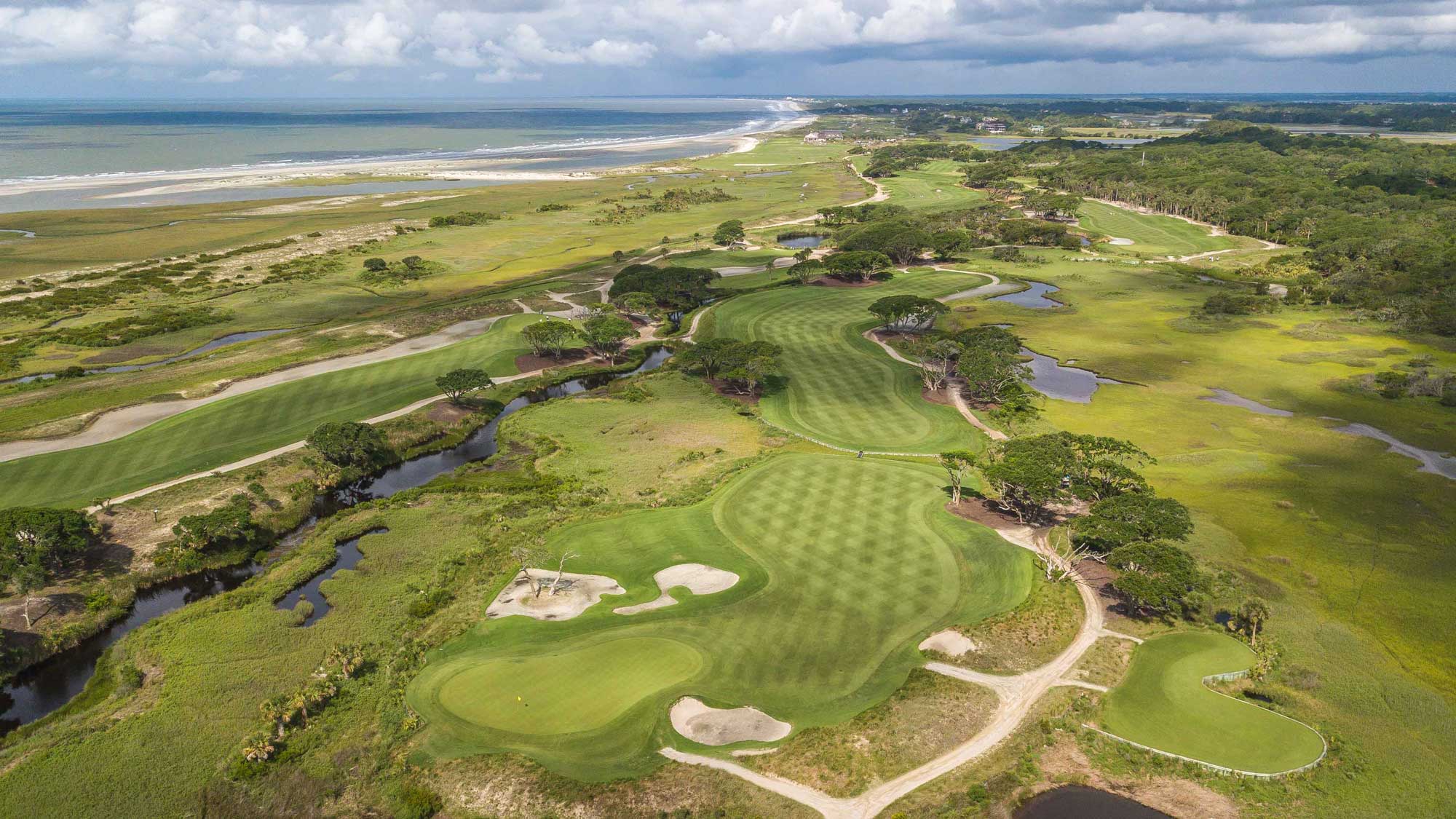
58. Kiawah Island (Ocean)
The blend of tidal marshes, scrub-topped dunes, live oaks and the soothing sound of the Atlantic on every hole make this one of the South’s most memorable playing experiences. Though the course just turned 30 years old, it already has an illustrious history of hosting big-time events, none more memorable than the drama-filled 1991 “War by the Shore” Ryder Cup. Much more short grass has been added around the green complexes since then and now the design is more thought-provoking rather than terror-inducing. Many of its greens are plateaued, with some of the more pronounced coming on the 3rd, 11th and 14th holes. Phil Mickelson more than handled the putting surfaces on his way to his historic win at the 2021 PGA Championship. (Photo: Courtesy Kiawah Island Resort)
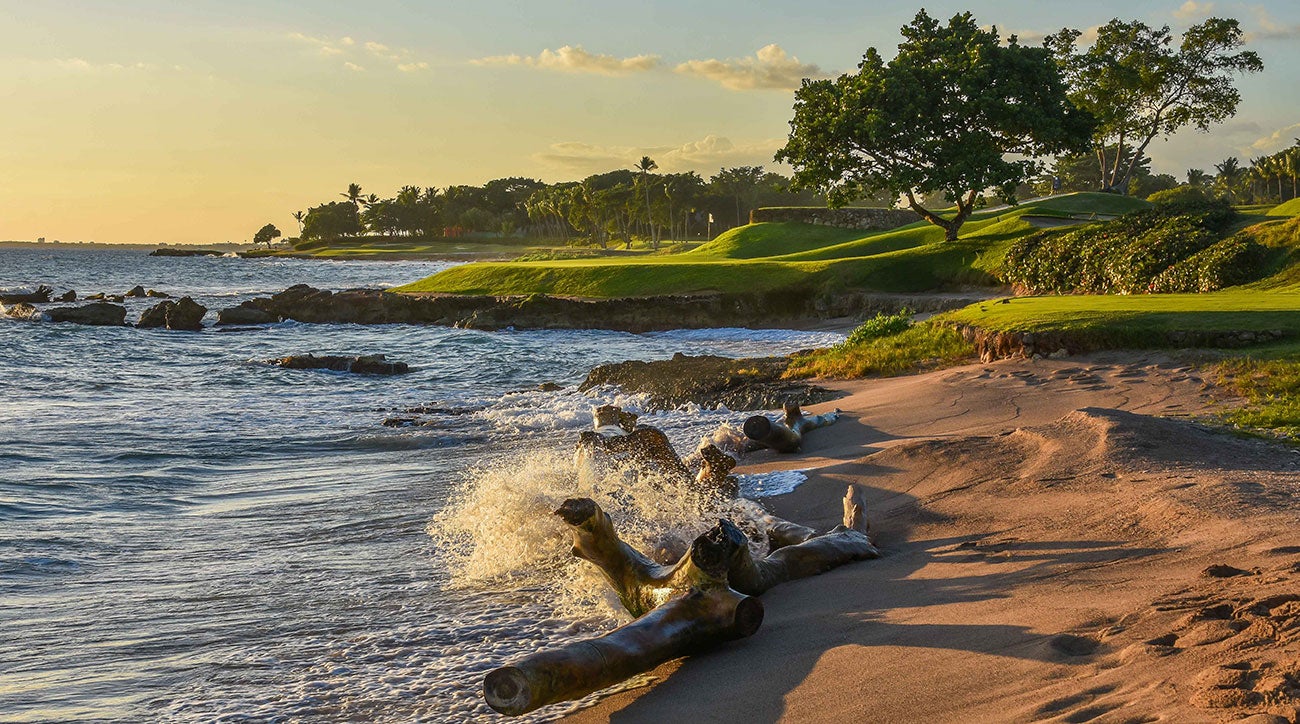
59. Casa De Campo (Teeth of the Dog)
Founder Alvaro Carta deserves credit for hiring Pete Dye in 1970 to build this centerpiece attraction for his retreat and then allowing him to have nearly three miles of coastline with which to work. The construction process was slow going as jungle brush needed to be beat back with machetes. Machinery was prohibitively expensive to import, so 300 Dominicans assisted. Ultimately, Dye found a way to place eight holes along the shoreline, three of which are par-3s that from the back tees require heart-pounding shots over the azure water; the fourth par-3 (No. 13) was Dye’s first island hole with its built-up green pad surrounded by a sea of sand. This low-profile course has aged gracefully and remains in the conversation for Dye’s best work. (Photo: Patrick Koenig)
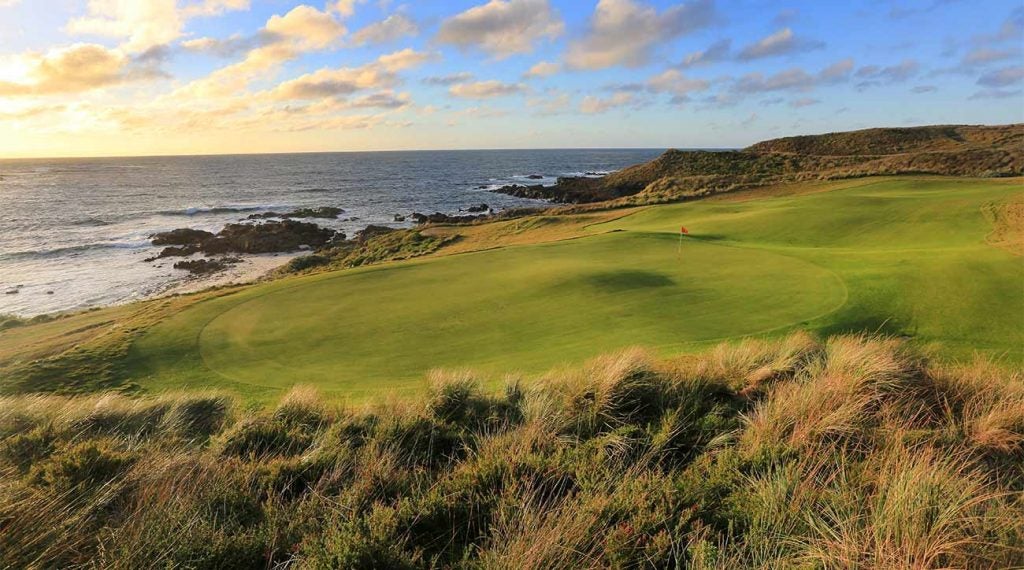
60. Cape Wickham
Wickham wows with an opening stretch of seaside headland holes, three par-3s that skirt the sea and a Cape-style 18th that demands a bite-off-as-much-as-you-dare drive over Victoria Cove. Set on the northern end of King Island in the Bass Strait between Tasmania and mainland Australia, this course occupies the windiest spot of any on our list. Wickham compensates with wide landing areas and greens that are open in front, meaning golfers are guaranteed to have fun, be they in a one-club wind — or five! (Photo: Gary Lisbon)

61. Royal Lytham & St. Annes
Regardless of whether the wind is blowing or what technology does, Lytham’s 205 bunkers mean that this rugged links is always ready to test the best, just as it has done since 1926 when it played host to its first Open Championship. One of those bunkers, in the left-center of the 18th fairway, cost Adam Scott the 2012 Open. Indeed, the entire 18th hole is a master class in how to stagger fairway bunkers to create playing interest and should be recognized as one of the game’s top dozen finishers. No one was better at getting out of jail than Spain’s Seve Ballesteros, who twice won here in glorious fashion. (Photo: Kevin Murray)
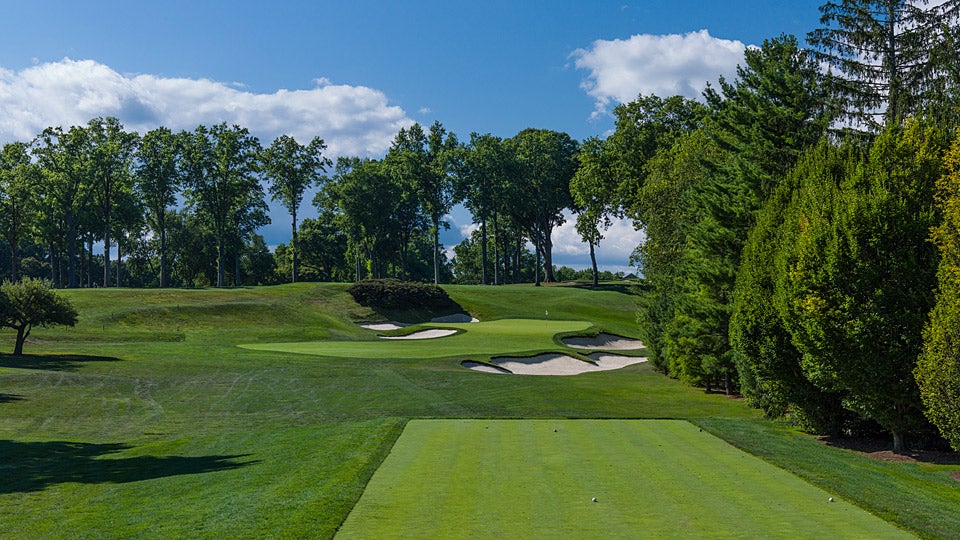
62. Winged Foot (East)
Neither as long nor as tough as its illustrious West sibling, the East enjoys its own devoted fanbase for its variety and the encouraging manner in which ground game options are now presented. Great attention has been paid to the mow lines, with short tight fairway grass on the high side of the entrance to all the greens. More than a few Winged Foot devotees consider the 13th and 17th the best par-3s on the property, a seemingly outlandish claim until you play them. Spend time putting on greens like the 1st and 11th and you will wonder what A.W. Tillinghast understood about green construction that eludes other architects. (Photo: LC Lambrecht)
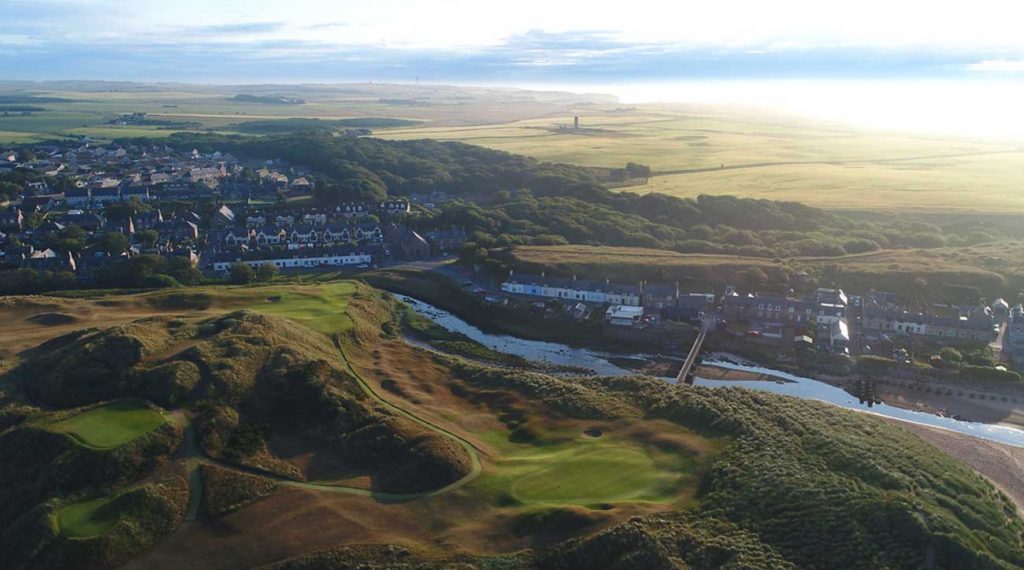
63. Cruden Bay
This cult classic is a personal favorite of both Pete Dye and Tom Doak. Twenty-three miles north of Aberdeen, Cruden Bay offers many novel features, including the postcard-perfect par-3 4th, which overlooks the Water of Cruden and the fishing village of Port Erroll, and the par-4 14th, with its funnel-shaped bathtub green. The 4th kicks off a five-hole stretch that any links course would love to claim as its own, so wildly varied and well conceived is each hole. (Photo: Gary Lisbon)
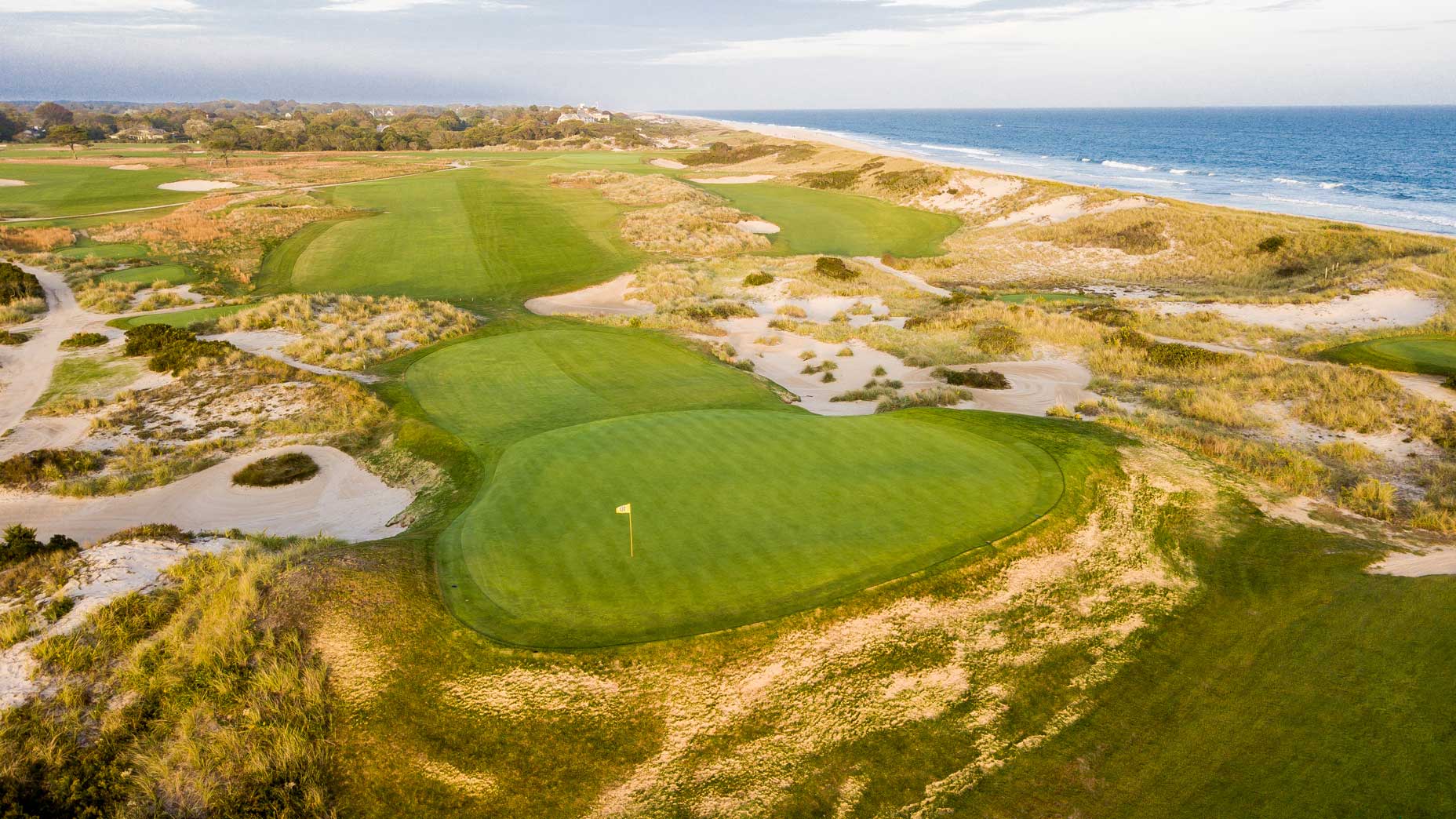
64. Maidstone
Maidstone’s glorious edge-of-the-Atlantic location is once again fully evident, thanks to a recent restoration by Coore & Crenshaw. Maintaining coastal dunes is an art form: expose too much sand and it blows away; cover it up and you lose a sense of place. Maidstone has struck the perfect balance. Adding to the pleasure of its romantic location is an exceptional set of Willie and John Park greens, many of which feature dramatic false fronts. Maidstone is a dream course to play regularly, in part because its asks change daily with the weather. (Photo: Patrick Koenig)

65. Royal Liverpool
“Hoylake,” as it’s popularly known, welcomed its 12th Open Championship in 2014. It’s not a pretty course in the conventional sense, as there are no lighthouses, mountains or majestic undulations. But its fairways are rumpled and its revetted bunkers are well placed and invariably extract a ½-shot penalty. There’s also internal out-of-bounds, a feature for which the course is well known. When the wind is up, Hoylake is one of the game’s fiercest links, one that requires supreme shotmaking, as demonstrated by Tiger’s virtuoso performance at the 2006 Open. (Photo: Courtesy Royal Liverpool)
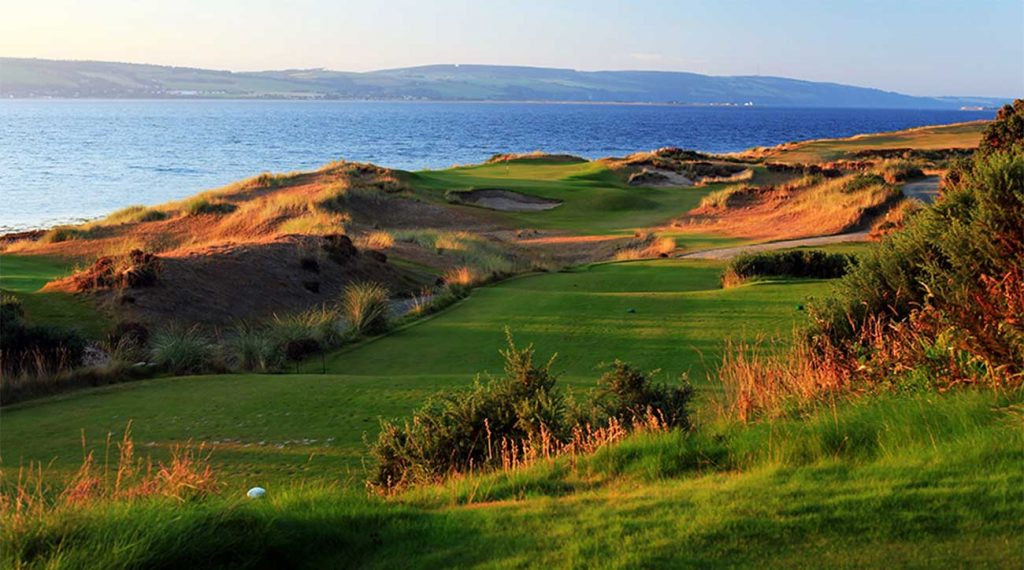
66. Castle Stuart
GOLF Magazine’s Top New International Course of 2009 has maintained its early lofty results thanks to a brilliant Gil Hanse/Mark Parsinen design that was effusively praised by Phil Mickelson — before Mickelson won the 2013 Scottish Open here. Highlights include wide fairways, wild and woolly bunkers and panoramic views of Moray Firth and the Scottish Highlands. Its thrilling finish features three consecutive ½-par holes where anything can happen: the drivable 16th, the brutish one shot 17th (which plays in the opposite direction as 16) and the par-5 18th, which cascades downhill toward the distinctive white art-deco clubhouse. (Photo: Getty Images)
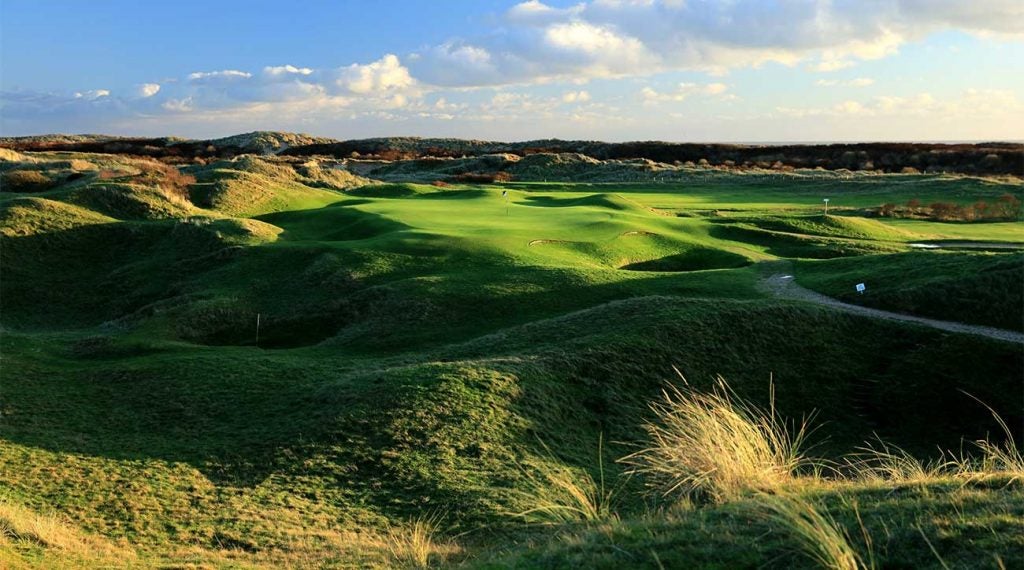
67. Rye (Old)
The opener is the easiest hole (and the course’s only three-shotter) and then … hold on! What follows are a dozen par-4s, 10 of which measure more than 420 yards, and an infamously diabolical group of five par-3s that have this 6,503-yard course weighing in yard for yard as one of the most difficult on our list. The fact that you can walk Rye in two and half hours makes you question the merit of courses that are so much longer. (Photo: Courtesy Rye)
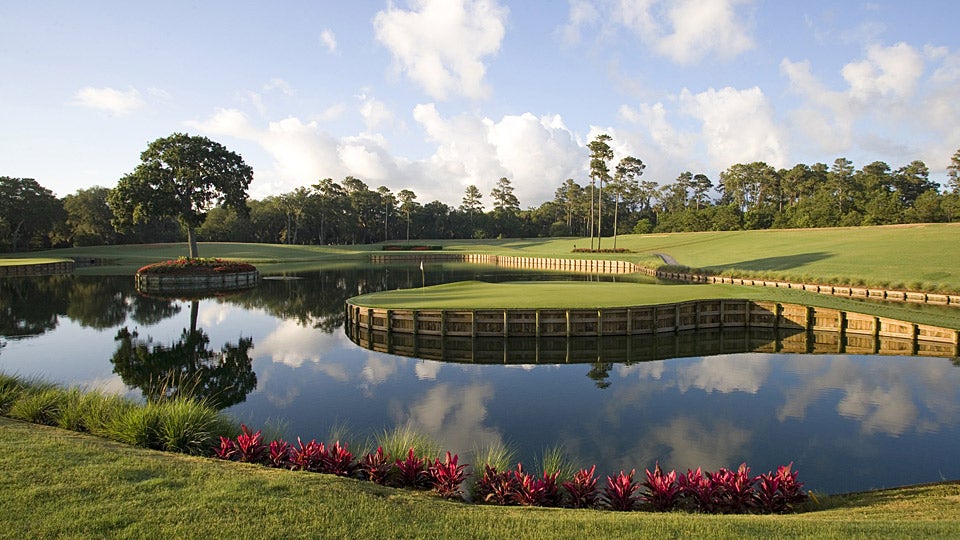
68. TPC Sawgrass (Stadium)
Some sniff at the artificiality of a course being hewn from a swamp, yet that’s also what makes the Stadium Course stand out from the crowd. Home of the Players Championship since 1982, the design has evolved into a handsome battleground (however you feel about the towering clubhouse), highlighting Pete Dye’s talent for envisioning something from nothing. The short par-4 4th, reachable par-5 11th and the long par-4 14th rank among Dye’s all-time best. For shotmaking options and memorable individual holes that require a blend of power and finesse, the Stadium Course has few peers. (Photo: Chris Condon/Getty Images)
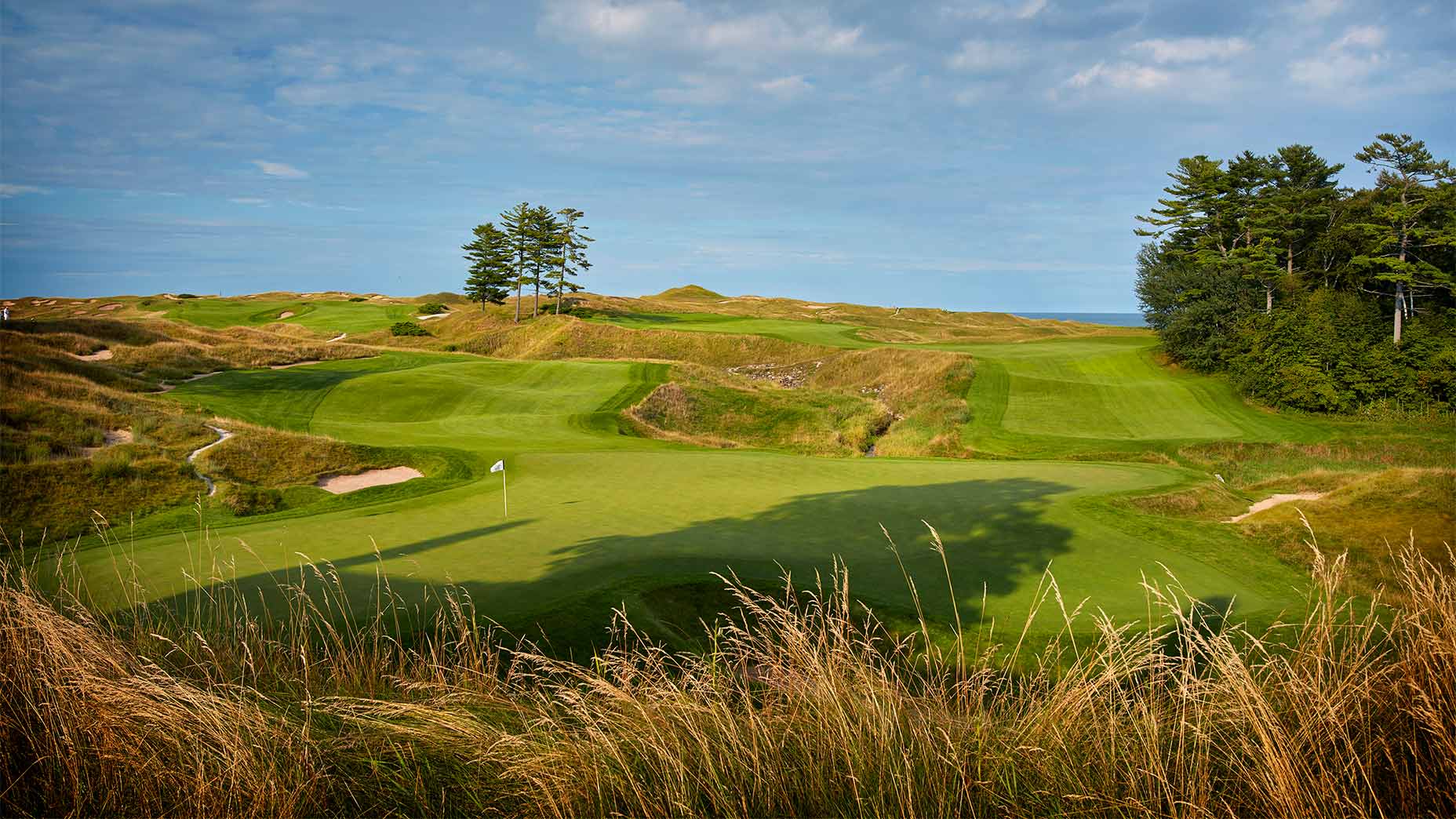
69. Whistling Straits (Straits)
Home of the 2004, ’10 and ’15 PGA Championships, this 1998 Pete Dye design on Lake Michigan was once a poker-table-flat military training base in World War II. Eventually it became a site for illegal dumping of toxic waste. Dye and owner Herb Kohler engineered a mind-boggling cleanup, moving 3 million cubic yards of dirt, trucking in 7,000 loads of sand to create the hills and bunkers and relocating the bluffs back off the shore. Kohler told Dye “I want the course to look like it’s in Ireland.” Mission accomplished. The 2021 Ryder Cup played here highlighted what a great match-play course it is, too, with its plethora of ½-par holes. (Photo: Getty Images)
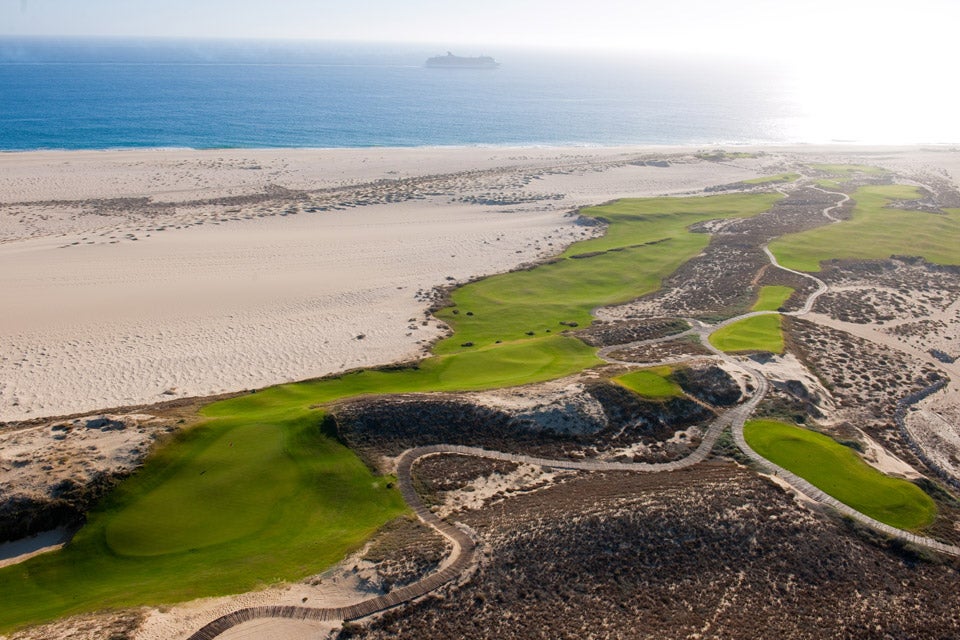
70. Diamante (Dunes)
Diamante’s free-form architecture rests gently on the land, and the absence of any hard lines let the golfer’s eye soak in the delightful contrast between the dazzling Pacific Ocean, the dunescape and the emerald playing surfaces. The Dunes’ random green contours are noteworthy as is the construction technique that left micro-undulations in the fairways. Spectacular ocean views sometimes come with the price of cold and damp playing conditions but not here. (Photo: Brian Morgan)
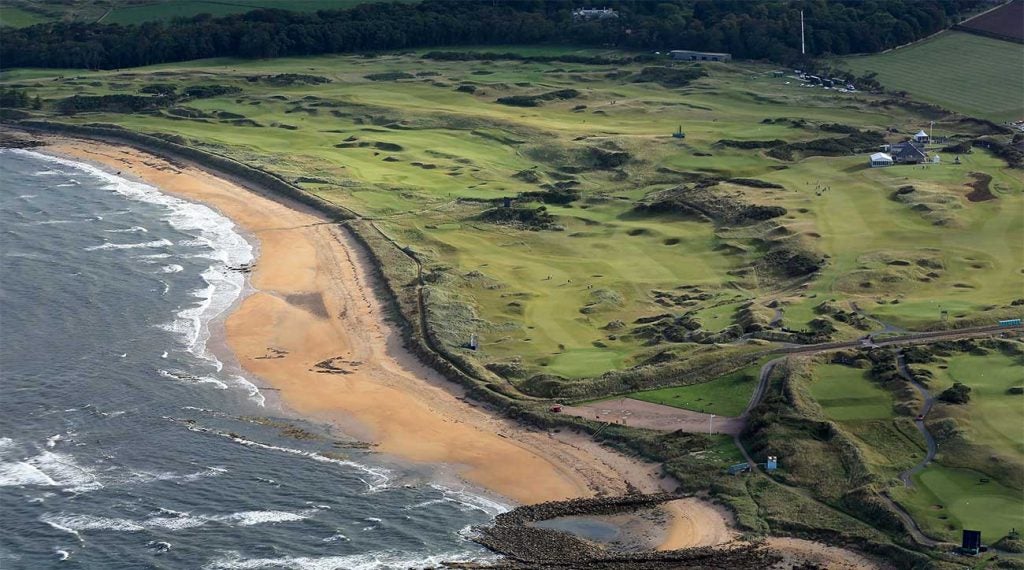
71. Kingsbarns
This 1999 Kyle Phillips design 15 miles from the Old Course has earned the respect of links fans, who can be a tough bunch as they generally travel to the United Kingdom to play courses that are 100-plus years old. There is much to admire here, including the 606-yard, par-5 12th, which arcs around the bay, and the 212-yard, par-3 15th that demands a carry over the sea. Others might relish the shelf green at the 9th that poses similar intriguing questions as the 12th at the Old Course. Kudos to Phillips as the seamless melding of flat farmland and Old World links contours is quite the design accomplishment. (Photo: Courtesy Kingsbarns)
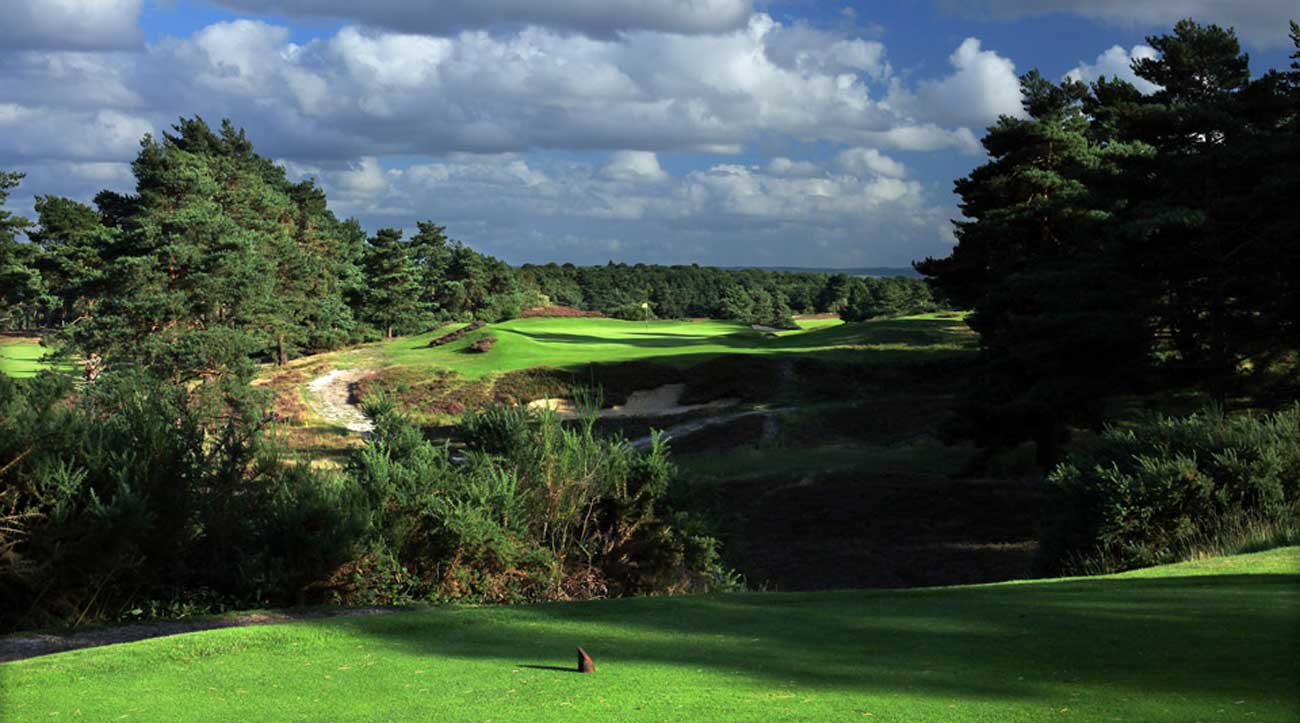
73. Sunningdale (New)
H.S. Colt’s 99-year-old companion to its charming elder, the Old, stands on its own merits. In fact, some golfers prefer the more muscular New Course to the Old. Heathland golf around London is famous for all sorts of reasons but the strength of its par-5s isn’t one of them. Two of the New’s par-5s — the 6th and 13th — are exceptions and anchor each nine. Additionally, the best par-3 at the club is found on the New (its 5th, which plays from high point to high point across a heath-laden shallow valley). The par-4s run the full gamut, from the beefy 4th that rewards a fade off the tee and a draw for an approach to the sub-400 yard gem 12th, which plays to a plateau green. (Photo: David Cannon/Getty)
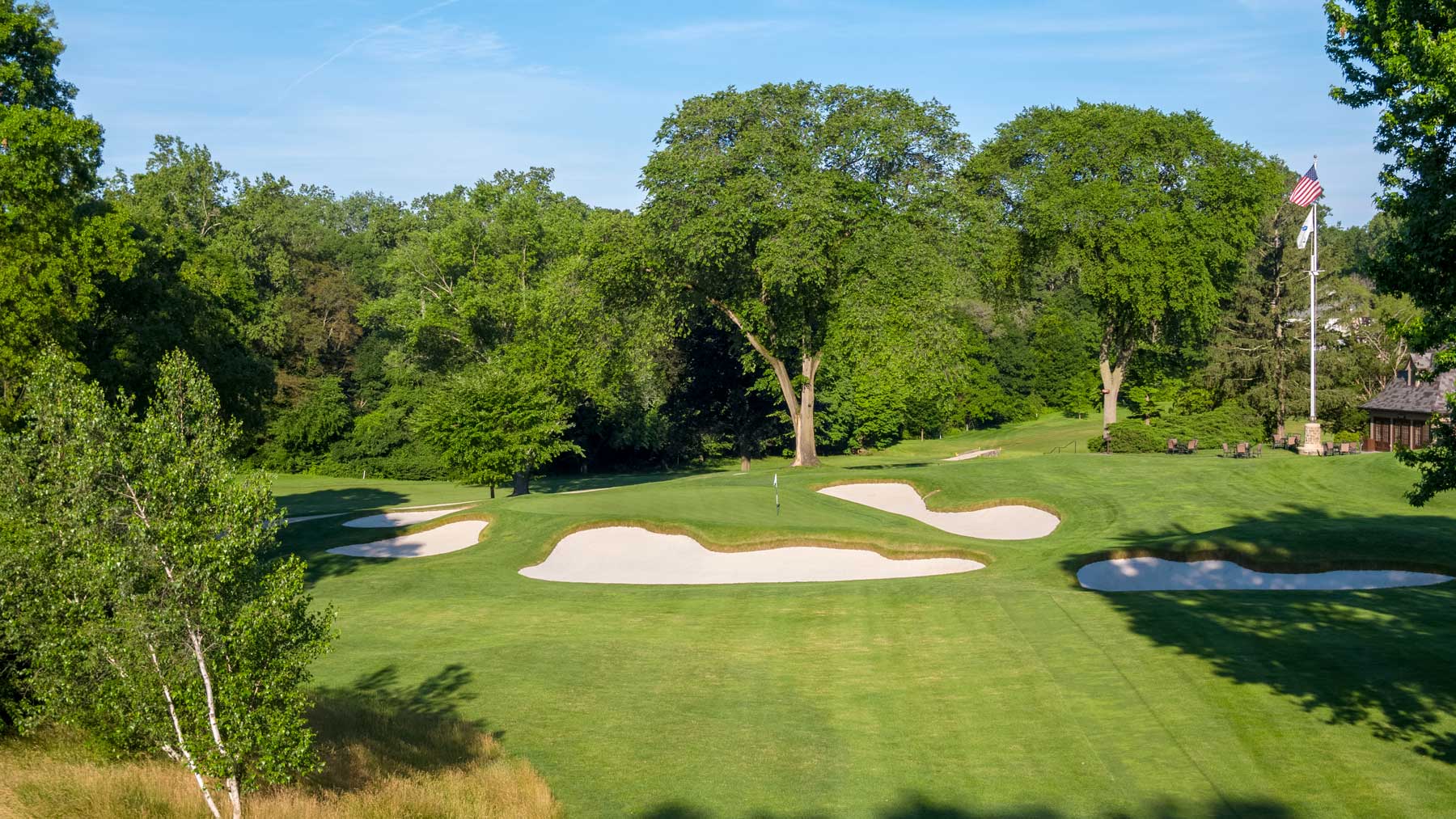
74. Quaker Ridge
This quiet club across the street from Winged Foot has counts Jack Nicklaus and Pete Dye among its admirers. Its outstanding cluster of gently rolling par-4s, notably the 6th and the 11th, provided a terrific canvas for amateurs such as Justin Rose and Jason Gore in the 1997 Walker Cup. Dating to 1916, the course was made over by A.W. Tillinghast in 1926 and Gil Hanse’s restoration this past decade has the course at peak. The par-3 9th is one of the hidden gem one-shotters in the Northeast, though it may take a few rounds to figure out why. (Photo: Evan Schiller)
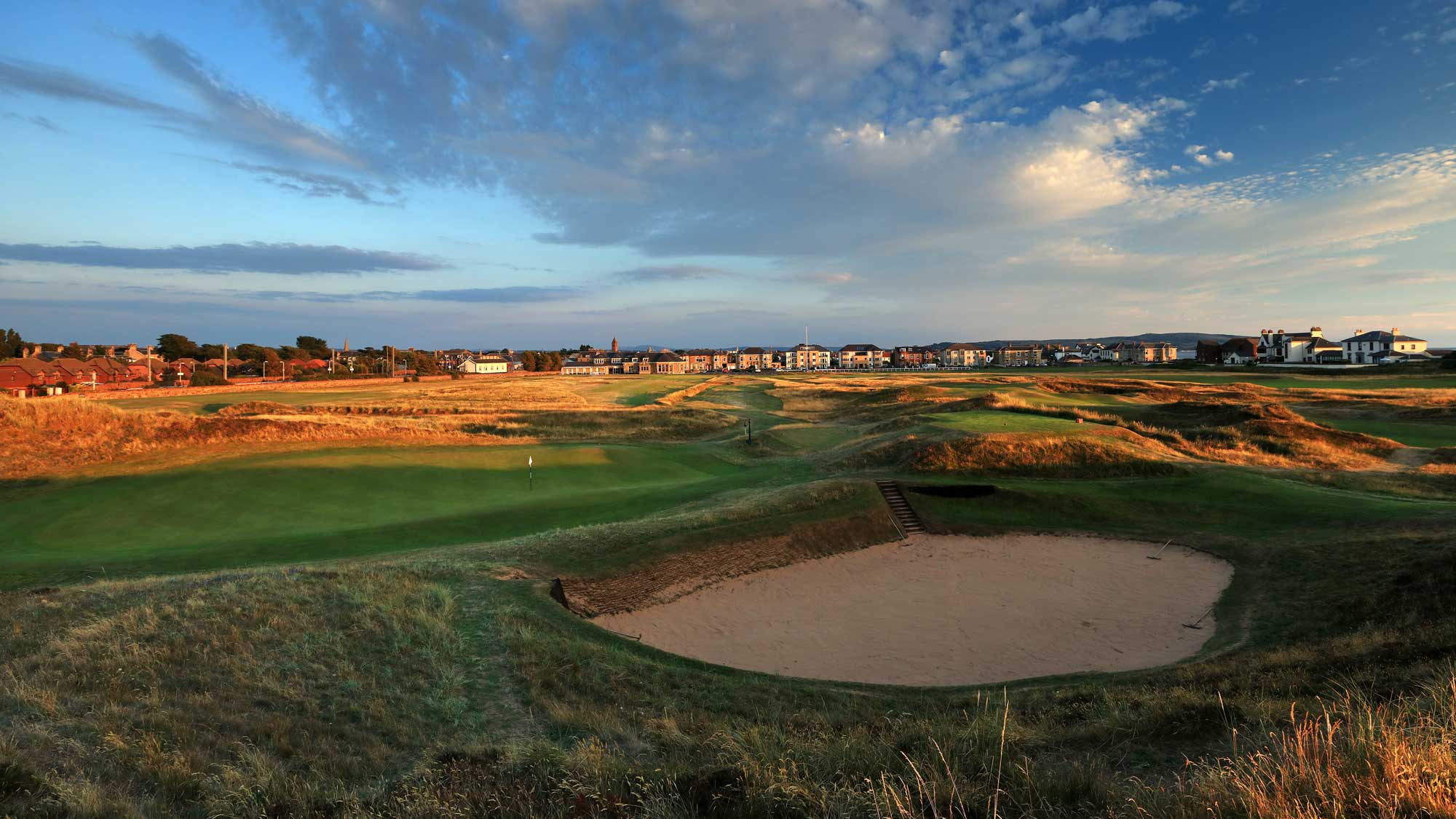
75. Prestwick
This host to 24 Open Championships (including the first 12) features an irresistible combination of quirk and muscle. The lumpiest/bumpiest ground is near the clubhouse and yields such marvels as the 1st with the stonewall and railroad line hard down the right of the fairway, the Narrows 15th and the famous Alps 17th. Meanwhile, a brawny collection of two-shotters dominates the stretch from 6-10. Add all the different asks together and you have a historic course like no other. The more you travel, the more you appreciate Prestwick’s unique charms. (Photo: David Cannon/Getty Images)
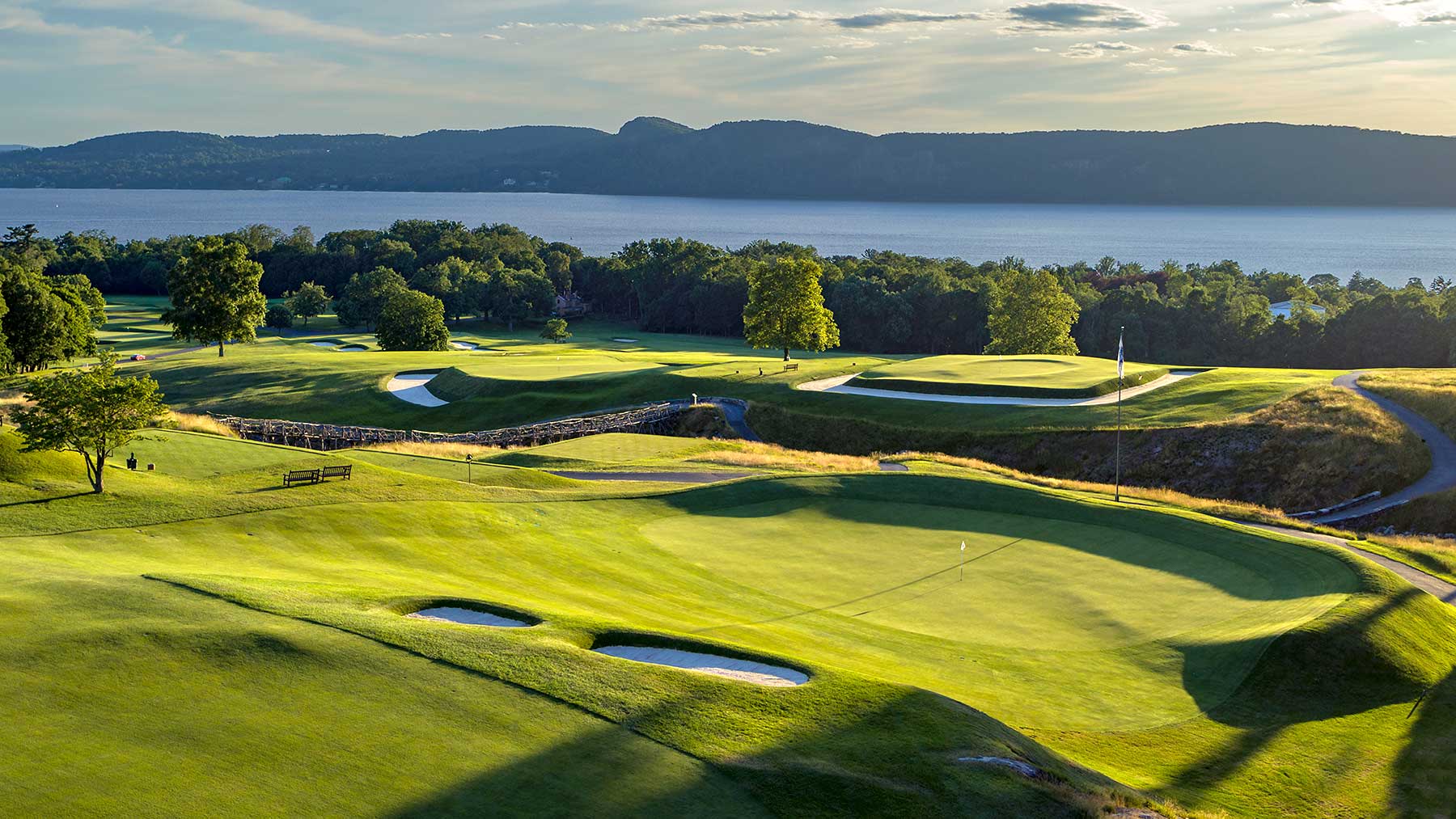
76. Sleepy Hollow
This Westchester County course has always enjoyed a spectacular component to it, courtesy of breathtaking views of the Hudson River, particularly at the 15th and 16th holes. What its holes lacked was playing interest from 50 yards and in. That changed in 2016 when Gil Hanse embarked on a two-year project to imbue the greens with a C.B. Macdonald flair that, well, even Macdonald would appreciate. (Photo: Evan Schiller)
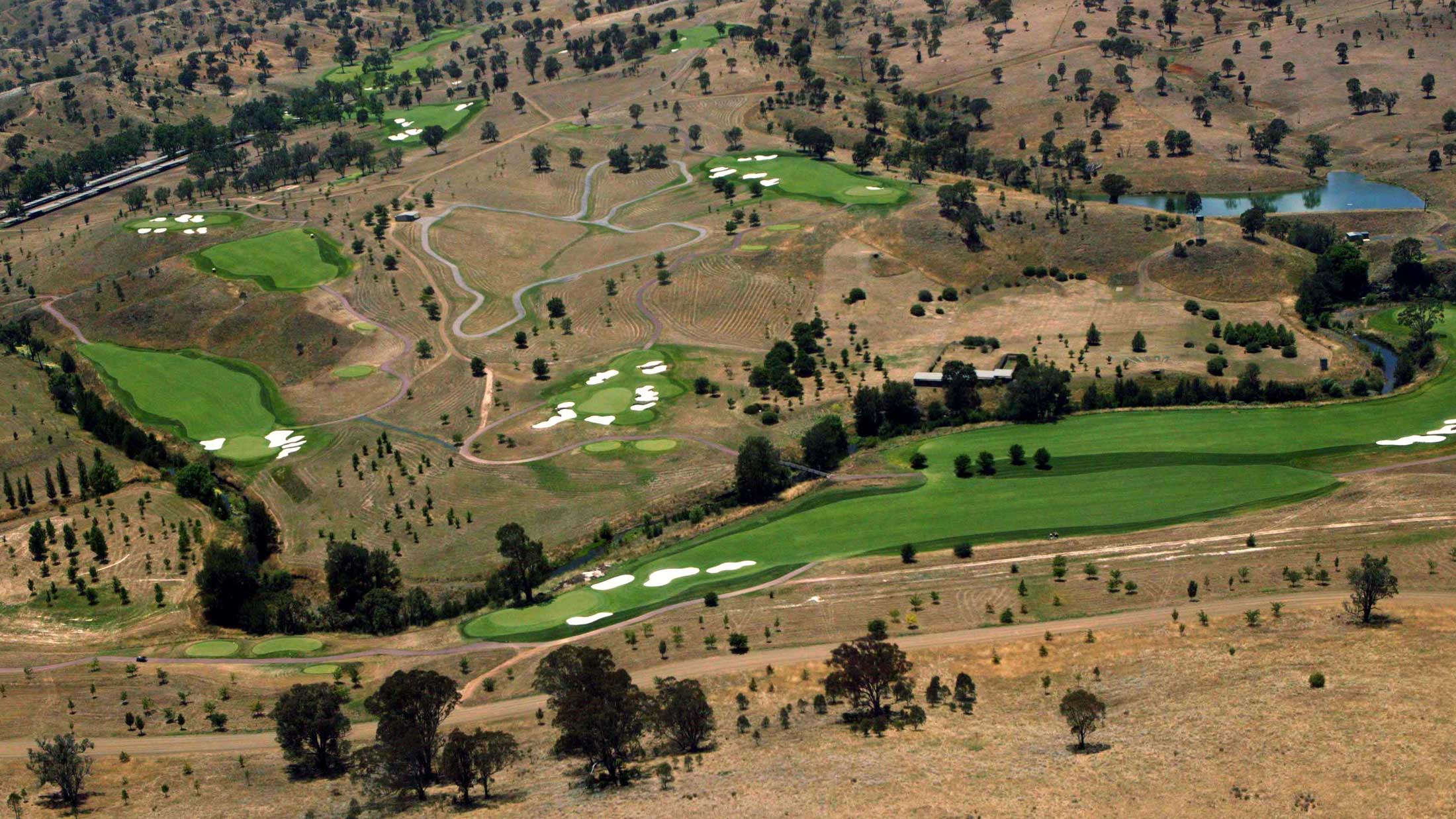
77. Ellerston
Greg Norman has never been shy about professing his admiration for Alister MacKenzie. At ultra-exclusive Ellerston, he and design partner Bob Harrison adapted MacKenzie strategies and bunker stylings on a rugged landscape, resulting in one of the strongest, most option-laden tests in the Southern Hemisphere. Forced carries over ravines, greens set along ridge-tops and the influence of Pages Creek add to the challenge. (Photo: Getty Images)
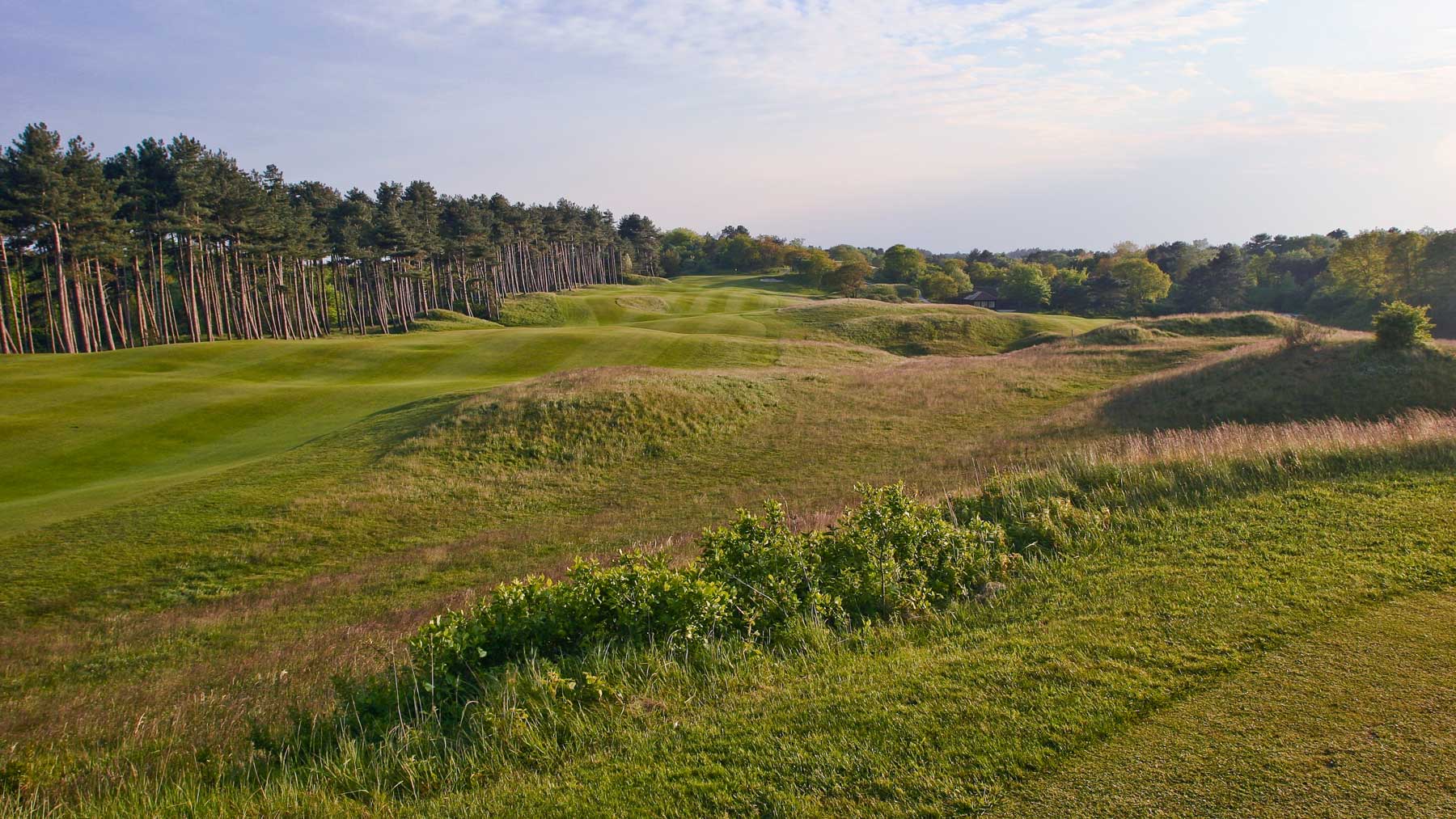
78. Koninklijke Haagsche (Royal Hague)
Better known to English speakers as The Hague, The Netherlands’ highest-ranking course is a Morrison-and-Alison collaboration that plays across chaotically heaving fairways amid substantial dunes. How they were able to connect all 18 holes without an awkward moment is a marvel. So, too, is the variety of its greens, headlined by the famous hard-to-hit knob green at 6 followed by a well defended, diminutive sunken green on the ensuing hole. (Photo: Frank Pont)
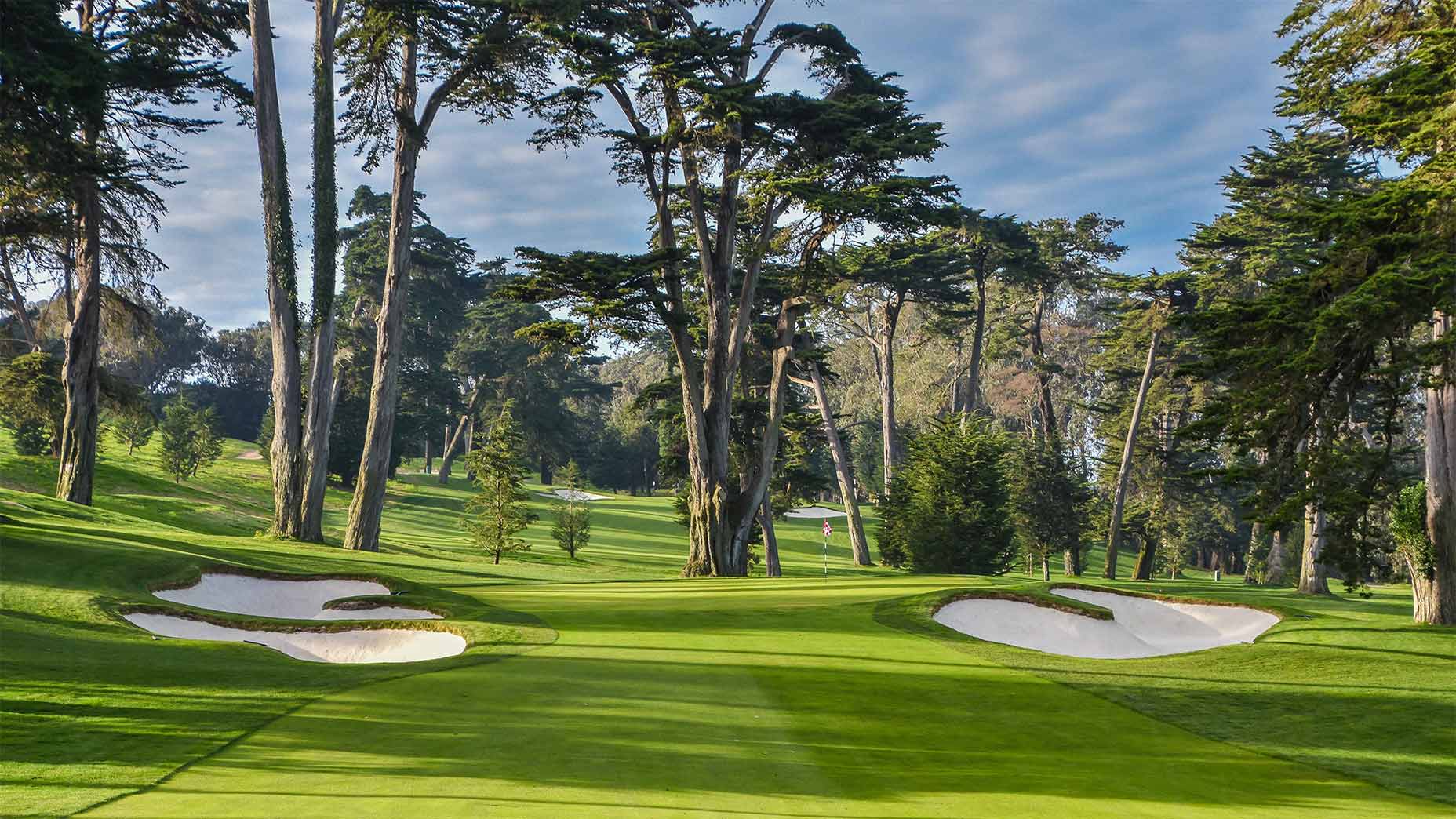
79. Olympic (Lake)
It’s always a delight to find a course that rewards the lost art of shaping shots. The 4th hole, for instance, features a reverse-camber fairway: the hole swings right to left but the fairway tilts left to right, mandating a draw from the tee. The next hole, a dogleg right, calls for a fade. Recent clearing has helped to highlight the stunning nature of the cypress trees that line this hillside overlooking Lake Merced. Its famous 5-5-short 4 closing stretch produced another climactic finish at the 2021 U.S. Women’s Open. Kudos to William Watson, who might well be the least appreciated important architect from the Golden Age. (Photo: Patrick Koenig)
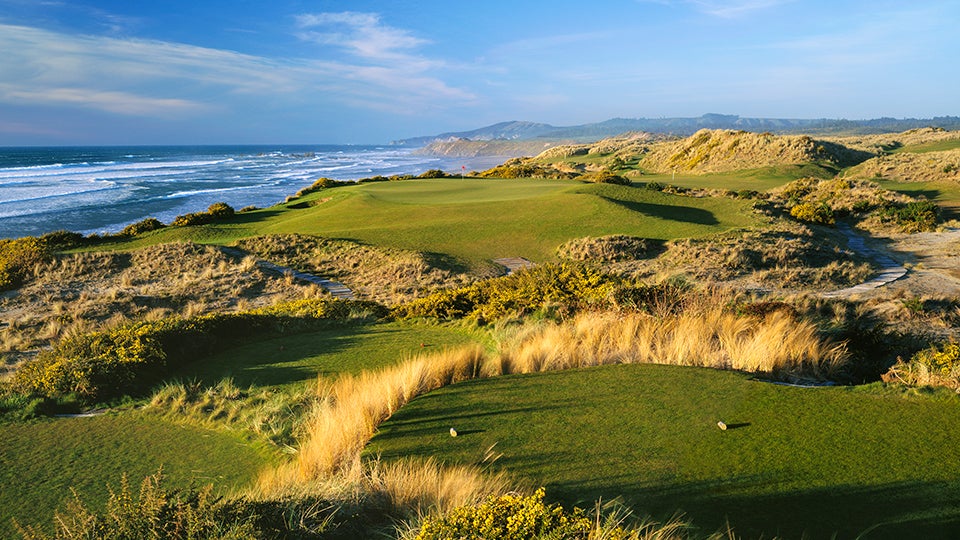
80. Bandon Dunes
Bandon’s original course is a David McLay Kidd design draped atop craggy headlands above the Pacific. Ocean views stun the senses, along with bluff-top sand dunes sprinkled with Scotch broom and gorse bushes, coastal pines, crashing surf, wind-whipped tall native grasses and stacked sod bunkers. The most memorable seaside tests are the par-4 4th and 5th, the par-3 12th and the drivable par-4 16th, each with eye-popping scenery and enjoyable risk/rewards. The 2020 U.S. Amateur telecast from here was captivating. (Photo: Wood Sabold)
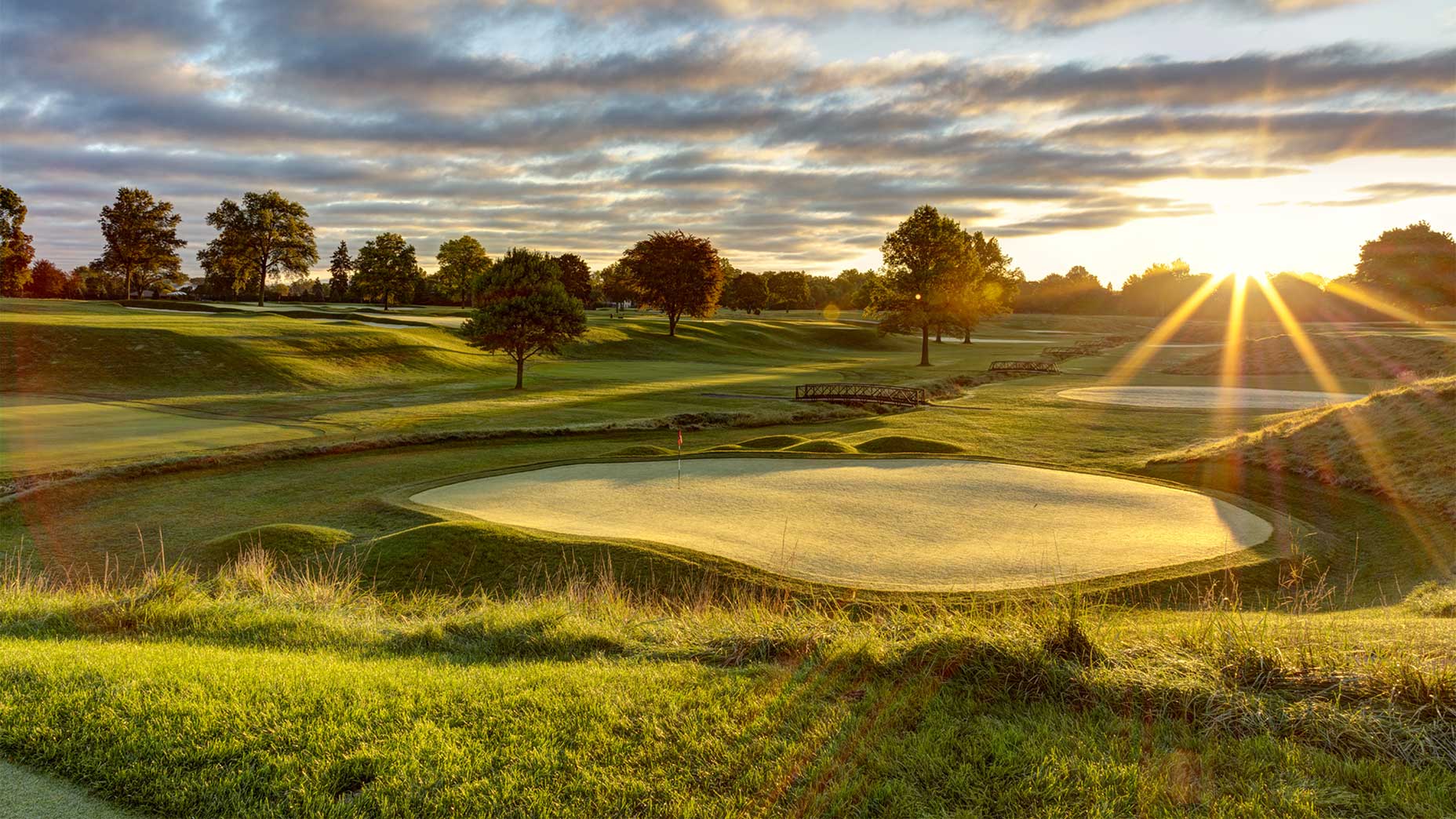
81. Inverness
Andrew Green’s renovation restored Ross features, expunged those that were not and added length to test today’s tournament players. Few courses can claim as sterling a set of two-shotters, headlined by the 6th, 7th, 9th, 15th, 17th and 18th holes. Inverness’s home hole famously measures under 400 yards and is one of the most interesting closers in the game. Too bad more modern architects are leery to build finishers that reward mind over muscle. (Photo: Courtesy Inverness)

82. Cabot Links
Developers Ben Cowan-Dewar and Mike Keiser handed over a rolling plot of coastal Nova Scotia terrain to Canadian architect Rod Whitman. The result is Canada’s first authentic links. Firm, rumpled, fescue fairways, coastal breezes and endless views of the Gulf of St. Lawrence make it abundantly clear why Nova Scotia is the Latin name for “New Scotland.” Whitman’s talent for adding micro-contours in and around the greens (such as those that promote running approach shots into the 13th and 16th) is unsurpassed but are overlooked here because the long views are so spectacular. (Photo: Brian Oar)
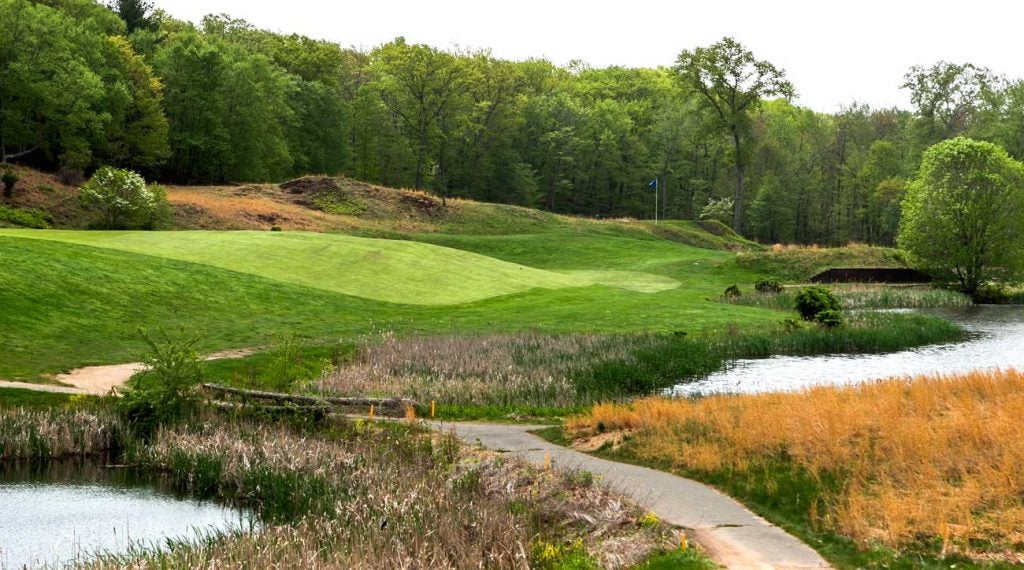
83. Yale
A herculean building effort by Raynor, Yale embodies the maxim that a world-class course must possess — you guessed it — world-class holes. There are plenty to pick from here, including the 1st, 4th, 8th, 10th and the love-it-or-hate-it 18th, but the hole everyone needs to see at least once in their life is the famous downhill Biarritz 9th. Who knew inland golf could be this exciting? (Photo: Steve Musco)
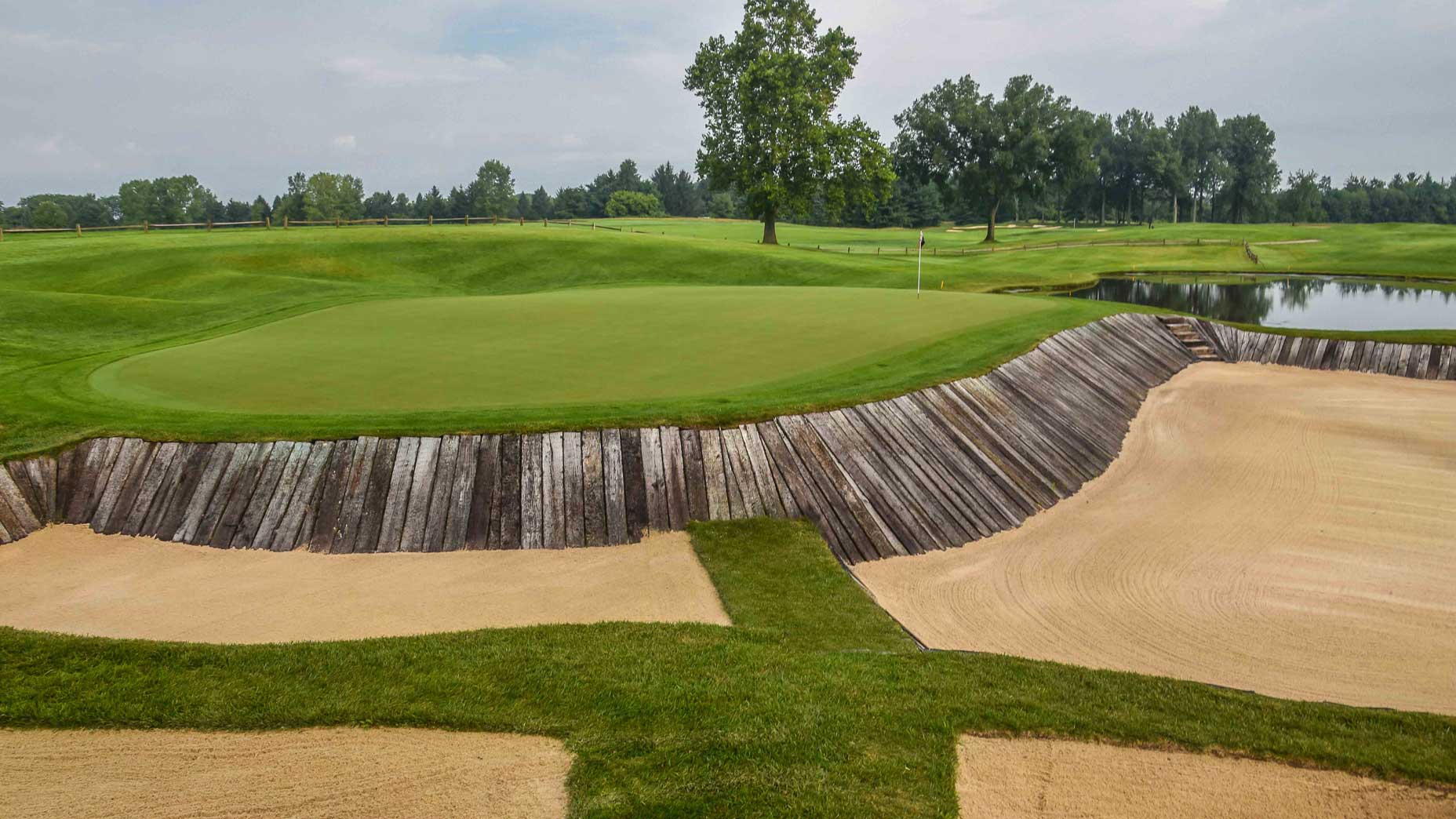
84. The Golf Club
One of Pete Dye’s early masterworks, this rural retreat built in 1967 in suburban Columbus is where Jack Nicklaus first learned about design, as an unpaid consultant. With bunkers and water hazards framed by railroad ties and tall native grasses scattered throughout, this thorough original left no doubt that Dye was a generational talent in the works. Golf simply hadn’t seen holes like the 3rd and 13th. Golf architecture was about to head in a more exciting direction, one that prized variety as well as the use of grasses for texture and contrast. Dye’s contributions to modern architecture can’t be overstated. (Photo: Patrick Koenig)

85. Muirfield Village
Conceived by Jack Nicklaus in 1966 to be his hometown equivalent of Bobby Jones’ Augusta National, this 1974 collaboration with Desmond Muirhead was an instant smash, both for its strategic design and flawless conditioning. Equally impressive was how Nicklaus seamlessly integrated spectator areas into the closing holes, using hillsides and amphitheater-style mounding to provide patrons with clear views of the action. Hard to imagine that the professionals now try to drive the sliver of green at 14 but that’s how much the game has changed — and yet the hole is still no easy par. That’s great architecture. Work over 2020 saw the unlikely happen: one of the best sets of par-5s on the list got even better. (Photo: Keyur Khamar/PGA Tour)
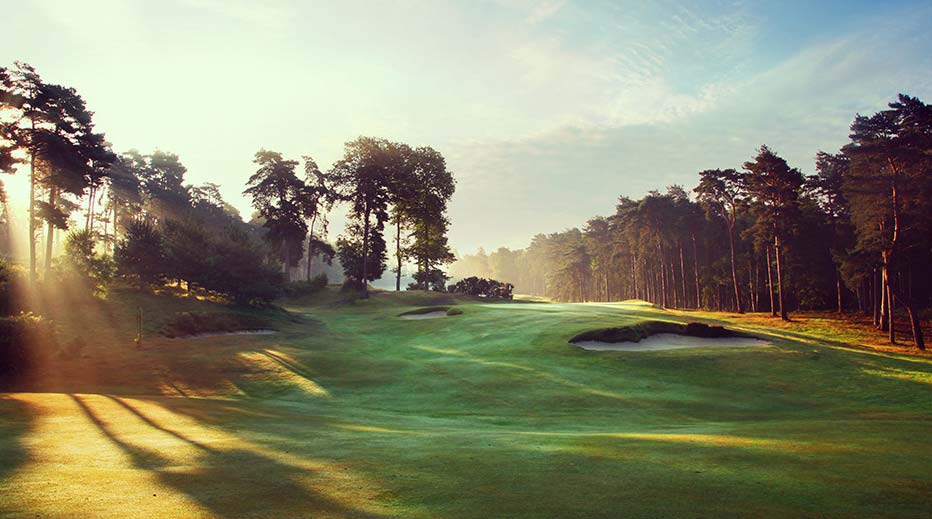
86. St. George's Hill (A & B)
From London’s heathland to the cliffs of Northern Ireland to sandy sites in the Netherlands, Colt enjoyed many fine sites in Europe over his extended career. One of the best is this property, where Colt teased a diverse collection of holes from the rolling landscape. His placement of the green sites — some on knobs or plateaus, some at ground level and the magnificent 10th green at the hole’s low point beyond a hillock — define the challenge. (Photo: Courtesy St. George's Hill)
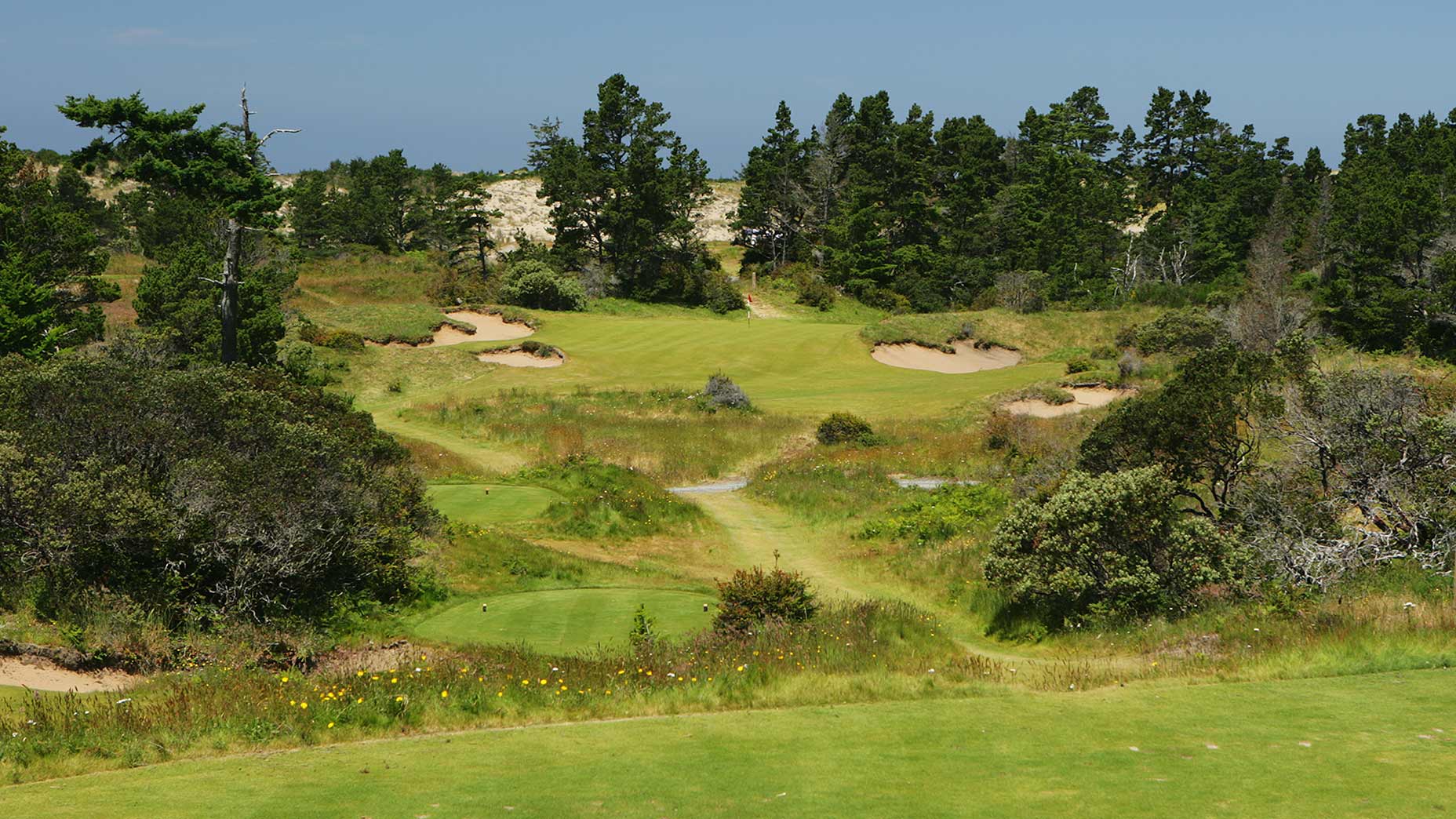
87. Bandon Trails
Several of Coore & Crenshaw’s finest designs are located at hard-to-access private clubs but many of their works thankfully are available to the public, often courtesy of developer Mike Keiser. Trails is one of their best — public or private. The routing works its way over and across heaving dunes and through an enchanting coastal forest, and the fact that you don’t miss the sight of the nearby water for most of the round speaks volumes to its design quality. The 3rd through the 5th is a particularly inspired stretch of inland golf, featuring an exemplary par-5, par-4 and par-3. (Photo: Getty Images)

88. De Pan (Utrechtse)
Modern architecture did itself no favors by pursuing holes that constantly scream at the golfer, because at some point the golfer goes tone deaf. Colt never went down that path and thus his courses enjoy timeless appeal. Here, he did what he did best: produce a course that is a delight to play every day. De Pan may not have the topography of St. George’s Hill but it does have sand dunes throughout the property. A master router, Colt incorporated the dunes in every way possible. (Photo: De Pan)
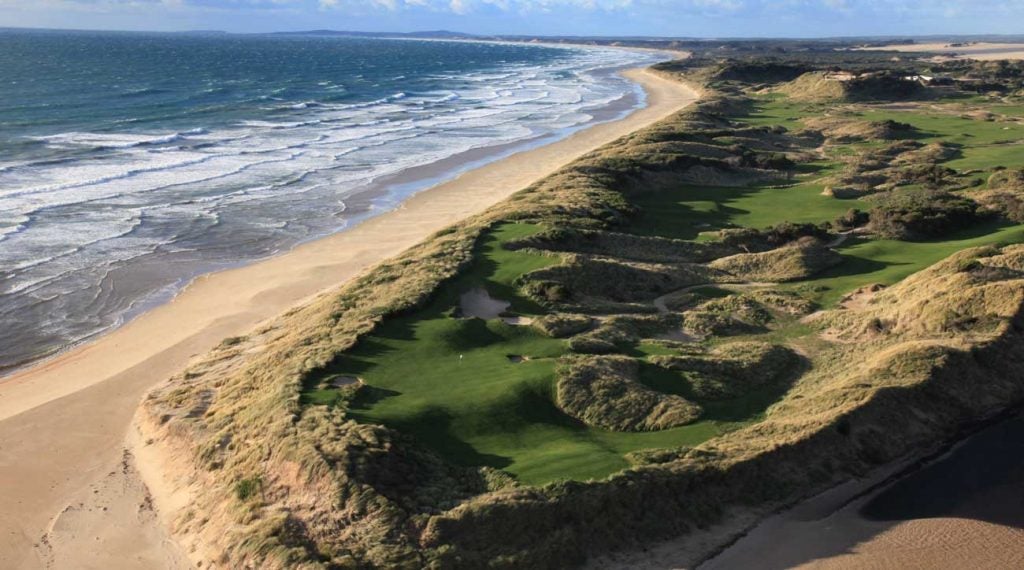
89. Barnbougle (Lost Farm)
The companion to Barnbougle Dunes yields a Coore & Crenshaw design that differs from its Tasmanian sibling in that its huge dunes run both parallel and perpendicular to the ocean so holes play up and over the dunes, as well as between them. The exposed, gorgeous par-3 4th that juts out to the tip of Sally’s Point invites comparisons to Pebble Beach’s famous 7th. (Photo: Gary Lisbon)

90. Walton Heath (Old)
The course’s stark, open-plain setting is the definition of a heathland, and as a test of character and shotmaking, Walton Heath has few peers. A strategic delight, it is stern but fair, with heather, gorse, rough and penal, high-walled bunkers that must be avoided. The acidic soil is free-draining, allowing for firm fairways that yield plenty of links-like run, and its open expanse means that wind is likely a consideration. Walton Heath was the venue of the 1981 Ryder Cup, when arguably the strongest American side of all time demolished the Europeans, 18.5 to 9.5. (Photo: David Cannon/Getty Images)
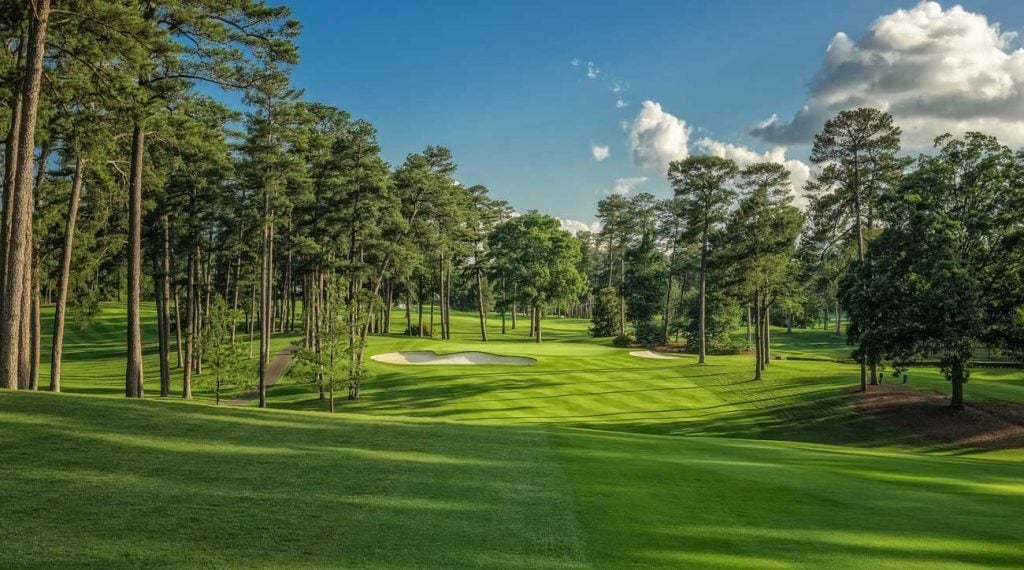
91. Peachtree
Built in the late 1940s, this Robert Trent Jones Sr. design came before he acquired his Oakland Hills “monster” rep. More of Stanley Thompson’s influence is seen in Jones’ early work, highlighted here by his imaginative — and enormous — punchbowl green at the 10th. Seventy-five years later and this Georgia course still adheres to the founding vision, which speaks volumes to the quality of RTJ’s original design. (Photo: Dave Samson)
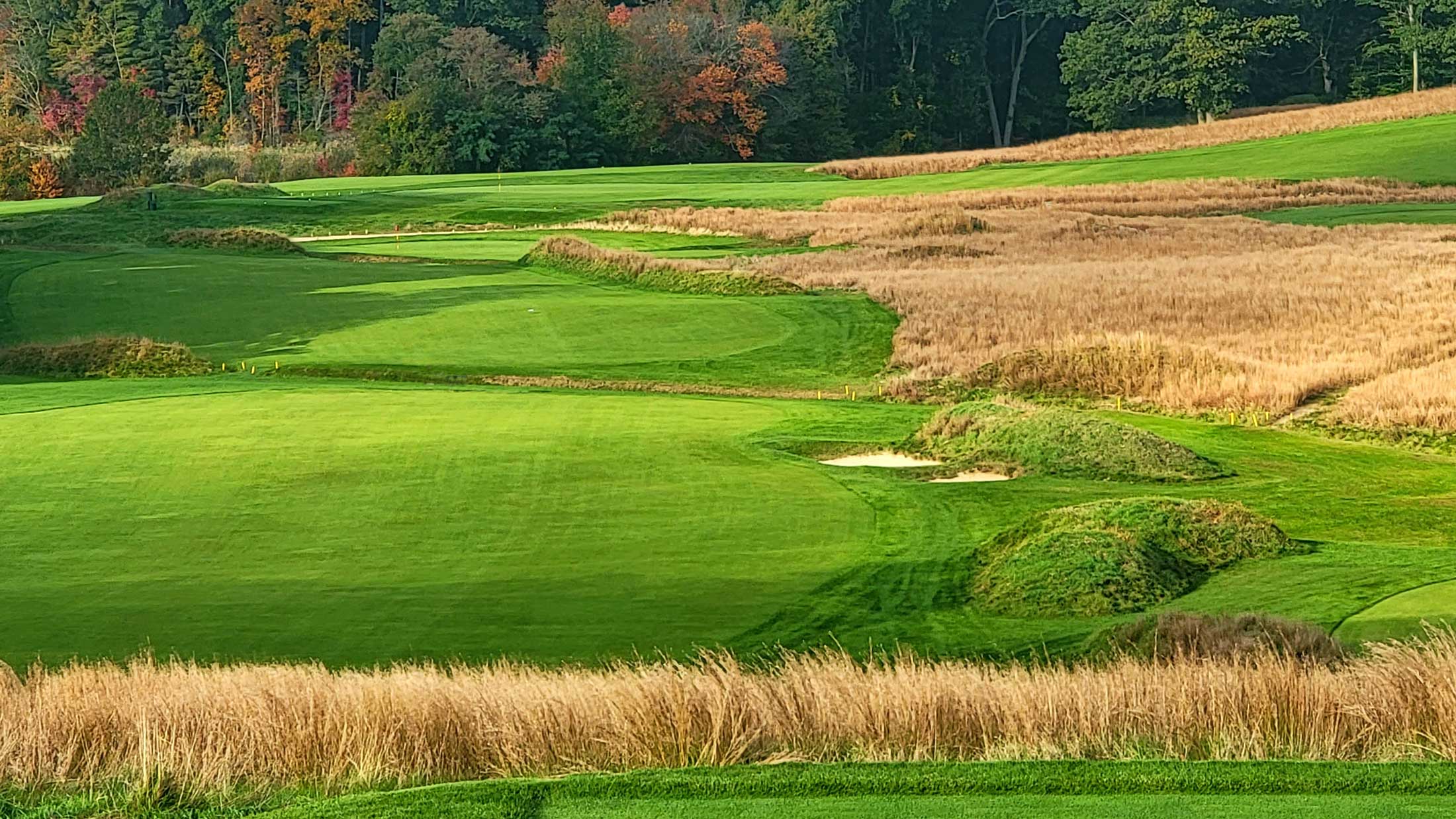
92. Myopia Hunt Club
Some critics of rankings grumble that hosting a major unduly elevates a course. Is that true for Myopia Hunt, given that it has played host to four U.S. Opens? Probably not, given its last one was in 1908! What helped Myopia continue to rise in the list is appreciation for Gil Hanse’s restoration work whereby trees came down, and fairways were expanded/reconnected to Herbert Leeds’s fabulous pit bunkers. The handsome blue stem rough is best admired from a distance but there is no hiding from the severely titled greens at the 4th, 6th and 13th. None of those two-shotters is long but the slopes with which Leeds imbued them about 120 years ago define treachery at modern green speeds. With the wind more evident and the playing surfaces firm, the course’s thorny playing attributes are once again on full display. Fun fact: The winning score at its four U.S. Opens averaged nearly 324, or 81 strokes per round.
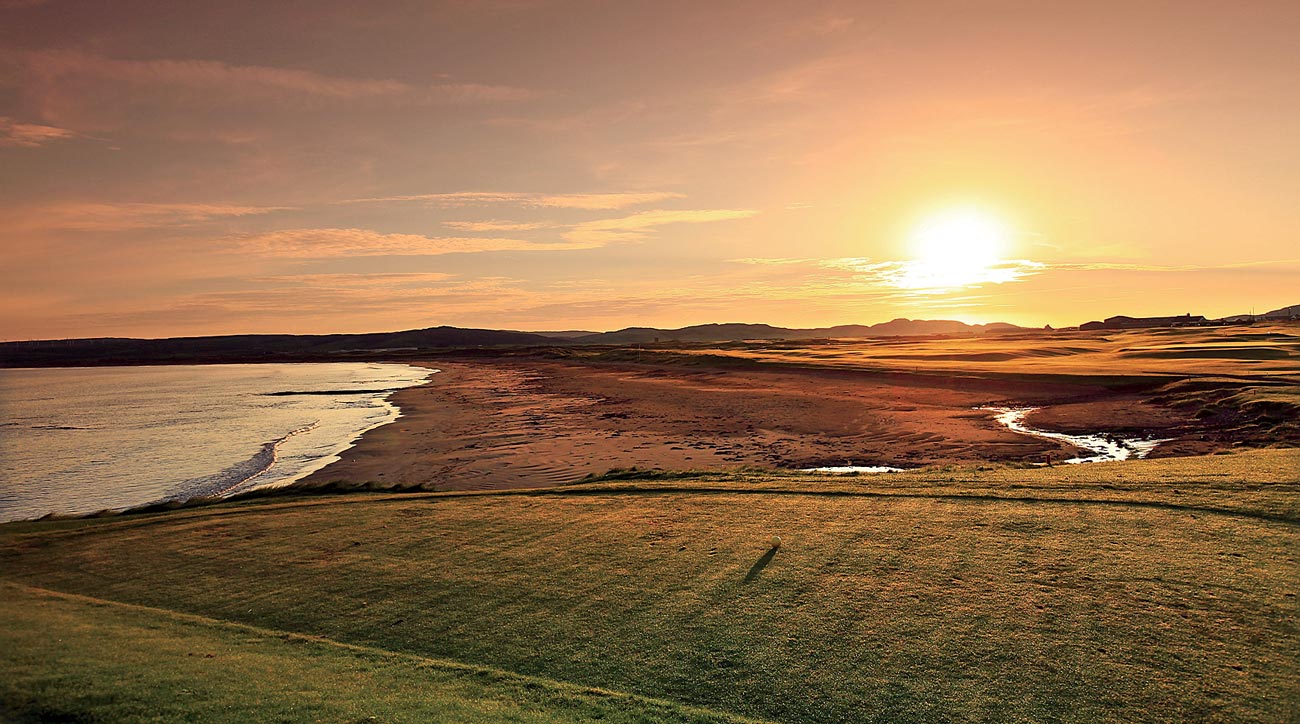
93. Machrihanish
This remote Old Tom Morris design entrances more for its ambience than for its challenge. Known for its enchanting opening hole that demands a drive over the beach, Machrihanish provides a gleeful romp through shaggy sandhills on the front nine. The middle of the back nine has some of the finest green contours of any links. Add it all up — and throw in the Kintyre Peninsula wind — and you have a place that lures people back time and time again. Isn’t that the very measure of design greatness? (Photo: David Cannon/Getty Images)
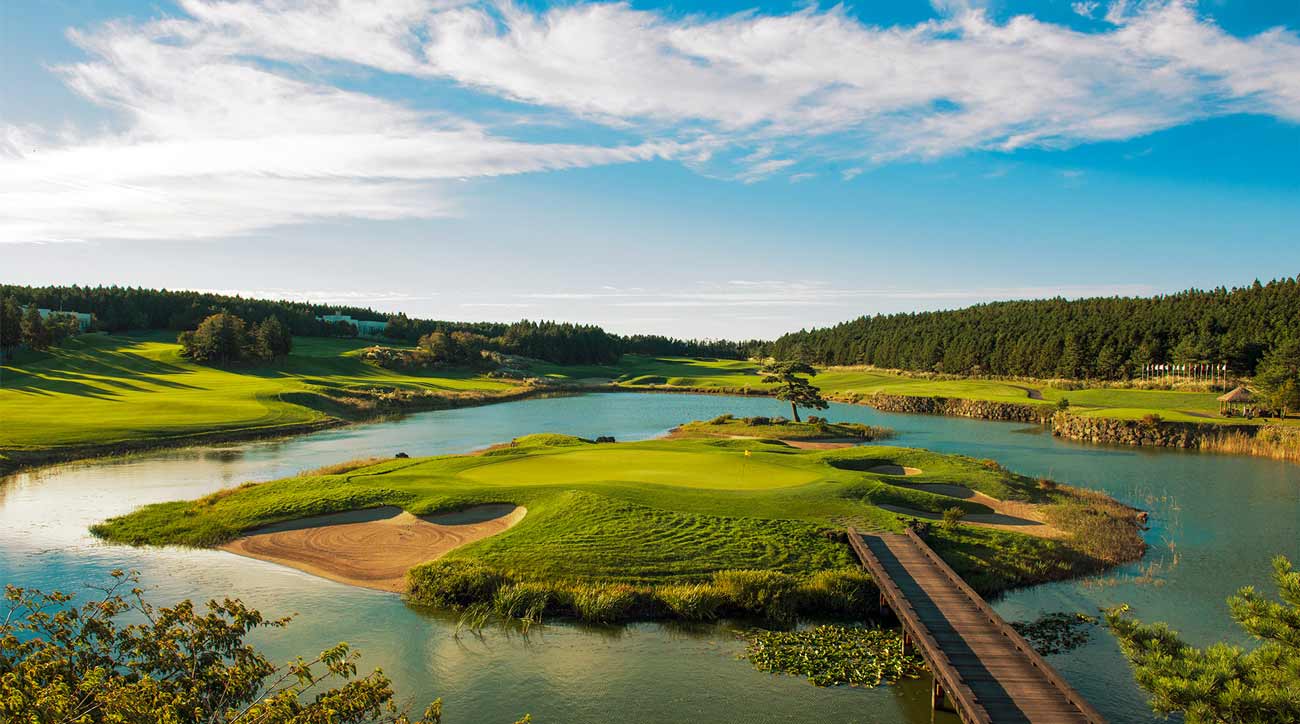
94. Nine Bridges
Nine Bridges’s appeal starts with its tranquil setting on Jeju island, with holes etched into pine-clad rolling topography in the shadows of Mount Halla, Korea’s tallest peak. Lakes, creeks and wooded slopes not only contribute to the beauty and variety but also are seamlessly integrated into the design. When Nine Bridges has played host to the PGA Tour’s CJ Cup, the pro routinely praise both its challenge and presentation. (Photo: Courtesy Nine Bridges)
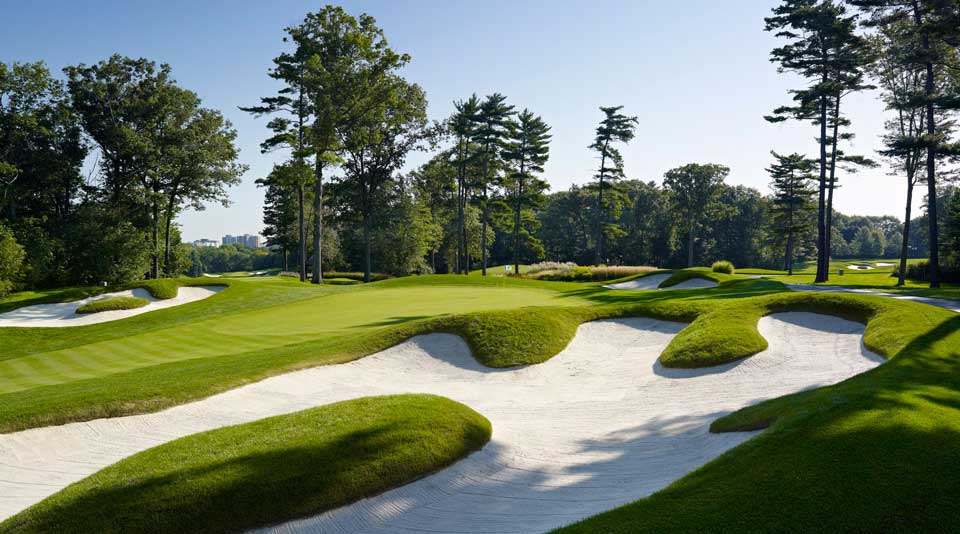
95. St. George's
Preeminent Canadian architect Stanley Thompson hit his professional peak at this quiet club near downtown Toronto. The wonderful rolling parkland terrain is replete with streams and natural valleys, and has been the venue for five Canadian Opens, most recently in 2010. Tom Doak and Ian Andrew spearheaded a restoration that was completed in 2015. (Photo: Clive Barber)
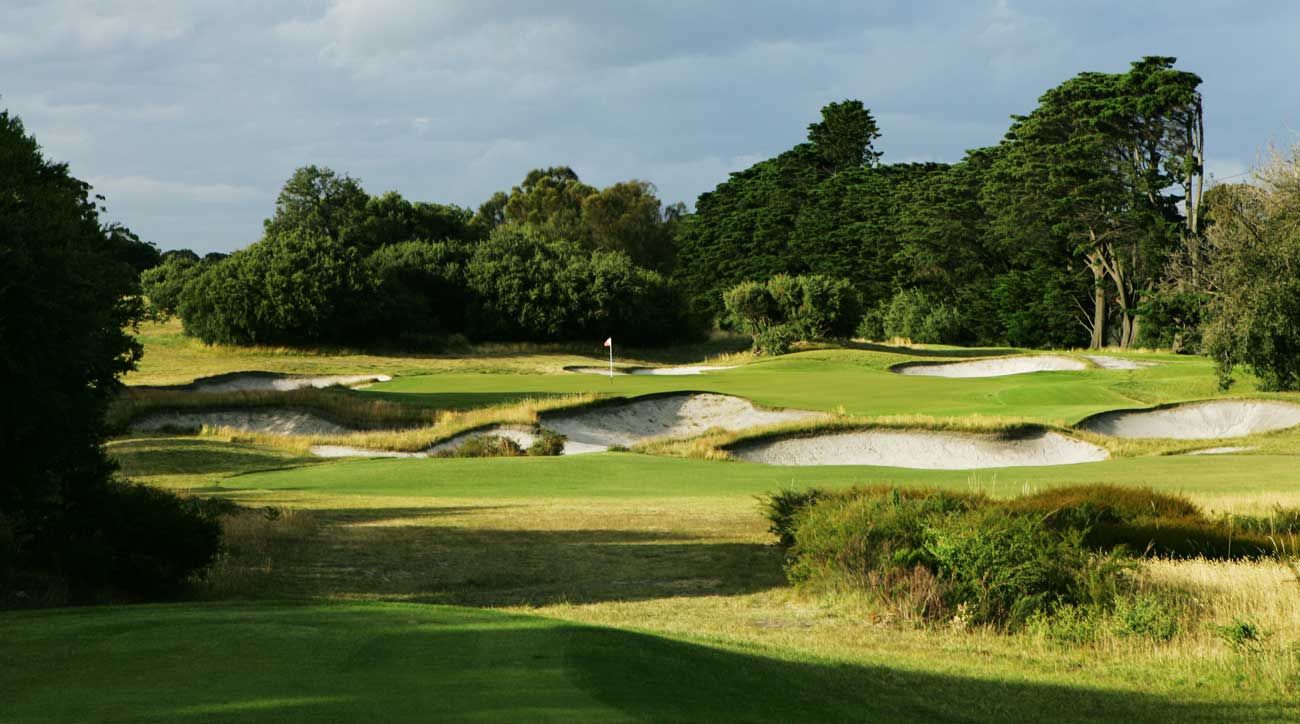
96. Royal Melbourne (East)
Confident in his own work, Alister MacKenzie freely lauded the work of others. In the United States, he considered Perry Maxwell to be as talented as anyone; in Australia, his man was Alex Russell, who deserves full credit for the East Course, in addition to Paraparaumu Beach, Lake Karrinyup and other gems in Australia and New Zealand, including Yarra Yarra. The panel’s appreciation of the East Course raises the question: What is the finest 36-hole day in golf at one location? Winged Foot, Bandon, Sunningdale or here? (Photo: David Cannon/Getty Images)
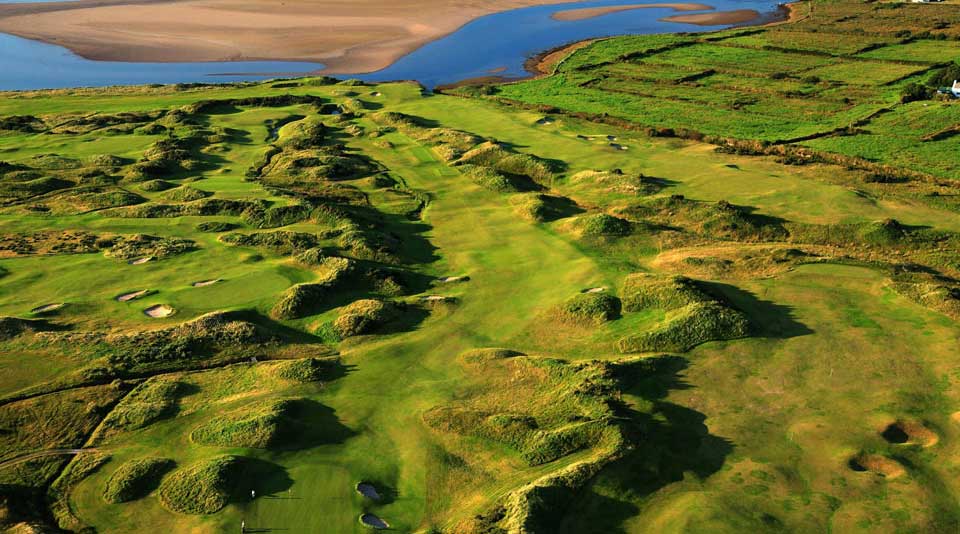
97. Waterville
Waterville’s slithering par-5 11th, hemmed in by dune ridges, and its seaside par-3 17th, with a back tee isolated by dense vegetation and backdropped by MacGillycuddy’s Reeks, are both world class. A 2006 reno by Tom Fazio helped balance the two nines by removing some artificial features and blending new features into the existing dunescape. (Photo: David Cannon/Getty Images)

98. Ohoopee Match Club
Sand accumulated on the east side of the Ohoopee River for centuries. Ultimately, Gil Hanse and Jim Wagner were given this dream site upon which to build an original design. Their own sense of aesthetics complemented the rustic site’s color palette of browns, rusts and tans. The result is a low-profile design that beguiles. Be careful of its short par-4s: the 4th, 9th and 14th all tempt with driver off the tee — and punish rash tactics. The course isn’t overseeded, and the release of the ball across its dormant fairways allows the first-class architecture to shine. It also signifies the owner’s high golf IQ. (Photo: Jon Cavalier)
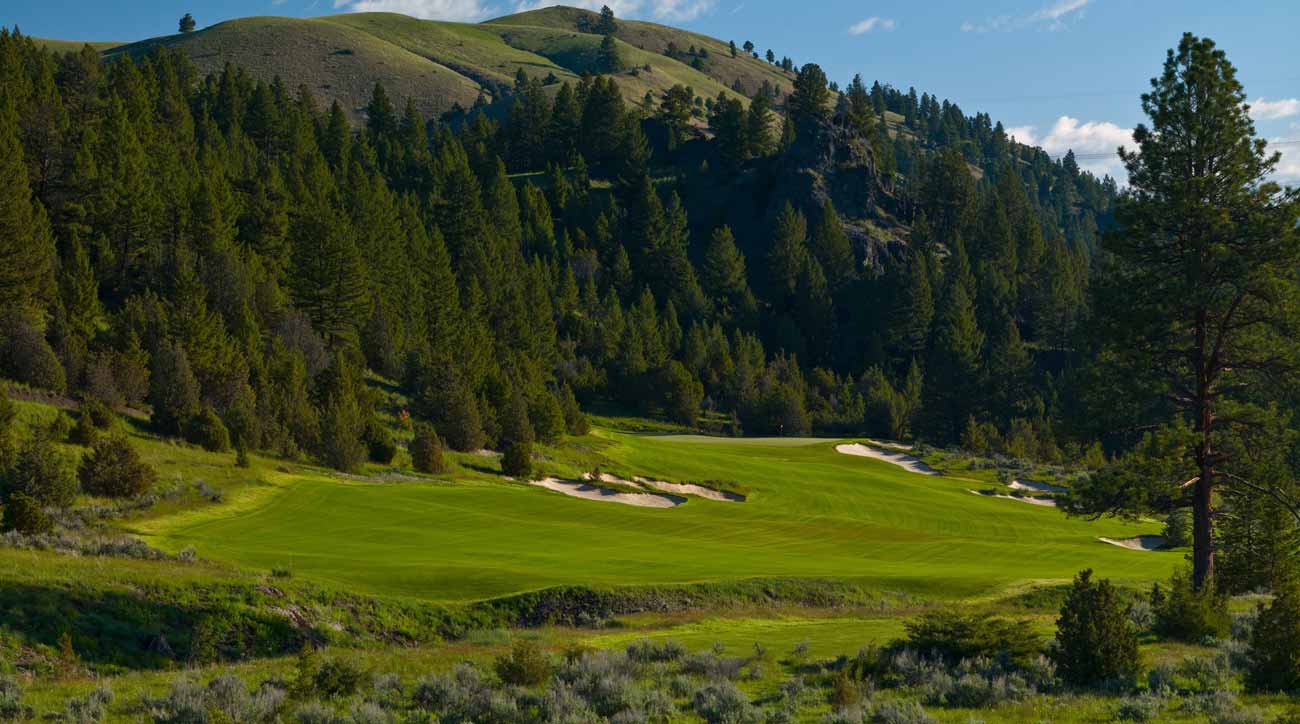
99. Rock Creek Cattle Company
Tom Doak’s works along large bodies of water populate our list but some contend what he did in the American West at Rock Creek is just as exhilarating as his more photographed courses in sandy soil. Though Montana’s rocky conditions made for a tough build, the result is wide fairways that flow over the tumbling land with a grace and ease that is hard to fathom. The same design principles — fairway contours that either shunt you out of position or send you to the ideal location, hazards that appear ageless and greens that offer a wide range of hole locations — demand you reassess how to best play each hole from one day to the next. Hard to find better playing angles. (Photo: LC Lambrecht)
